- Search Please fill out this field.
- Manage Your Subscription
- Give a Gift Subscription
- Newsletters
- Sweepstakes
- Destinations

20 Beautiful Places to Visit in Portugal — From Fairy-tale Castles to Charming Beach Towns
Take your pick of hilltop castles, sunny beaches, and time-worn villages.
Lindsay Cohn is a writer, editor, and avid traveler who has visited 45 countries across six continents — and counting. She contributes to Travel + Leisure, Hotels Above Par, InsideHook, Well+Good, The Zoe Report, and more.
:max_bytes(150000):strip_icc():format(webp)/Lindsay-Cohn-8b22fb2d452f46f5a256755f4d0f42a5.jpeg)
Roberto Moiola/Sysaworld/Getty Images
France and Spain have long taken center stage, with Portugal as a less-visited destination for in-the-know travelers. The tides are slowly turning and the small Iberian nation is, at long last, enjoying its well-deserved moment in the sun. The drawback to this increased attention? More tourists. Though it’s not like contending with a few crowds is going to put anyone off seeing Pena Palace or Jerónimos Monastery. And, of course, there are countless beautiful places to visit in Portugal, from the Azores and Madeira to the sun-splashed Algarve and even popular cities like Lisbon and Porto . This is to say that despite its relatively diminutive size, Portugal offers a treasure trove of natural, historical, and cultural wonders.
Cabo da Roca
Stefano Briccola/EyeEm/Getty Images
The westernmost point in continental Europe, Cabo da Roca exudes a wild, edge-of-the-Earth mystique. Waves crash against the rocks, tourists standing atop sheer cliffs stare out at nothing but blue to the horizon, and a historic lighthouse guides boats sailing along the rugged coast.
Lagoa das Sete Cidades
dangrytsku/Getty Images
The majesty of São Miguel never ceases to amaze. Topping the list for many travelers visiting the volcanic main island in the Azores archipelago are the famous and impossibly photogenic twin crater lakes, Lagoa Azul ("blue lagoon") and Lagoa Verde ("green lagoon").
Pena Palace
chechele/Getty Images
One of the most beautiful places in Europe , Pena Palace is a hilltop Romanticist castle and the crown jewel of Sintra. Its candy-colored facade and sweeping terraces draw shutter-happy tourists from near and far. The stately interiors are filled with antiques, while the surrounding park provides tree-shaded pathways.
Levadas da Madeira
Simon Dannhauer/Getty Images
The Levadas da Madeira is a system of historic irrigation canals built across the island to carry water from the high-altitude slopes to sugar cane fields, farmlands, and cities. Hiking trails that run along the waterways give travelers a close-up look at the UNESCO-listed laurel forests.
Jerónimos Monastery
LUke1138/Getty Images
One of the most-visited landmarks in Lisbon and a UNESCO World Heritage Site, the late Gothic Manueline-style Jerónimos Monastery stands tall as an enduring symbol of power dating back to the Age of Discovery. The block-long complex continues to impress with its magnificent maritime details, cloisters, and tombs.
Algar de Benagil
Bkamprath/Getty Images
This fantastical seaside cave that’s reachable by boat doesn’t even look real. Sun beams in through the hole on the top, bathing the enclosed beach in light, and turquoise waters lap the sand.
Clérigos Church
mtcurado/Getty Images
Clérigos Church is a must-see on any trip to Porto . While the artifacts and organ concerts certainly wow, both are overshadowed by the iconic 75-meter-tall bell tower, which visitors can climb for 360-degree views of the city (and a serious workout).
Christopher Larson/Travel + Leisure
Nazaré lures fearless surfers and attracts many curious tourists thanks to the larger-than-life swells that were the subject of the documentary “100 Foot Wave.” The huge breaks mean you’re likely not going to paddle out, but it’s worth the drive to see the enormous waves crash into the rocks and grab lunch at one of the local restaurants.
Vila Franca Islet
aroxopt/Getty Images
Located off the coast of São Miguel , the Vila Franca Islet looks otherworldly from above and just as pretty up close. The circular saltwater lagoon, which was formed by the crater of an ancient volcano, is ringed by lush vegetation. In the summer, it’s popular for swimming, snorkeling, birdwatching, and cliff diving (if you dare).
LuisPinaPhotogrpahy/Getty Images
Situated about an hour from Lisbon, Comporta is a low-key fishing village turned in-the-know summer hotspot with cork trees, rice fields, and blissful beaches. During the warmer months, it’s well worth vying for a spot on the brilliant white sand of Praia Comporta.
Douro Valley
Colors Hunter - Chasseur de Couleurs/Getty Images
The oldest demarcated wine region in the world and the birthplace of port, Douro Valley wows viticulture enthusiasts and casual sippers. A mix of rolling vineyards, historic quintas, boat rides along its namesake river, and excellent restaurants means there’s plenty to appreciate besides incredible pours.
Peneda-Gerês National Park
Denis Kabanov/Getty Images
Set in northern Portugal near the Spanish border, Peneda-Gerês National Park spans yellow-tinged hills, granite peaks, high-flowing streams, mixed forests, and Roman relics. Native wildlife — including the Pyrenean desman, Iberian frog, and Barrosã cattle — also call this protected land home.
Cachalote Natural Swimming Pools
JoanaCarvalho
The north coast of Madeira brims with beautiful spots to take a dip, none more iconic than Cachalote Natural Swimming Pools . The Mother Nature-made lagoons off the shore of Porto Moniz were formed by volcanic rocks and filled with the tides of the Atlantic Ocean.
Poço da Alagoinha
CarolinaGNP/Getty Images
Majestic waterfalls are one of the many enticements of the Azores. Poço da Alagoinha on the island of Flores is a stunning example with multiple cascades that gush from lush, vegetation-covered cliffs down to a pristine lagoon.
Parque Natural da Arrábida
Americo Lopes/Getty Images
Parque Natural da Arrábida shows off many of Portugal’s best assets. Fine sand beaches fade into blue waters, towering cliffs rise from the sea, verdant vegetation covers the mountain peaks, and scenic hiking trails wind through the spellbinding scenery.
Azenhas do Mar
Igor Tichonow/Getty Images
Of all the charming coastal towns in Portugal, Azenhas do Mar deserves special mention. Small in size, with just 800 inhabitants, whitewashed houses, and commanding sea views, it’s a postcard-worthy setting to sip local wine, savor regional seafood dishes, and swim in the natural rock pool.
Castelo de Guimarães
LuisPortugal/Getty Images
Mystery and legend still swirl around Castelo de Guimarães. A major presence in Portuguese history, the castle was built under the orders of Mumadona Dias in the 10th century to serve as a place of refuge from and protection against attacks perpetrated by Vikings and Moors.
Jamie Ditaranto/Travel + Leisure
Sagres sits on a windswept headland at the western tip of southern Portugal. Sunny skies, dramatic sea cliffs, and uncrowded beaches make this tiny fishing village deserving of a detour. It’s also a surfer’s paradise that provides plenty of both beginner-friendly breaks and expert-level barrels.
Quinta do Barbusano
Tucked away in the mountains on the north side of Madeira, Quinta do Barbusano invites visitors to savor the flavors of the island with wine tastings and traditional espetada (beef skewer) meals overlooking the São Vicente Valley. It’s also possible to do a short hike to nearby Nossa Senhora Fátima Chapel for even more breathtaking vistas.
Livraria Lello
SOPA Images/Contributor/Getty Images
Livraria Lello shows off opulent staircases, an ornate stained-glass ceiling, and towering shelves packed with tomes. Harry Potter fans might notice a connection between the magical interiors of the historic bookstore and some Hogwarts scenes. It’s widely known that J.K. Rowling frequented the shop during her time in Porto.
Related Articles
🙌 Awesome, you're subscribed!
Thanks for subscribing! Look out for your first newsletter in your inbox soon!
Get us in your inbox
Sign up to our newsletter for the latest and greatest from your city and beyond
By entering your email address you agree to our Terms of Use and Privacy Policy and consent to receive emails from Time Out about news, events, offers and partner promotions.
Awesome, you're subscribed!
The best things in life are free.
Sign up for our email to enjoy your city without spending a thing (as well as some options when you’re feeling flush).
Déjà vu! We already have this email. Try another?
Love the mag?
Our newsletter hand-delivers the best bits to your inbox. Sign up to unlock our digital magazines and also receive the latest news, events, offers and partner promotions.
- Los Angeles

The 8 best places to visit in Portugal
There’s so much more to Portugal than its two main cities. Get to know the country’s seven stunning regions
Photograph: Shutterstock
Sure, Lisbon and Porto are great n’ all (no really, they are really great), but Portugal is one of the world’s hottest travel destinations for a reason, and there’s so much more to it then its two main cities. Whether you’re looking for wild parties or wild nature; historic hill towns or sun-scorched beaches; hip bars or rural escapes, you’ll find it in abundance across Portugal’s seven regions – five on the mainland, plus the archipelagos of Madeira and the Azores .
And then there’s the food, which goes well beyond piri-piri chicken and pastéis de nata (although let’s face it, these should be on your list). Each of the country’s surprisingly diverse regions takes pride in its unique culinary offerings, from super-fresh seafood and slow-cooked stews to cakes, pastries and cheeses. And did we mention the vinho ? Across the country, wine is impossibly good and dangerously affordable. There’s a whole lot to discover, so read on for the full lowdown on the best places in Portugal.
RECOMMENDED:
📍 The best things to do in Portugal 🏖 The essential guide to Lisbon 🐟 The essential guide to Porto
Lucy Bryson is a writer based in Portugal. At Time Out, all of our travel guides are written by local writers who know their cities inside out. See our editorial guidelines for more. This guide includes affiliate links, which have no influence on our editorial content. For more information, see our affiliate guidelines .
Been there, done that? Think again, my friend.
The best Portuguese regions to visit
1. northern portugal.

Visit for: Stunning natural landscapes and world-famous wines
Northern Portugal is renowned for its friendly inhabitants and their love of a good party. Tourists rarely venture far beyond the ridiculously picturesque city of Porto (and its equally good-looking sister city of Vila Nova de Gaia on the opposite bank of the Douro), but northern Portugal is also home to the country’s only national park: the wildly beautiful Peneda-Gerês , where wolves roam and villages are carved from ancient stone.
The region is also home to historic cities packed with stunning Baroque architecture – there are particularly fine examples in beautiful Braga and in Guimarães , the city known as ‘the birthplace of Portugal – and gloriously unspoiled river beaches such as the pine-flanked sands of the Praia Fluvial da Lomba, on the banks of the Douro in Gondomar .
Then there are the verdant terraced hills of the Douro wine region, where the Douro International Natural Park further contributes to making this one of the most beautiful and diverse regions in the country – or indeed, the whole of Europe .
2. Central Portugal

Visit for: Fairytale villages and blissful river beaches set at the foot of snow-capped mountains
Refreshingly untroubled by mass tourism, Central Portugal is a treat for adventurous travellers. You can goggle at the monster waves of Nazaré (and the highly-skilled surfers who dare to tackle them), master your own technique at the lively surf town of Peniche , or tackle hilly hiking and cycling trails between schist stone villages where hearty fare like suckling pig and sugary cakes replenish all that spent energy.
Here you’ll find Portugal’s highest peaks – the UNESCO Geopark Serra da Estrela sees enough snow in winter to merit its own ski resort – and the gorgeous, forest-flanked river beaches of the interior make a crowd-free alternative to the lively sandy strips dotted along the 174 miles of coastline. Wine lovers, meanwhile, will revel in the robust reds and citrusy whites of the Dão region.
Urban adventurers have plenty to enjoy too: c enturies-old religious buildings sit alongside buzzing bars and cafes in the handsome university city of Coimbra , while Aveiro (the self-proclaimed ‘Venice of Portugal’) is always impressive with its art nouveau architecture and brightly-painted canal boats.
3. Lisbon

Visit for: Buzzing city life, sandy stretches and a vibrant surf scene
Portugal’s famously sunny capital, Lisbon requires little introduction – its status as one of Europe’s hottest city destinations is richly deserved. But undiscovered treasures still lie among the hipster hubs and Segway-packed streets: you can s pend a day spotting street art in the maze of streets that make up historic Alfama , seek out the hidden Chinese restaurants ( C hinês clandestinos ) operating from family apartments in the multicultural Martim Moniz neighbourhood, and fill up on huge plates at tiny tascas like Merendinho do Arco .
And if you’ve had enough of city life, you’re never more than a short bus or train ride away from glorious beaches and wild nature reserves. Hop on a train along the coastline to the popular beach towns of Cascais and Estoril and the adventurous terrain of Sintra-Cascais Natural Park ; cross the river Tagus for the white sand, turquoise waters and pine-covered mountains of Serra da Arrabida , or take an hour-long bus ride to Ericeira – Europe’s first and only World Surf Reserve – for a laidback vibe and beachy lodgings like You and the Sea and Immerso .
📍 The best things to do in Lisbon
4. Porto

Visit for: A seriously good food scene
Named by us as the best city break in Europe for 2024 , it’s safe to say Porto is one of our absolute faves. And why wouldn’t it be? This city is bursting with great food, galleries, museums and more, and as a bonus, it’s super affordable too.
Sample some seriously good white port (our favourite way is via a Porto tonic; white port, tonic water and a wedge of lemon), buy enough tinned fish for a year’s worth of date nights and people watch at the Douro river.
The best part? A new Time Out Market is set to open this year in Porto, so you can try all our favourite restaurants under one roof. Porto is a classic for a reason.
📍 The most romantic hotels in Porto
5. Alentejo

Visit for: Sleepy traditional villages, fine food and wine, and celeb beach hangouts
Stretching south of Lisbon towards the Algarve, the sun-blessed Alentejo region (the name comes from the words ‘além Tejo’, or ‘beyond the Tejo’) has been quietly carving a reputation for itself as Portugal’s most chic beach destination. High-end boutique hotels offer ‘barefoot luxury’ lodgings in fashion-press favourites Comporta and neighbouring Melides , and the wines produced here are increasingly well regarded internationally.
Exclusive beach hangouts aside, this is one of Portugal’s most traditional and least-explored destinations. There are plenty of charming towns to visit, from historic villages like the medieval Monsaraz to slow-paced fishing spots like Vila Nova de Milfontes . The pretty fishing town of Porto Covo marks the start of the dramatically beautiful Southwest Alentejo and Costa Vicentin Natural Park , which sweeps for 60 miles down to the Algarve and is notable for its surf beaches and multi-hued cliff faces.
Then there’s the region’s highly attractive capital, Évora : as notable for its food scene as its Roman temple and hauntingly impressive Chapel of Bones.
6. Algarve

Visit for: Glorious beaches and picture-perfect fishing villages
Don’t let reports of hordes of lager-swigging ‘Brits abroad’ put you off visiting Portugal’s sunniest region. Not only does the Algarve have a reliably warm climate and some of the most beautiful beaches in the country, but it’s also home to sleepy whitewashed villages – each one seemingly even prettier and more packed with local charm than the last – and all easily reached by a scenic rail journey.
Fresh fish, seafood (and yes, that famously spicy piri-piri chicken) dominate the dining scene, and visitors would be well advised to give the pub grub a body swerve in favour of the local tascas , where you’ll be served a proper feast and a carafe of house wine for a fraction of the price of a fry up and pint of Guinness.
If you’re looking for a big city buzz, you’ll find it in Faro , the region’s lively capital. Want something lively but a little more laid-back? Join the surfer communities of watersports hotspots like Lagos and Sagres .
7. Madeira

Visit for: Warm waters, jaw-dropping views and year-round sunshine
Nobody has ever accused Cristiano Ronaldo of hiding his light under a bushel, and the football legend’s home turf of Madeira really goes the extra mile in celebrating the success of its most famous son – even the airport in the regional capital Funchal is named in his honour. More of a Messi fan? You can bypass the Ronaldo museum, Ronaldo statue, and CR7 hotel, and just revel in Madeira’s breathtaking terraced mountains, sunny sub-tropical climate, year-round warm waters, and vibrantly-hued flowers.
An hour’s flight from the mainland, this archipelago in the North Atlantic is one of Portugal’s two Autonomous Regions. Its volcanic geography makes it a top destination for adventure sports enthusiasts: its towering peaks host a a spectacular Sky Race ultramarathon, featuring 34 miles of gruelling ascents and daring descents across 4,000 metres of elevation.
Mere mortals can bypass the running and enjoy the thrills and spills of Funchal ’s toboggan run: whizzing down city streets in wicker baskets for a mile of fast-paced twists and turns. Finish off your adventures with a glass of poncha : the island’s boozy, fruity punch.
8. Azores

Visit for: Outdoor adventures, relaxing retreats and a chance to explore wild, untamed nature
An increased number of budget flights have brought tourist traffic to the weather-beaten Azores , but the nine-island archipelago in the middle of the Atlantic Ocean remains relatively under the radar.
Each of the islands has its own character, from the sandy beaches and mild climate of Santa Maria to the volcanic lakes and thermal springs of São Miguel . The Portuguese-owned islands are the perfect place to take a mindful break at destinations like Lava Homes , a wellness-focused ‘village’ carved from volcanic rock on Pico .
The islands are also increasingly talked about among foodies: in particular, the cheeses are a must-try, such as the sharp queijo da ilha from São Jorge , and the mild, creamy queijo vaquinha from Terceira . The Azores’ unique volcanic wines are something to savour too; visitors can find out about the fascinating production process (and taste the resulting wines) at Biscoitos Wine Museum on Terceira .
[image] [title]
Discover Time Out original video
- Press office
- Investor relations
- Work for Time Out
- Editorial guidelines
- Privacy notice
- Do not sell my information
- Cookie policy
- Accessibility statement
- Terms of use
- Modern slavery statement
- Manage cookies
- Advertising
- Time Out Market
10 of the best things to do in Portugal

Jan 22, 2024 • 7 min read
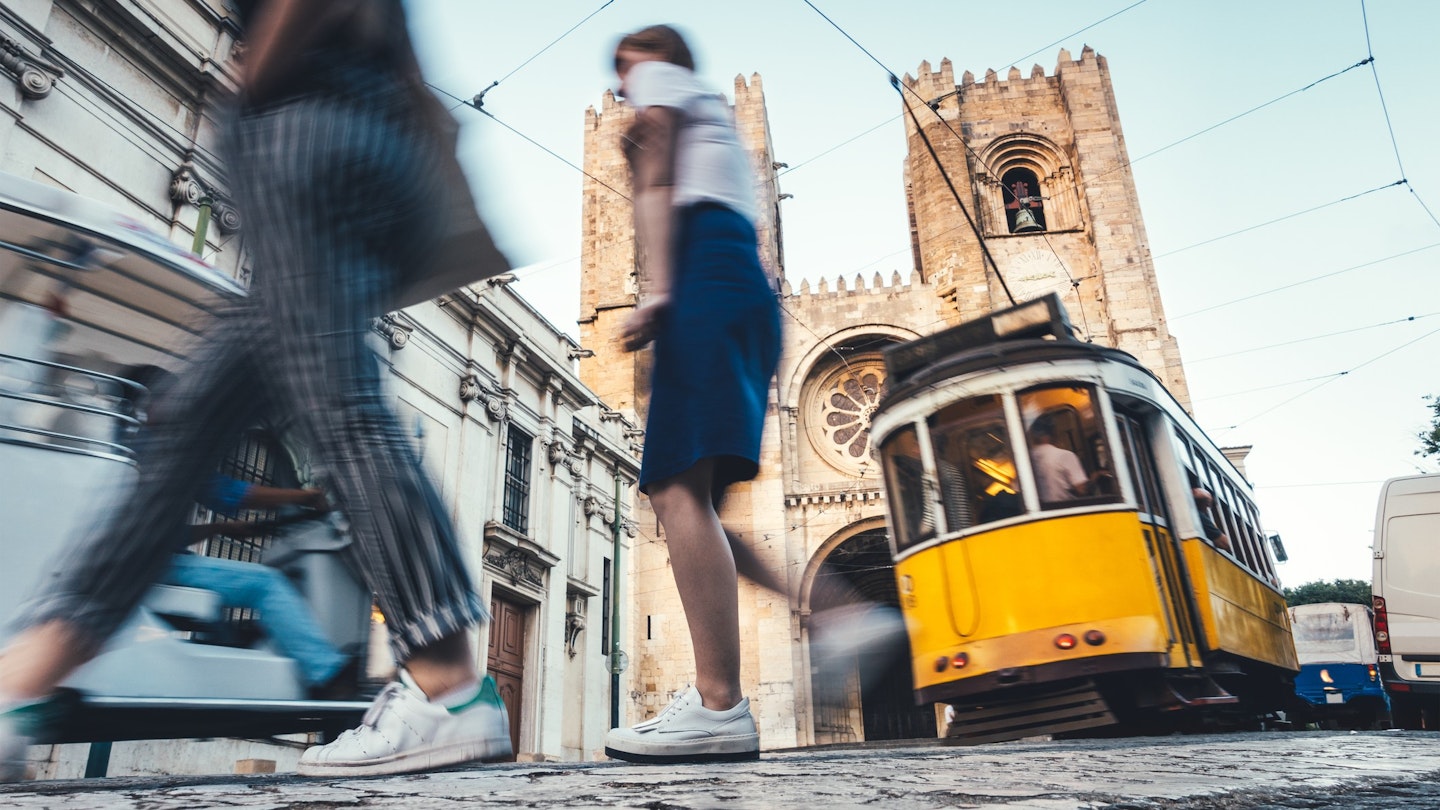
Here's how to experience the best of Portugal © borchee / Getty Images
Nestled between Spain and the Atlantic Ocean, Portugal is a compact country that you could fit into a two-week road trip .
Contrasting with its small size is the country's diverse culture, cuisine and landscapes that range from the rugged coast in the west to the mountainous inland and from the cool and lush north to the flat and sunny south. Ancient Roman, Celtic and Islamic influences have shaped the customs and language of this land that's officially been a country for more than 870 years – one of the oldest in the world.
This list of the best things to do in Portugal caters to foodies, outdoorsy adventure seekers, culture and history buffs , and travelers who want to take it all in at once, hopping from one must-see to the next.

1. Listen to a live fado performance in Lisbon
Fado, a musical genre started in Portugal that's on UNESCO's Intangible Cultural Heritage of Humanity list, envelops listeners in melancholic, sorrowful and heartfelt music. Slow, lingering songs are sung to the sound of guitarra Portuguesa (Portuguese guitar) and other string instruments.
To experience it for yourself, head to a casa de fado in Lisbon . Popular options include Parreirinha de Alfama or A Baiuca in Alfama and Adega Machado or Café Luso in Bairro Alto . Whichever you choose, all offer a chance to see a live performance, and some even pair the music with a traditional Portuguese dinner.
Planning tip: For more range and diversity, visit Lisbon in late September to attend Santa Casa Alfama, the two-day music festival dedicated entirely to fado.
2. See prehistoric rock art at Vale do Côa
A UNESCO World Heritage site since 1998, the prehistoric rock art site in Vale do Côa , together with nearby Siega Verde in Spain, is the most noteworthy Paleolithic art site in the Iberian Peninsula.
Planning tip: Head to the Museu do Côa first before joining a guided tour of the archaeological site and open-air rock art gallery, which includes more than 1000 rock engravings from the Paleolithic and Iron Age periods scattered around 80 identified sites.

3. Indulge in conventual sweets
Egg yolks, sugar and occasionally almonds are the core ingredients of typical Portuguese pastries known as conventual sweets. Cloistered nuns and monks (hence the name "conventual") created these concoctions, making use of extra egg yolks (the whites were exported and used in winemaking) and newly imported sugar from Brazil in the 15th century, and they were initially for the monastery residents' consumption. But in the 19th century, when religious orders were all to be dissolved, these sweet creations became their only source of income as convents and monasteries were forced to stop taking in novices.
Each region of Portugal has its traditional conventual sweet, with some local or seasonal ingredients thrown in the mix, such as beans in the pastel de feijão in Torres Vedras or the paper-thin, wafer-encased ovos moles in Aveiro . Pastel de nata custard tarts are Lisbon's most famous conventual sweet and also the one that's seen the most variations, including vegan alternatives.
4. Party at Santos Populares , local saints' festivals
Traditional or popular saints' festivities ( Santos Populares ) happen all over Portugal in June, but St Anthony's in Lisbon (on June 13) and St John's in Porto (on June 24) are the best-known. In these cities' historical neighborhoods, locals hang colorful ribbons across the narrow cobblestoned streets and set up charcoal grills to cook sardines and pork steaks, preferably washed down with a cold local beer or house wine. These festivals started as a way to honor the communities' patron saints, but nowadays, it's the perfect excuse to meet local residents, share a meal and dance the night away.

5. Surf (or watch) the giant waves in Nazaré
The giant Atlantic waves that roll in during Nazaré's rough winters were no secret to local surfers and fishers, but when North American surfer Garrett McNamara established a new World Record by riding a 24m (78ft) wave in 2011, the former fishing village on Portugal's west coast jumped to international fame. Giant wave surfing has become one of Nazaré's calling cards, and the view from the lighthouse of São Miguel Arcanjo Fort is one of the most photographed in town.
6. Stargaze at Great Lake Alqueva
With cloudless skies most of the year and little light pollution, the artificial Great Lake Alqueva in Alentejo is one of Portugal's most perfect spots for stargazing. These extraordinary conditions made the lake the first official starlight tourism destination in the world, as certified by Spanish-based Fundación Starlight. Several local companies offer stargazing and nighttime tours of the lake, and budding astronomers can also visit the observatory .
Planning tip: Prebooking is required, although admission is free for kids under eight, with scheduled starry observations happening during the day or at night.

7. Celebrate Carnaval
For three days before Ash Wednesday, in February or early March, kids and grownups dress up in costumes and participate in Carnaval parades and celebrations happening all over Portugal. Carnaval is often referred to locally as the Portuguese version of Halloween. The first celebrations can be traced back to the 13th century when some of ancient Rome's pagan festivities were appropriated by the Catholic Church. Nearly every town around Portugal hosts a Carnaval parade on Fat Tuesday (the last day of Carnaval), but some are more iconic than others. Torres Vedras, Ovar and Loulé are home to the best Carnaval celebrations, and they mix local traditions with Brazilian-inspired samba parades.
Planning tip: Can't be there for Fat Tuesday? There's an alternative. In Podence, a small village in Portugal's northwest, Carnaval is celebrated differently from the rest of the country – here, it's a unique end-of-winter celebration that inherited the pagan traditions of former Celtic settlers and is part of UNESCO's Intangible Cultural Heritage list. Villagers take part in the Caretos (masked men) parade, and they cover their faces with handmade tin or leather masks depicting a demon-like figure and wear cowbells around their waists.
8. Stay in a traditional schist village
Once located at the crossroads of important commercial routes, the mountain villages between Coimbra and Castelo Branco were practically deserted in the mid-20th century as locals migrated elsewhere in Europe. The dark schist stones used to build the houses were not only unique to the center of Portugal but also became one of the region's calling cards.
To revive this piece of the country's cultural and heritage legacy, the Aldeias do Xisto project was born, transforming 27 villages into rural tourism areas surrounded by rugged mountains, lakes and riverine beaches. The black-stone houses' traditional design was kept to honor and maintain the region's cultural identity.
Planning tip: From nature hikes and wellness retreats to traditional cuisine tastings, book your local experiences at these villages in advance.

9. Taste Portuguese wine
Portugal is home to the well-known wine regions of Alentejo (which produces bold and hearty reds) and Douro (the home of port), but you can find wineries and vineyards practically all over the country, including on the Azores and Madeira archipelagoes.
Planning tip: The region of Vinho Verde (meaning young wine) in Minho produces unique wine from indigenous grape varietals, making it the most authentically Portuguese wine of all. One of the best wineries in the region to taste these fresh, fruity and floral wines (red or white) is Quinta da Aveleda .
10. Road trip on Estrada Nacional 2
Connecting Chaves in the north to Faro in the south, the picturesque Estrada Nacional 2 is a 740km (460-mile) stretch of road that shows road-trippers the kind of Portugal they'd miss if they stuck to highways and freeways. Dubbed the "Portuguese Route 66," the secondary N2 road is seeing a touristic revival as locals are rediscovering Portugal's longest road.
Witness the change of scenery as you drive, from the twists and turns of the road as it cuts through the mountains in Portugal's north and center to the almost-treeless plains of Alentejo and the golden sand beaches of the Algarve . Take time to visit landmarks along the way or stay for a little longer in each town, experiencing community life and local cuisine. Be adventurous and see where the road takes you, or follow one of two pre-designed routes: one dedicated to castles and the other to museums .
This article was first published Oct 27, 2021 and updated Jan 22, 2024.
Explore related stories

May 17, 2024 • 6 min read
Music, art, history and culture are interwoven into the fabric of Portugal – a destination with something for everyone

Mar 25, 2024 • 6 min read

Feb 24, 2024 • 9 min read

Nov 1, 2023 • 15 min read

May 9, 2023 • 4 min read

Mar 15, 2023 • 5 min read

Jan 22, 2023 • 11 min read
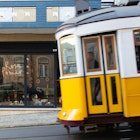
Jan 19, 2023 • 4 min read

May 30, 2022 • 2 min read

Jan 10, 2020 • 5 min read
Wander-Lush
22 Most Beautiful Places in Portugal: The Ultimate List
From the historic cities of Lisbon and Porto to the tiny cobbled villages of the north, the vast wine region to the wild Atlantic coast, there is certainly no shortage of beautiful places in Portugal to capture travellers’ imaginations.
This list brings together 22 of the prettiest places in Portugal , each totally distinct but all renowned for their history, charms, scenery, and above all good looks.
If I’ve missed your favourite, please let me know in the comments at the end!
- Also read: 28 things to do in Portugal – from hot springs to tile hunting
Please note: This post contains affiliate links, meaning I may earn a commission if you make a purchase by clicking a link (at no extra cost to you). Learn more.
How to see these beautiful places in Portugal
Most of the destinations mentioned here can be easily accessed by train or bus (I’ve included brief details for each one below). But to see more of the country, I highly recommend renting a car and setting off on a Portugal road trip.
As with a Spain road trip , driving in Portugal will give you freedom to explore harder-to-reach areas and stay at more remote, unique accommodations including quintas (farmhouses).
I personally use Discover Cars to find the best rate on a rental car whenever I’m in Europe. Click here to browse their offerings and choose from pickup locations all over mainland Portugal and in the Azores.
22 most beautiful places in Portugal you have to visit

The capital city of Lisbon rightly tops just about every traveller’s Portugal bucket list. One of the prettiest cities in Portugal and in the whole of Europe, Lisbon is a mosaic of winding streets, open plazas, stunning churches and miradouro lookouts waiting to be discovered.
There’s beauty around every corner in Lisbon, whether it’s the slightly ramshackle kind of glamour you find in historic Alfama, the paradisiacal beauty of the Tagus River, or the grand charm of landmarks such as the Tower of Belem, one of the oldest of Portugal’s 17 UNESCO World Heritage Sites.
Despite welcoming more and more visitors every year, Lisbon remains an affordable destination. From browsing the racks at the oldest bookshop in the world for the perfect souvenir , to chowing down on Pasteis de Belem custard tarts, or bar hopping in the trendy Bairro Alto, there’s never a dull moment when visiting this vibrant place .
Get there: Fly into Lisbon Portela Airport or take the train from Porto (4 hours). Where to stay: For a truly local stay, check out my list of the best Lisbon Airbnbs .
2. Sintra – one of the prettiest places in Portugal

The charming town of Sintra is nestled in the pine-covered hills of the Serra de Sintra mountains west of Lisbon. This is where every tourist comes to live out their fantasy of wandering through a fairytale.
The area is best-known for its collection of castles, most notably the colourful Palácio Nacional da Pena (Pena Palace) and the more classical Quinta da Regaleira. One of the most distinct palaces anywhere in Europe, Pena especially can’t be missed.
Pretty as it is, there’s a more serious history behind Sinta, including tales of how the nobility were forced to flee on the eve of the country’s bloody revolution. The Initiation Well at the Quinta da Regaleira – a deep hole that resembles an inverted tower – has a dark side too: The design is said to reflect Dante’s nine circles of Hell.
Get there: Sintra is located 30km (19 miles) from Lisbon and can be reached by train within 40 minutes, making it an ideal day trip destination from the capital. Guided day trip: This 5-hour small group tour of Sintra includes hotel transfers from Lisbon. Where to stay: Chalet Saudade is a historic 19th-century property in Sintra with gorgeous period finishings and scenic views.
3. The Algarve

The Algarve is home to some of the most beautiful sandy beaches in Portugal and what is surely the country’s most dramatically beautiful stretch of coastline.
From the charming streets of old town of Lagos to the cliffy Ponta da Piedade, with its natural sea arches and rock formations that frame picture-perfect Atlantic ocean views, The Algarve may be popular, but there’s a good reason for that.
The beach region and its four major towns draw thick summer crowds, especially in July and August. For those looking to get away from the tourist hordes, there are some stunning secluded beaches to be found – as long as you’re prepared to do some off-track walking.
Get there: Fly into Faro Airport, or take a fast train from Lisbon (3 hours travel time). Where to stay: Refer to my write up of the most beautiful beaches in Portugal for a selection of amazing villas and beachfront apartments in Lagos.

Located inland from Faro and Portugal’s Algarve coast, the tiny town of Estoi is a bit of a hidden gem. Its biggest attraction is the restored Palácio do Visconde de Estoi, a 19th-century palace with a pretty pink Rococo facade.
Not all that long ago, the palace was in tatters after lying abandoned for several decades. It was recently renovated and relaunched as a Pousada (a luxury historic hotel). The sprawling manicured gardens that surround the palace also received a facelift and today, you can enjoy a stroll here beneath the palm trees, drinking in one of the most romantic buildings in Portugal in all her glory.
Also in Estoi, don’t miss the Roman Ruins of Milreu, which are located a short walk from the palace. Here you can view the remains of an opulent Ancient Roman villa – replete with vivid mosaics and columns – that archaeologists have dated back to the 2nd century AD.
Estoi itself is a typical Algarvian town with tightly woven cobbled streets, whitewashed houses fringed with pastel accents, and creeping bougainvillea trees. The local, laid-back vibe (and lack of tourists) makes Estoi a terrific place to retreat from the crowded coast for a couple of hours.
Get there: Estoi is located 15 minutes by road from Faro. To get there, you can take a taxi or a local bus from anywhere on the Algarve. Where to stay: For an unforgettable experience, stay at the Pousada Palacio de Estoi , a Small Luxury Hotel of the World. For something more affordable, Casa de Estoi is a family home from the 1900s-turned boutique hotel.

Located in central Portugal’s Oeste region, Obidos is considered by many to be the country’s finest example of a traditional Portuguese walled town. With a history that dates back to Paleolithic times, Obidos has been shaped by centuries of Phoenecian, Roman and Moorish influence.
As soon as you enter through the Porta da Vila, the tiled gateway to Obidos, you know you’re in for a treat. The cobbled streets of the historic centre rise and fall with the gently undulating hills the town is built atop, leading you through clusters of sweet whitewashed houses that huddle together under shared slate roofs.
Sawtooth fortified walls loom in the background, enveloping Obidos like a shining jewel in the palm of a great, rocky hand. The imposing limestone-and-marble Obidos Castle has been turned into a Pousada, offering anyone who overnights in the plush rooms an unforgettable experience. In July, the annual Óbidos Medieval Market takes over the Old Arms Square, which was once used as a training ground for the king’s squires and knights.
There’s little doubt that this is one of the most beautiful towns in Portugal. It’s recommended to stay at least one night so you can explore the streets after the day-trip crowds have departed.
Get there: Obidos is located 85km (53 miles) or roughly 1.5 hours by road north of Lisbon. To get there, take a taxi or opt for a local train (2.5 hours travel time). Guided day trip: This popular 8-hour day trip from Lisbon visits Obidos, Nazare and the Catholic shrine of Fatima. Where to stay: For a totally unique stay, The Literary Man Obidos Hotel is the world’s largest literary hotel. Located inside a former convent next to Obidos Castle, it features a cocktail bar and a huge collection of antique books.
6. The Douro Valley – Portugal’s premier wine region

Named for the mighty Douro River that cuts across the Iberian Peninsular, the Douro Valley has become one of the most coveted destinations in Europe for wine lovers in recent years.
This exquisite landscape east of Porto – a UNESCO World Heritage Site – includes Barca de Alva, one of the oldest wine regions in the world. Grapes have been cultivated on these steep banks and billowy plains for centuries, and the area’s viniculture heritage flavours everything – from the beautiful tiled railway station at Pinhao which bears elaborate vine designs, to the old rabelo boats, traditional vessels used for carrying wine from farms to the mouth of the river, that still cut across the water.
Wine tastings are available at dozens of cellar doors and in Vila Nova de Gaia, you can visit the lodges where Port wine is fortified.
Apart from wine tourism, Douro Valley promises visitors some of Portugal’s most stunning natural landscapes. Like Port wine, it’s best to sip on the views slowly, ideally while seated on a train chugging along the iconic Douro railway line.
Get there: Peso da Régua makes a convenient base when exploring the Douro Valley. To get there, drive from Porto (1.5-2 hours travel time) or take a local train (2 hours travel time). Guided day trip: This day trip includes transfers from Porto to the Douro Valley where you’ll tour two vineyards, either as a small group or in private, enjoy a traditional Portuguese lunch, and end the day with a scenic river cruise. Where to stay: Check out this list of the best hotels and quintas (farmhouses) in Peso da Régua and elsewhere in the Douro Valley.
7. Porto – one of the most beautiful cities in Portugal

Portugal’s second-largest city may at first seem to resemble Lisbon in many ways, particularly in the architecture, riverside profile and hilly streets. A great alternative to the capital , Porto is a cultural beacon that shines just as bright and has just as much to offer visitors.
One of the most beautiful sections of Porto is the riverside, where rows and rows of houses bejewelled with Azulejos tiles sit pressed together. Get an overview of the city on a Rabelo boat trip before wandering the plazas and streets on foot, stopping off every now and then for a spot of Fado music and a libation at one of the many Port wine cellars.
Porto’s gardens, medieval castles, cathedrals and palaces are many and varied, each pretty in its own way.
Get there: Fly into Francisco Sá Carneiro Airport or take the train from Lisbon (4 hours). Where to stay: Torel Palace Porto is the perfect choice for the visitor who wants to immerse themselves in Old Porto’s charms. The heritage property is decked out with antique trouvailles and even features an outdoor pool. The location 800m from City Market Bolhao is ideal for sightseeing.

A municipality within the District of Lisbon, Cascais is a coastal settlement comprising cute towns hemmed in by a striking coastline of cliffs and sea arches. Spots like the Boca do Inferno bear a resemblance to the rugged formations around Lagos on Southern Portugal’s Algarve .
Cascais was made popular in the 1870s when King Louis I of Portugal chose this spot as his summer retreat. The area still has a feel of old-world glamour and elegance about it, especially in the stunning palaces that dot the coastline. There are no fewer than 17 beaches in the area as well, some suitable for swimming.
One of the most beautiful spots in Cascais is the City Hall Square, which is adorned with typical Portuguese black-and-white paving in a mind-bending pattern that emulates rolling waves. Interestingly, you can see the exact same design a world away in Macau , a former Portuguese colony.
Get there: Cascais is located just 35km (22 miles) from Lisbon, on the coast close to Sintra. To get there, take a local train (1 hour travel time). Guided day trip: This full-day trip from Lisbon to the coast pairs Cascais and the stunning Cabo da Roca coastline with a visit to the nearby Pena Palace in Sintra. Perfect if you’re on a tight timeline. Where to stay: Perched on a cliff overlooking the Estoril coastline and Cascais Bay, The Albatroz is a charming 5-star unit with a sea-view swimming pool and sun-drenched terrace.
9. Madeira – a wild beauty in Portugal

When it comes to natural beauty, there are few places in the world that rival Madeira. Portugal’s four-island archipelago is the star of the North Atlantic and a cornucopia of wild, ruggedly beautiful landscapes.
The largest island, Madeira, offers visitors the chance to sample everything this remote part of Portugal is famed for in one convenient location. Starting at Funchal, wander the exquisite harbour gardens and sample local wines at the Madeira cellars.
The best way to explore Madeira is by car. Circumnavigate the island, stopping to wander the narrow streets of the various fishing villages, soak in the lava pools in Porto Moniz, and spot whales and dolphins in the clear waters off the southern coast (best from April to October).
Remember to venture inland to the vast Natural Park, where easy trails guide visitors around the prehistoric Laurisilva of Madeira forest. The island is crowned with the ominous Pico do Arieiro, a volcanic peak that rises high above the clouds.
Get there: Fly into Funchal Airport (1.75-hour flight from Lisbon or 2-hour flight from Porto). Guided option: No car? Join an Around The Island 2-day trip to see the best of Madeira in 48 hours. Where to stay: If you want to stay close to the action within easy reach of the island’s best restaurants, Funchal is your best bet. ARTS IN Hotel Conde Carvalhal is a restored Madeiran mansion within walking distance of the Old Town with sea views.
10. Coimbra

The ancient city of Coimbra, home to one of Portugal’s oldest institutions, Coimbra University, served as the country’s medieval capital for over two-hundred years and birthed no fewer than six monarchs. Elegant, learned and classically beautiful, it’s more than worthy of a spot on your Portugal itinerary if your travels are taking you to the northern regions.
Coimbra has a large student population and a colourful cafe and nightlife scene as a result. The historic university complex – which has been around in one form or another since the 1200s – adds to the heritage charm. Be sure to take a walk around the university’s Jardim Botânico, one of the oldest and most important botanical gardens in the country.
Then there is Coimbra’s ancient aspect, attached to the city’s Gothic structures and Moorish fortifications to which many tales and legends are attributed. Enjoy an authentic Portuguese dinner and watch an intimate Fado performance before strolling through Coimbra at night – lit up by candle-like lights against an inky blue sky, the city takes on a whole other kind of surreal beauty.
Get there: Fly into Coimbra Airport or take a train from Porto (2 hours travel time). Guided day trip: For an intimate experience, this full-day tour from Porto includes a walking tour of Coimbra and a visit to the sacred pilgrimage site at Fatima. Where to stay: Trendy Sapientia Boutique Hotel is located 1.5km from the university and features gorgeous designer rooms, an onsite bar and restaurant, and a spectacular rooftop terrace overlooking Coimbra.

Often called ‘The Venice of Portugal’, Aveiro is located on the coast south of Porto. Like the Italian city, Aveiro has a lagoon (the Ria de Aveiro) and a network of canals that serve as water highways not for vaporettos , but for Portugal’s own colourful boats known as Barcos Moliceiros . Traditionally these vessels were used to harvest seaweed. These days, captains are used to transporting other types of precious cargo, including tourists!
Parts of the Aveiro lagoon are ringed by stout, square Art Nouveau buildings painted in a rainbow of pastels. Paired with the colourful boats and palm trees, it’s quite a sight to behold indeed.
Aveiro is located close to the coast and the iconic fishermen’s houses at nearby Costa Nova – more on those later.
Get there: Aveiro is located 75km (47 miles) south of Porto, making it a convenient day trip from Porto. To get there, take a local train (40 minutes travel time) or join a guided day trip. Guided day trip: This half-day trip from Porto includes hotel transfers and a trip on a traditional boat to see the best of Aveiro. Where to stay: Aveiro 5 Estrelas Palace is a comfortable self-contained apartment with easy access to both the historic city centre and nearby hiking trails.
12. The Azores

The autonomous region of Azores is made up of nine islands located off the coast of Portugal and North Africa. Known for their dramatic landscapes and outdoor activities, the Azores serve as a dedicated destination for nature tourism.
Each of the nine islands – spread over 600km from Corvo to Santa Maria – is of volcanic origin. Extinct craters and basin-like lakes, towering waterfalls and hiking paths set atop verdant ridges are some of the most recognisable landscapes associated with the Azores.
Activities on offer range from whale watching and diving to canoeing and kayaking. You can hike inside the volcanoes or explore the islands by car. Sao Miguel, the biggest and most beautiful Azores island, also features several pretty whitewashed towns. It’s main city, Ponta Delgada, is a great place to base your explorations.
Get there: Fly into João Paulo II Airport on the island of São Miguel (2.5-hour flight from Lisbon or Porto). Where to stay: On Sao Miguel, Furnas Boutique Hotel is located in Vale das Furnas – home to one of the largest concentrations of thermal waters anywhere in Europe – and features a natural spring spa alongside luxe rooms.
13. Sortelha – one of the most beautiful villages in Portugal

Seated in the foothills at an elevation 760 metres and completely surrounded by formidable fortress walls, Sortelha has managed to retain its medieval appearance until this today. A series of castles built across the borders of Sortelha provide a clue as to this area’s strategic importance to defend the border east of Guarda.
The entrance to Sortelha is via a Gothic gateway. Gaze up at the balcony from where projectiles were hurled at those who dared to attack the village. Inside, streets, plazas, houses and the castle all conform to a similar shade of stone – a strategic decision that adds to the town’s low-key profile.
Walking through the quiet streets of Sortelha is like treading on the cobblestones of history. Not only is this one of the prettiest places in Portugal, it’s also one of the most historically captivating, with all the charm of a medieval hamlet.
Get there: Sortelha is located 175km (109 miles) inland from Coimbra. To get there, travel by road from Coimbra (3 hours travel time) or from Porto (3.5 hours travel time). Because of its close proximity to Serra da Estrela, it’s an ideal stop-off or side trip when visiting the park. Where to stay: O Cantinho da Ana is one of the most unique accommodations in all of Portugal. Located in the heart of historical Sortelha village, the property offers three rustic stone-walled houses, all with modern kitchens and bathrooms, comfortable furniture and antique fittings.
14. Peneda-Geres National Park

Portugal’s one and only Parque Nacional (national park), Peneda-Geres is the oldest protected biosphere in the country. It extends over some 700-square-kilometres in the north of Portugal, hugging the Spanish border.
Peneda-Geres is a veritable wonderland for outdoor enthusiasts. Whether it’s walking through temperate broadleaf forests, summiting one of the park’s granite massifs, enjoying water sports on the fast-flowing streams or the glassy Vilarinho das Furnas Dam, or hiking through glacial valleys, you can try it all right here.
The nature reserve also has a fascinating human history, having been inhabited from as early as 6000 BC. Megalithic tombs can be spotted in some areas. For a unique experience, hike a section of the old Roman Road that once criss-crossed the park’s territory. Stone millenarium markers still stand today as a reminder of The Roman Geira, a trade route that stretched 320km from Braga to Astorga.
Get there: Peneda-Geres National Park is located 75km (47 miles) from Braga, or roughly an hour by road. It can also be visited as a day trip from Porto (under 2 hours by road). Guided day trip: This full-day program with transfers to and from Porto includes hiking, hot springs and a picnic lunch. Where to stay: Soajo is the largest village within the park and has a nice selection of traditional country house-style accommodations. Casa de Pereiró is a gorgeous stone abode with cosy rooms and easy access to nearby hiking trails.
15. Serra da Estrela Natural Park

Spread over 100,000 hectares, Serra da Estrela Natural Park is a place of exceptional beauty. The first parque natural in Portugal and the largest of its kind in the country, it’s a must-visit for hikers and nature buffs.
The park’s geographical isolation has produced a rich flora and fauna, resulting in the designation of Biogenetic Reserve status, while the high elevation means conditions are cool year-round, ideal for hiking.
Trails of varying difficulty thread their way through the park’s glacial valleys, green meadows and rocky outcrops, leading visitors to one stunning viewpoint after another. Not all trails are well signposted so it’s best to go with a local guide.
Get there: Serra da Estrela is located inland from Coimbra, close to Sortelha. To get there, travel by road from Coimbra (2 hours travel time) or from Porto (2.5 hours travel time). Where to stay: If you want to wake up to majestic mountain views each morning, Casa das Penhas Douradas design hotel is situated in Manteigas in the heart of Serra da Estrela Nature Park.
16. Costa Nova do Prado – one of the most colourful places to visit in Portugal

A short drive from the town of Aveiro, the Costa Nova do Prado is a patch of rugged beachfront favoured by the area’s surfers.
But it’s not the windswept sand dunes nor the cresting waves that makes this area one of the most beautiful places in Portugal – rather it’s the cute wooden houses that can be found along the shore.
Originally built by local fishermen to store their equipment between sea voyages, the huts – or ‘haystacks’ as they’re known to locals – are each painted with vertical candy stripes in a different shade of pink, blue or green. Some have since been transformed into holiday homes.
Get there: The Costa Nova is located 85km (53 miles) south of Porto. The easiest way to get there is by road from either Porto or Coimbra (1 hour travel time from either direction). Where to stay: Ilhavo is an ideal base on the Costa Nova, being just a short walk from the shoreline. Montebelo Vista Alegre Ílhavo Hotel features luxury rooms and an outdoor pool and spa centre close to Aveiro.

Capital of the northern Minho region, Braga was once the seat of the Romans and is steeped in architectural treasures and ancient history. One of the oldest cities in Portugal, its biggest drawcard is the iconic Bom Jesus do Monte Basílica, fronted with a stunning set of 630 zig-zagged steps.
While visiting the third-largest city in modern day Portugal, don’t miss seeing the country’s oldest cathedral, Braga Cathedral. The golden interior and the various side chapels – one of which hold the mummified remains of Dom Lourenco Vicente and the tomb of Archbishop Geraldo – are more than worth the ticket price.
When you’re finished sightseeing, kick back in the main square with a glass of vinho verde ‘green wine’, a refreshing beverage associated with this part of Northern Portugal.
Get there: The city of Braga is just 55km (34 miles) north-east of Porto. To get there, take a train or local bus from Porto (1 hour travel time). Guided day trip: This day trip from Porto includes private transfers. Over the course of 8 hours, you’ll discover the best of the city’s architectural and religious heritage, and also visit the nearby city of Guimarães where the first king of Portugal was born. Where to stay: Located in the centre of Braga footsteps from the cathedral, The Arch – Charming Apartments in the Historic Center pairs the elegance of a historic building with all the modcons required for a comfortable stay.
18. Amarante

‘Amar’ means love in Portuguese and it’s hard not to fall for this softly-spoken beauty at first sight. Located in the rich agricultural Minho province, Amarante straddles the river Tamega.
Countless restaurants and cafes have sprung up to take advantage of the picturesque water views with the arched stone bridge, Ponte Sobre o Tamega, reflected in its glassy waters. The tomb of Sao Goncalo, the town’s revered Saint, lies in the chapel of the church by the same name and shouldn’t be missed.
Dating back to the 4th Century BC, Amarante is all charm and yet another fairytale-like beauty in Portugal.
Get there: Amarante is located 60km (37 miles) east of Porto, making it another great day trip destination. To get there, travel by local train (40 minutes travel time). Where to stay: For an immersive stay in the wine region, Vila Coura is a gorgeous agroturismo with wood-burning fireplaces and an outdoor pool for summer.

Capital of Portugal’s southern-central Alentejo region, Evora is the kind of city whose beauty grows and grows the more you learn about it. That’s because Evora has one of the oldest and most interesting histories of any town or city in the country – even by Portuguese standards, which is saying a lot.
A member of the Most Ancient European Towns Network, it’s home to one of the world’s oldest universities, The University of Evora, which was founded in 1559. The heart of downtown is built around the ancient Roman Temple of Evora (AKA the Temple of Diana), and it’s this structure’s columns that frame the Evora of today.
A Gothic cathedral, Baroque architecture, whitewashed houses built under the arches of an old aqueduct, and finally the strange yet beautiful-in-its-own-way Chapel of Bones are among the other things to see here.
The Alentejo countryside around Evora holds yet more beauty in its olive groves, fortified villages and sun-bleached plains.
Get there: Evora is located 135km (84 miles) inland from Lisbon. To get there, take a train from Lisbon (1.5 hours travel time) or from Faro (4 hours travel time). Guided day trip: This full-day tour to the Alentejo Region from Lisbon combines a wine tasting with a walking tour of medieval Evora. Where to stay: The incredibly atmospheric Convento do Espinheiro is a historic 5-star hotel housed in a 15th-century convent. Find it on a leafy property just outside Évora, with free parking onsite.

There are several important royal palaces scattered around the outskirts of Lisbon. Sintra might be the most famous royal outpost, but few rival the scale and grandeur of the Palacio Nacional in Mafra.
Also known as the Palace-Convent, Mafra National Park has a rich history and served both the monarchy, and as a monastery! Its design combines Baroque and Neoclassical elements, with a facade fashioned almost entirely from local limestone. Inside, you’ll find lavishly decorated king’s apartments and salons, a Carrara marble basilica, Rococo library, and workshops belonging to the seminal Mafra School of Sculpture.
The palace was constructed between 1717-55 under King John V and is a UNESCO World Heritage Site. The sweet municipality is a wonderful place to escape from Lisbon for a day – and because of its great location, you can easily pair it with other attractions in the surrounding area: Hiking or biking in the Tapada Nacional de Mafra (the former royal hunting grounds), or watching the big waves at the World Surf Reserve at Ericeira.
Get there: Mafra is located 41km (25 miles) north-west of Lisbon and is serviced by the frequent Lisbon-Ericeira bus route, making it easy to reach from the capital city in under an hour.
Guided day trip: A must for history buffs, the Palaces of Portugal Private Tour visits Sintra, the National Palace of Queluz and the Palacio Nacional de Mafra, with an option to extend the route.

An alternative day trip from Lisbon, the small town of Fatima has a big reputation amongst the world’s Catholic community. In 1916, three shepherd children from the area experienced a sighting of the Virgin Mary here. Five more apparitions occurred later, prompting Fatima to become recognised as an important pilgrimage site.
The events that occurred are memorialised at the Chapel of the Apparitions hermitage. The Sanctuary of Our Lady of Fátima remains the town’s principal attraction, with dozens more sanctuaries, churches and Stations of the Cross having been added in the intervening years.
The sprawling complex of white-stone structures, Holy statutes and flower gardens inspires reverence and awe, especially among the 6-8 million religious pilgrims who journey here every year. A number of sweet house museums remember the apparitions and their impact on different townsfolk. When visiting Fatima from Lisbon, be sure to make a stop in Valinhos, where the original visions occurred.
Get there: Fatima is located 125km (78 miles) from Lisbon. To get there, take a local bus or the train to the nearby town of Chao de Macas.
Guided day trip: This guided Divine Fatima Full Day Private Tour from Lisbon is suited to those looking for an in-depth tour of the sacred site and its surrounding history.
Where to stay: A 2-minute walk from the sanctuary, Hotel Santa Maria is a modern accommodation with a long standing reputation for great food and quality service.
22. Azenhas do Mar

The coastal town of Azenhas do Mar floats above the Atlantic in Portugal’s Colares Parish, part of the community of Sintra. If you’re looking for the perfect add-on to your Sintra palaces day trip from Lisbon, this could be it.
Arriving in Azenhas do Mar, you’d be forgiven for thinking you had made a wrong turn and ended up on the Mediterranean. A collection of pretty white fisherman’s houses bundled together on the edge of a steep cliff wall sets the scene. Further out, you can gander at sumptuous summer homes owned by elite families from Lisbon and Sintra.
Azenhas do Mar is one of Portugal’s natural wonders. The name means ‘Watermills of the Sea’, a nod to the raucous stream that once ran through the area and powered a set of waterwheels. More ruggedly beautiful scenes can be found in the sequence of wild beaches that run up and down the coast, none more sought-after than the popular Praia do Magoito.
For the best views of the seaside town, head to this marked viewpoint on the northern shore.
Get there: Azenhas do Mar is located 10km (6 miles) from Sintra and is easily reached by local bus.

Most beautiful places in Portugal: Share it on Pinterest
More portugal travel inspiration.
- The best cities in Portugal to visit – 15 beautiful urban destinations for your itinerary
- 28 best things to do in Portugal – unmissable experiences
- Where to stay in Portugal – 15 unforgettable Airbnb accommodations
- A first-timer’s guide to Lisbon – best things to do plus insider tips
- Where to stay in Lisbon – best Airbnbs in the capital
- What to buy in Portugal – 20 authentically Portuguese souvenirs
- A guide to The Algarve – best beaches in Lagos
More beautiful places in Europe
- The most beautiful Spanish villages & small towns
- Stunning cities in Spain
- Beautiful islands in Italy
- Beautiful Italian cities
- Beautiful places in Slovenia
- Beautiful places in Slovakia
- Beautiful places in Hungary
- Beautiful places in Croatia
- Beautiful places in Montenegro
- Beautiful cities in Romania
- Beautiful places in Turkey
11 Comments
As a local from Porto I can confirm that Porto IS truly a city of vibrant colors, incredible history and marvelous food, as you’ve highlighted. The charm of Alfama, the energy of Bairro Alto, and the magnificence of the Tower of Belem are among my personal favorites too.
Your article is a great resource for those seeking to discover the diversity and beauty of Portugal. I wholeheartedly agree that renting a car can provide an enhanced experience, but for those who prefer public transportation, it’s very reliable and efficient here.
Looking forward to seeing more of your insights on other parts of our beautiful country!
It’s not bad, really not bad at all. – very good choices. It brought back some really nice old memories… Then in Convent / Monastery of Mafra and Headquarters of the Portuguese Armies, where I began my military service, there are many things to discover everywhere around, especially on Friday nights and Saturday evenings, then often there are even small parties (rather in the pagan sense, but still all extremely open-minded) in some small alleys. Passing through Lisbon, you have to be careful not to go out at night alone, then even if the streets are full of all kinds of people, you have to be wary of those who hide in dark places and streets that are much too narrow. – Unfortunately, thefts and assaults by offenders are frequent there. On the other hand, almost the entire northwestern part of the country is pure paradise on Earth. -then there is everything, the Serra da Estrela which is almost all year round with snow (avoid in summer then it can be dangerous), there are natural waterfalls, lakes, mountains, etc. , etc… And traditional cuisine is the richest in food diversity. Otherwise, for those who like a good atmosphere in the very old American Faroese style, the two Alto-Alentejo and Baixo-Alentejo are ideal. – even the cuisine of the region is somewhat in this kind of context. Take good care of yourself. LOVES
Wonderful post! I recently got my visa for Portugal and was looking for some places to visit there. That’s when one of my friends shared about your blog. Some of the places that you shared in your blog might just end up in my travel itinerary.
you folks forgot the alto minho region. Beautiful hilly landscapes, geres national park, and braga.
Fantastic recommendation, thank you Manuel!
You left out the 7 time most beautifully place to visit, Madeira Island.
Fantastic suggestion, thank you!
Soo much love Portugal
Thank you! We are planning a trip to Portugal in November and this has been a great help!
This is the first Portugal destination blog I’ve seen that has included the Azores, so thank you! I personally think Flores Island is stunning – perfect for explorers and those that don’t want the typical Portugal Beach holiday!
Esqueceram Guimarães o berço de Portugal, uma cidade com muita história onde tudo começou.
Leave a Reply Cancel reply
Your email address will not be published. Required fields are marked *
- Subscribe to future posts

Touropia Travel
Discover the World
17 Best Places to Visit in Portugal
By Becky Griswold · Last updated on June 17, 2024
Located on the western coast of the Iberian peninsula, Portugal is one of Europe’s most visited countries due to its idyllic climate, affordable travel costs and exceptional attractions. The richness of Portugal’s heyday – when it used to rule a huge empire from Brazil to Macau in China – is something you can definitely see in its architecture.
Elegant and drenched in opulence, the buildings of Lisbon and Porto – especially in their respective Old Towns – certainly reflect the wealth of Portugal’s imperial days.
The Algarve in southern Portugal is a long stretch of towns and beaches from Lagos to Faro. Hotels and golf courses jostle for space in this famous region of the country. Hiking along the Algarve offers great coastal views, but taking a trip to one of Portugal’s islands – like Madeira or the archipelago of the Azores – is a whole other world of beauty. Plan your trip to this terrific European travel destination with our list of the best places to visit in Portugal.
17. Viana do Castelo

Set in a scenic spot at the mouth of the Lima River, Viana do Castelo lies in the north of Portugal, right next to the Atlantic Ocean . The small city boasts interesting and impressive historical and cultural landmarks and is a popular stop along the Portuguese Way .
As it has long been an important pilgrimage site, numerous centuries-old churches and a gorgeous Gothic-style cathedral can be found dotted around town. Its well-preserved medieval center is also home to fine palaces and manor houses, as well as a couple of small museums.
Overlooking everything from its prominent hilltop position is the beautiful Basilica of Santa Luzia, which was modeled on Sacre Coeur in Paris .
Besides all the divine architecture and magnificent monuments, Viana do Castelo offers astounding views over the surrounding area and is an excellent base for exploring the Lima Valley. Many people visit to hike in the foothills or lounge on its beautiful beaches.
16. Monsaraz

Fought over and ruled by everyone from the Romans and Visigoths to the Arabs and Knights Templar, Monsaraz boasts a long and illustrious history. The settlement was sought after as it occupies a scenic and strategic hilltop position overlooking the Guadiana River on the border with Spain.
Much of its fascinating past is still visible; within the walls of the medieval village , you can find age-old archaeological sites and awe-inspiring architecture. While its crumbling castle is the main attraction, lovely churches and chapels can found hidden away among its winding cobbled streets and beautiful white-washed buildings.
From the village’s walls and watchtowers, you can enjoy breathtaking panoramas out over the waters of Alqueva Dam and the patchwork of green, brown and yellow fields surrounding it. A magical place to visit, Monsaraz is one of the oldest villages in the whole of Portugal.

Located in the historical Estremadura Province, the small town of Nazare is set in a scenic spot, with rugged coastal cliffs and beautiful beaches lying all around. One of Portugal’s most popular seaside resorts, it is famed for the enormous waves pounding its Atlantic coastline.
Due to the ferocious waves flung up by the undersea Nazare Canyon , the town has long attracted surfers to its shores. While riding record-breaking waves is a popular pastime, many people prefer to simply relax on its golden sands or bask in its panoramic coastal views.
Home to lots of charming cobbled lanes, the center of Nazare is full of fantastic seafood restaurants, small boutiques, and peaceful pensions. It also has a couple of chapels, churches, and museums for visitors to check out, as well as a lovely funicular that takes you to the nearby hilltop. While Nazare is packed during summer, it is also a popular place to celebrate both New Year’s Eve and Carnaval.
14. Peneda-Geres National Park

Lying in the northwest of the country on the border with Spain, Peneda-Geres is a lovely place to visit and is Portugal’s only national park . Established in 1971, it protects precious landscapes and ecosystems as well as countless villages set in scenic and secluded spots.
Sprawling over a vast area, the park encompasses everything from sweeping valleys and verdant forests to rolling foothills and fast-flowing rivers . Its mountainous confines are home to diverse fauna and flora species. A number of excellent hiking trails and camping sites can be found dotted around its peaks and plateaus.
Peneda-Geres is also home to more than a hundred granite villages that have a timeless look and feel and are set among the stunning scenery. The small settlements have been around for centuries, so the park not only preserves the peaceful and picturesque nature, but their ancient way of life too.

The third-largest city in the country, Braga lies in the north of Portugal surrounded by gently rolling hills, sweeping valleys, and fertile farms. Although it is known as the ‘city of archbishops’, it boasts much more than just churches, with a charming old town and lively nightlife for visitors to explore.
While its historical center is full of winding narrow lanes, elegant plazas, and beautiful old buildings, there is a youthful and lively feel about town thanks to its large student population. As such, cheap but excellent cafes, restaurants and bars abound, while magnificent monuments and museums can be found here and there.
As it is home to the Archdiocese of Braga, it is an important stop on the Portuguese Way pilgrimage path , and many people visit during the week-long Semana Santa. This is when religious processions parade around between the city’s staggering number of gorgeous Baroque churches.
In addition, one of it’s (and Portugal’s) most famous tourist attractions is the serene hilltop sanctuary of Bom Jesus do Monte, which provides stunning views over the surroundings.

One of Portugal’s most pretty and picturesque towns, Tomar lies in the center of the country, surrounded by fertile farmland. As it was once the headquarters of the Knights Templar , its ancient streets are home to important historical, cultural and religious monuments.
In the center, you can find beautiful buildings that exhibit some exquisite architecture, with Gothic, Manueline, and Renaissance styles all displayed. While centuries-old churches, chapels, and palaces abound, its main attraction is the Castle and Convent of the Order of Christ.
Once a Templar stronghold, it was from this sprawling and spectacular citadel complex that Portugal’s overseas expansion and Age of Discoveries began.
Remarkably, it was also in Tomar that the nation of Portugal was founded. For centuries, it was a massively influential city and settlement. This rich history, culture, and heritage is still evident wherever you go, and a number of important festivals and events still take place in the town every year.
11. Guimaraes

Boasting one of the most beautiful and well-preserved historic centers in Portugal, Guimaraes lies in the north of the country, not far from Braga. The city is often called the ‘birthplace of Portugal,’ as it was here that the nation’s first king Afonso Henriques was born.
At the heart of Guimaraes lies its two main attractions – its majestic tenth-century castle and Grand Dukes of Braganza Palace . Fascinating to explore, they boast exquisite architecture and offer an invaluable look at the city’s rich history and heritage.

Its magnificent medieval center is also wonderful to walk around and is home to pretty plazas, lovely old buildings, monuments, museums, and art galleries.
Despite all the history, the city has a vibrant and youthful feel due to its large student population. Many lively cafes and bars are dotted about its streets. When visiting Guimaraes, many people head to the top of the nearby Penha Mountain to enjoy fabulous views over the city.
10. Coimbra

A charming city situated by the Mondego River in Central Portugal, Coimbra is home to a treasure trove of historic sites, beautiful gardens, the country’s second style of fado music, and a lively culture that is centered around one of Europe’s oldest universities.
One of the best things to do in Coimbra is to simply get lost and discover the many historic attractions from the stunning Old Cathedral to the Gothic Monastery of Santa Clara-a-Velha, which contains the tomb of Queen Isabel.
No trip to Coimbra would be complete without a visit to the University of Coimbra to admire one of the world’s most beautiful libraries, the Joanina Library .

Cobblestone squares throughout the city offer quaint shops and cafes to drink coffee and people watch, while lovely city parks and botanical gardens are perfect for leisurely strolls and picnics.
The vibrant culture scene in Coimbra is most noted for its fado music performances and academic festivals, which feature a Tin Can Parade welcoming students at the beginning of the school year and an eight-day “Burning of the Ribbons” party following the end of the second semester.

Lying in the middle of the Atlantic, the Azores archipelago is located around 1,500 kilometers off the west coast of continental Portugal. Volcanic in origin, its nine islands boast breathtaking landscapes that offer incredible outdoor recreation opportunities.
Hiking around the islands is a delight as verdant valleys and mountains overlook scenic shorelines riddled with rugged cliffs, secluded coves, and pristine beaches. Among its most impressive sights are the towering Mount Pico – the highest peak in the archipelago – and the idyllic crater lake of Lagoa do Fogo.

As the waters surrounding the Azores teem with life, dolphin and whale watching are popular pastimes, as are scuba diving and sailing. While most people visit the archipelago for its amazing nature parks and marine reserves, it also boasts some lovely seaside cities and towns, such as Ponta Delgada and Angra do Heroismo.

Hugging the country’s Atlantic Coast in Central Portugal, Aveiro is a bustling city often called “the Venice of Portgual” due to its picturesque setting of scenic canals connected by charming bridges and dotted with colorful gondolas and speed boats. Historic sites, gorgeous beaches and tasty cuisine also make Aveiro an attractive travel destination.
The most enjoyable way to experience Aveiro is by walking, but tour boats and a free-use bicycle system are also available for getting around. Aveiro’s many sightseeing gems include the Aveiro Cathedral, the São Gonçalinho Chapel and the Convento de Jesus. These all offer lovely architecture and art works.

The Forum Aveiro is a shopping mall featuring a wide selection of shops, restaurants and a cinema. Markets like the Fish Market and Central Market are great places to find fresh fish, meat, produce and handicrafts perfect for souvenirs.
Known as the Silver Coast , Aveiro’s coastline is well-loved for its clean, beautiful beaches such as Costa Nova, São Jacinto and Barra, which offer swimming, sailing and kite surfing.

Evora may be a small town in the Alentejo plains region of southern Portugal, but it packs huge tourist appeal. With a history dating back more than 2,000 years, Evora was once a flourishing city under Roman rule. Today, Evora is the capital of the Alentejo region, regarded for its well-preserved Old Town, which shelters more than 4,000 historic structures including the old Roman walls and temples.
All of Evora’s main attractions lie within close distance of one another, making the city easy to explore by foot. A really enjoyable way to sightsee Evora is by a horse carriage ride, which can be found near the 13th century Cathedral of Evora , one of Portugal’s most important Gothic structures.

Other must-see historic sites include the Giraldo Square with its Renaissance fountain, the University of Evora , an eccentric chapel decorated with actual human bones, and the ruins of an ancient Roman temple .
A stroll along the city’s old aqueduct offers a myriad of shops, cafes and houses cleverly tucked between the arches. Not far outside the city is Europe’s largest complex of prehistoric megaliths that are also worth a look.

Located on a hilltop in the Centro Region of western Portugal, Obidos is encircled by an old fortified wall. In the 8th century the Moors established a fortification on top of the hill. It was taken from the Moors by the first King of Portugal, Afonso Henriques, in 1148 and modified in the 14th century.
Besides the wall, the magnificent medieval castle and historic center of Obidos make up the city’s main attraction and can easily be walked. A labyrinth of narrow, cobbled streets leads visitors along busy squares, inviting cafes, quaint shops, markets selling local handicrafts, and whitewashed houses spruced with colorful flowers.

Elegant old churches like Santa Maria and St. Peter’s, with their hand-painted tiles, ceilings and walls, please the eye. The castle with its commanding edifice, huge gates, towers and battlements, is now a luxurious hotel but a marvel to behold nevertheless.
Every July, Obidos steps back into time with its annual Medieval Festival , which features a costumed parade, jugglers, wandering minstrels, jousting knights, performance shows and a handicraft fair showcasing medieval wares and foods like spit-roasted meat and tasty sausages.

World famous for its production of fine port wine, the busy city of Porto sprawls along the hills overlooking the Douro River in northern Portugal , prized for both its natural and architectural beauty.
Well-connected to other major cities in Portugal , Porto provides a good public transport system of buses, metro and cable railway. At the heart of Porto is the charming pedestrian zone, the Ribeira , an atmospheric place on the river, buzzing in live music, cafes, restaurants and street vendors. Dominating this popular tourist setting is the Ponte Dom Luis, a metal, double-deck arch bridge that links Porto to Vila Nova de Gaia , well-known for its port wine cellars.

Among Porto’s many architectural treasures are beautiful old churches with elaborate interiors, artistic works and gardens such as the Church of Saint Francis and Porto Cathedral . Other landmarks include the Cleric’s Tower and palaces like the Stock Exchange Palace with its remarkable Arab room.
In addition to sightseeing, Porto offers plenty other exciting things to see and do . Distinguished museums and concert halls offer quality arts and culture. The traditional marketplace of Mercado do Bolhão presents choices of fresh fish, vegetables, fruits and handicrafts. Boat cruises on the river and walks along the garden-lined esplanade of the Foz bestow breathtaking views of the city’s natural beauty.

Sporting the nickname “Floating Garden of the Atlantic,” Madeira Island is a fertile oasis in the Atlantic Ocean between Portugal and North Africa, popular for its lush green landscapes, flower gardens , wines and annual New Year celebrations, which feature one of the world’s largest displays of fireworks.
One of Europe’s most beautiful travel destinations, Madeira Island is the largest island of the Madeira archipelago, an autonomous region of Portugal. The island’s natural beauty, year-round mild climate and virtually crime-free status attract tourists from all over the world. While Madeira can be reached by plane, cruise ship and ferry, tourists can easily get around the island by bus and rental cars.

Madeira’s main attraction is its wealth of verdant landscapes that range from lush parks, colorful gardens, enchanting forests and nature reserves to lofty mountains and pebbled beaches lapped by blue ocean waves.
Must-see places include the Orchid Garden and the Laurissilva Forest , which harbors the world’s largest concentration of laurel. Other places not to miss are the levadas , an impressive system of canals and aqueducts, which provide walking paths that wind through beautiful scenery.
The island’s coastline offers pebbled beaches, crystal clear water, natural rock pools and activities like fishing, diving, sailing and whale watching.
The capital and largest city on Madeira is Funchal , home to historic churches, fortresses, tourist resorts, museums, restaurants and markets as well as the tree-lined Lido Promenade, which presents spectacular ocean views.

Nestled in the foothills of the Sintra Mountains on the Lisbon Coast, just a day trip away from Portugal’s capital city, Sintra presents a spectacular setting of verdant hills, sprinkled with pretty villas, royal retreats, palaces and castles dating as far back as the 8th century. Prized by the Romans, Moors and Portuguese royalty, Sintra’s beauty even enchanted the famous poet, Lord Byron, to write of it in a personal letter, describing it as the most beautiful village in the world.
Sintra’s hills make walking an effort, but the rewards are worth it. For those who don’t wish to walk, there are buses that stop near all of the city’s attractions such as Pena’s Palace , a fantastical castle reminiscent of Germany’s Neuschnwanstein.

Built in the mid-1800s and serving as a summer retreat for the Portuguese royal family, Pena’s Palace is surrounded by forested parklands containing exotic trees, plants and flowers. Additionally, the Regaleira Palace and Gardens offers stunning architecture and intriguing Masonic symbols.
Also not to be missed are the impressive ancient ruins of the Castle of the Moors crowning the city’s highest hill, and the romantic Monserrate Palace with its subtropical gardens. For an interesting diversion, the Toy Museum houses more than 20,000 toy items spanning history back to ancient Egypt.

Sunny Mediterranean climate, gorgeous beaches , picturesque towns, flower-clad hills, historic sites, fabulous cuisine and affordable costs are just some of the reasons that make the Algarve one of Portugal’s most popular tourist destinations. Located in the country’s southernmost region , the Algarve offers a feast for the eyes, from tranquil landscapes of olive groves, traditional whitewashed villages and lovely villas to the wild, windswept coast with its dramatic cliffs dotted with summer resorts.
The Algarve is occupied by bustling cities and quaint towns alike, offering delights of cobbled streets, historic architecture and beautiful old churches. Faro is the region’s capital, and Lagos is the area’s hot spot for nightlife. Looped by orange groves, Silves is best known for its red sandstone castle, while Tavira is an elegant town packed with Renaissance monuments, bridges and castles.

Peppered with Roman ruins, the idyllic countryside also offers a wide range of golf courses, and the strawberry tree-covered Monchique mountain range is great place for hiking, biking and horse riding. The coast is home to beautiful beaches and secret coves, offering water activities like swimming, deep-sea fishing, cave exploring and yacht cruises.
The Algarve’s production of fresh food like fruit, almonds, carob beans and seafood contribute to its delicious cuisine. Distilled from the local strawberry tree berries, Medronho is the traditional drink found throughout the Algarve.

Stretching along the banks of the Tagus River near the Atlantic Ocean, Portugal’s capital and largest city winds upward among seven steep hills, forming an enchanting destination of warm weather, alluring alleys, quaint shops, Gothic cathedrals, impressive bridges and colorful neighborhoods, reverberating in traditional fado music .
One of the world’s oldest cities, Lisbon’s biggest appeal lies in its diverse neighborhoods , or bairros. Among the most popular of these districts is Belém, favored for its royal palaces, gardens and historic monuments and landmarks such as the Jeronimos Monastery, one of Portugal’s most visited sites . The city’s oldest district is Alfama, an old Moorish quarter, distinct for its maze of cobblestone streets, rustic architecture, St. George’s Castle and fado restaurants and bars.

Chiado is the cultural hub with museums, theaters and concert halls. Featuring glass and steel buildings, commercial establishments and casinos, Parque das Nações is the most modern district, while Bairro Alto is the entertainment zone, buzzing with numerous bars, discos and nightclubs.
Dining in Lisbon is a delight all its own from pastelarias serving up divine pastries to outdoor cafes and bars featuring Portuguese tapas, beer and wine to fine restaurants serving international cuisines.
Lisbon offers a good network of public transportation with buses and metro, but the most exciting way to experience the city is by taking one of the vintage trams such as the well known Tram 28 , which winds along historic quarters, gardens and main attractions.
Map of Places to visit in Portugal

Share this post:

10 Top Tourist Attractions in Portugal

10 Most Beautiful Natural and National Parks in Portugal

14 Awe-inspiring Castles in Portugal

11 Most Amazing Places to Stay in Portugal

15 Best Cities to Visit in Portugal

18 Most Beautiful Beaches in Portugal

19 Best Things to do in Portugal

10 Most Beautiful Islands in Portugal

14 Most Charming Smalls Town in Portugal

Where to Stay in Portugal: 9 Top Destinations
Reader interactions.
May 10, 2021 at 10:43 am
Having visited all on this list apart from the two island destinations I can fully agree with them all?. The only problem is it makes me want to go back to them all?.
January 10, 2017 at 9:26 pm
Monsaraz is the best
December 18, 2016 at 1:53 pm
what about Braga? the city of baroque, the city of the archbishops, the Portuguese Rome, the city of the three P’s, the city with the always open door, etc. etc. It is impossible to understand that Braga is not in this list!
Leave a Reply Cancel reply
Your email address will not be published. Required fields are marked *
This site uses Akismet to reduce spam. Learn how your comment data is processed .

10 Places You Must Visit on a Trip to Portugal
Of course, there’s lisbon and porto, but there are other places worth visiting too..
- Copy Link copied
Perched on the Atlantic on the edge of western Europe, Portugal offers a veritable feast for a traveler’s senses (especially when it comes to the taste buds ). From sun-kissed coasts to cobblestone streets and fairy-tale castles, this small country is diverse in landscape and sightseeing offerings.
While Lisbon and Porto are usually featured in Portuguese travel itineraries, there’s much more to fall in love with here: seaside resort towns, mountain peaks, and verdant river valleys where time seems to stand still. Here are 10 not-to-be-missed places to visit on your next trip over the Atlantic.
Up to 30 years ago, this historic capital city was in varying states of disrepair, but today, thanks to a robust revitalization, this is one of Europe’s most charismatic and vibrant cities. Colorful azulejos (ceramic tiles) glisten in its sun-drenched streets as vintage trams rattle up hills. Spectacular sunsets over the city’s red-tiled roofs are cause for saudade —the Portuguese word for a feeling of yearning and nostalgia—which travelers will feel on their return home.
Lisbon is a walker’s delight, so meander through the cobblestone streets to its miradouros —lookout points to take in the city’s views—spread across its seven hills facing the Tagus River. Take the tram to Belém to marvel at Mosteiro dos Jerónimos , and reward your efforts with a delicious Pastéis de Belém , the original pastel de nata (egg custard tart).
Wander through the tangled alleyways of Alfama , where the traditional Portuguese music genre called fado was born. Stop into the Museu do Fado , and linger in the area for a sardine supper and Fado show at one of the many restaurants in this district.
Where to stay
- Book now: Tivoli Avenida Liberdade Lisboa
This five-star hotel on an ultra-posh street includes an outdoor pool surrounded by a tropical garden and a chic rooftop bar with city views.

For an Algarve experience away from the crowds, head to the Western Algarve.
Photo by Billie Cohen
2. The Algarve
At the southern end of Portugal, the Algarve region shines with a memorable coastline, golden-hued cliffs, and beaches filled with sea caves. The coastline of Ponta da Piedade in Lagos features sea pillars, rock arches, and grottoes in turquoise waters. It’s breathtaking and surreal. So is the Benagil cave—one of Portugal’s most famous attractions. Sunlight streams through its pierced ceiling, illuminating a gold-sand beach.
- Book now: Casa Modesta
Alongside the Ria Formosa lagoon, this rural nine-room boutique hotel offers serenity surrounded by nature.

Porto is Portugal’s second largest city.
Photo by ESB Professional/Shutterstock
Overlooking the Douro River, Porto is known for its stately bridges, port wine production, and dizzying viewpoints above terra-cotta rooftops. Once a trade village, Porto is now enjoying the fruits of ongoing development with cool cafés, wine bars, and new cultural offerings that reflect the city’s vibrant energy.
Popular sights include the medieval Ribeira district , a UNESCO World Heritage site, where tourists admire the atmosphere. Walk across the city’s iconic Ponte de Dom Luis I bridge to Vila Nova de Gaia to sip a glass of port, then catch a spectacular sunset at Jardim do Morro . Walk on the sea-facing promenade in Foz de Douro, admire the gilded interiors of the 15th-century São Francisco Church, and stop into the 2020-opened WOW (World of Wine), a sprawling complex of museums, restaurants, and bars near the river.
- Book now: The Yeatman
Wake up to incredible views of the city from this palatial hotel .

The Alto Douro region became World Heritage Site in 2001.
Photo by De Visu/Shutterstock
4. Douro Valley
For greener pastures, look to the rolling hills of the Douro Valley, one of the world’s oldest and best-known demarcated wine regions, dating back to 1756. Famed for its terraced vineyards, with vines ribbing the contours of steep granite slopes, this valley is the birthplace of port.
You can take a languid boat ride (six–seven hours) from Porto to get here, but the best way to experience the region is to rent a car and visit Quinta do Noval and other wine-growing estates, known as quintas . Most offer public tours with winetastings.
- Book now: Six Senses
A lavish 19th-century family home turned luxury resort, the Six Senses sits atop a hill, framed by terraced vineyards and the winding Douro River, near the baroque town of Lamego.

The lush Minho region borders Galicia, Spain.
Photo by AnaMarques/Shutterstock
5. The Minho
Portugal’s vinho verde hails from this verdant region of vineyard-covered valleys and towns frozen in time. Braga, one of Portugal’s oldest cities, has many baroque churches, and its old center brims with cafés, traditional Portuguese restaurants, and plazas.
A highlight of this region is Peneda-Gerês, one of the world’s few temperate rain forests, which borders Spain. You’ll need a car to head here, and while the curvy roads might make your stomach drop at times, the vistas are well worth the trek: The mountainous terrain with thick woods is punctuated by swift rivers, streams, and waterfalls. Canoe or hike, and meander through the region’s medieval castles or monasteries, which are well integrated into the landscape.
- Book now: Pousada Caniçada Gerês
In the heart of Peneda-Gerês National Park, this beautiful hotel overlooks the Cávado River. Order the bacalhau (cod) in its restaurant and enjoy the view.

The Moors ruled over Évora for more than 300 years.
Photo by Analisisgadgets/Shutterstock
A striking cathedral, cloisters, and the columns of the Templo Romano (near Roman baths) sit inside Évora’s 14th-century walls. Romans began inhabiting the city in the 2nd century B.C.E., and many ruins—including the Temple of Diana—remain, along with palaces and convents built by later occupants, including the Moors and Portuguese royalty. Évora was deemed a UNESCO World Heritage site in 1986, and the European Commission has designated it as 2027’s European capital of culture .
Tip: An experience travelers shouldn’t miss in this preserved medieval town is a soak in the serene Roman bath In Acqua Veritas.
- Book now: Octant Évora
Find sanctuary at this countryside getaway with four pools, set on 30 acres.

What kid wouldn’t love a real-life castle that is as colorful as Sintra just outside of Lisbon?
Shutterstock
Portuguese royals used to spend their summers in Sintra, and it’s easy to see why. This UNESCO World Heritage site has storybook castles and fanciful gardens set in the hills, with imposing mansions and centuries-old monasteries rising from a backdrop of dense forests. The iconic former royal residence, Pena Palace , particularly stands out with its vivid red-and-yellow facade. Monserrate Palace is likewise grand and, like its gardens, is steeped in romanticism.
- Book now: Tivoli Palácio de Seteais
Originally the 18th-century residence of the Dutch consul, this neoclassical building with frescoed rooms opened as a hotel in 1955.

Coimbra served as Portugal’s capital from 1139 until 1260.
Photo by saiko3p/Shutterstock
Coimbra, on the banks of the Mondego River, was once Portugal’s capital and has an Old Town that dates back to Moorish times. It’s also a vibrant university town, with one of Europe’s oldest schools, the University of Coimbra , classified as a UNESCO World Heritage site. Built on the grounds of a former palace, the university is famed for its baroque library, the Biblioteca Joanina, and 18th-century bell tower. Take time to enjoy the lavish Botanical Garden of the University of Coimbra or the gardens of Quinta das Lágrimas .
- Book now: Sapientia Boutique Hotel
Sapientia Boutique Hotel , in central Coimbra, has a lovely rooftop terrace for watching sunsets over the city.

Once a strategic military point, Óbidos Castle now houses a hotel.
Photo by DaLiu/Shutterstock
As a gift to mark their wedding day in 1282, King Dinis gave this town to his queen, hence its nickname “The Town of Queens.” Stroll through the narrow streets of this small town, which is encircled by medieval walls and crowned by a Moorish castle. Travelers can find old whitewashed houses bordered with blue or yellow and historic churches worth visiting.
As a UNESCO Creative City, Óbidos hosts festivals, including the International Chocolate Festival, Óbidos International Literary Festival, and Christmas Town.
- Book now: Hotel Casa das Senhoras Rainhas
Located within the walls of Óbidos, this boutique hotel offers air-conditioned rooms with a balcony overlooking the castle walls.

Moliceiros were historically used to collect algae.
Photo by trabantos/Shutterstock
Hailed as the Portuguese equivalent to Venice because of its canals, maritime Aveiro is set along a lagoon called Ria de Aveiro . Brightly coloured moliceiros (traditional boats) float on its waters, and the city offers art nouveau buildings like the Cathedral of Aveiro and the Museu de Aveiro. Plus, Aveiro is known for a sweet made with eggs and sugar: Look for ovos moles (soft eggs) sold in wooden barrels or wrapped in a crisp wafer in different shapes.
- Book now: Hotel das Salinas
In the historical center of Aveiro, this hotel is great for exploring the city. The works of Portuguese artists and poets are woven into the decor.


Home » Travel Guides » Portugal » 15 Best Places to Visit in Portugal
15 Best Places to Visit in Portugal
Portugal is easily one of Europe’s most visited countries, thanks in large part to its affordability, ideal holiday weather, and its incomparable attractions.
Situated on the west coast of the Iberian Peninsula, Portugal’s geography ranges from lush farmlands and medieval towns in its centre, to gorgeous vineyards and mountains in the north, to the sensational beaches of the Algarve in the south.
Portugal’s history and culture go back to the 16th century, when the country was a major maritime empire; there’s something to see everywhere you look.
Lets explore the best places to visit in Portugal :

Once the capital of Portugal, this quaint and charming town is a treasure chest of stunning gardens, historical sites, fado music, and dynamic culture.
Located near the Mondego River in the centre of Portugal, Coimbra is a city of medieval churches and an intricate maze of cobbled streets that are so stunning; you’ll think you’ve slipped back in time. In fact, many people consider Coimbra to be the most romantic city in the country.
The town gets its energy and influence from the University of Coimbra. Founded in 1209, and one of the oldest universities in Europe, you can see the entire city from its courtyard.

Roughly halfway between Massachusetts and mainland Portugal, you’ll find the Azores . This archipelago is made of nine volcanic islands scattered over several hundred nautical miles and best known for the hot mineral springs, first-class whale watching (named one of the top ten spots on the planet), and lovely seaside towns.
Each island has its own distinct identity, but they’re all rich with beautiful beaches and green landscapes. Sao Miguel, “The Green Island,” is the largest of the nine while Pico is home to the tallest mountain in all of Portugal.
If you’re an adventurer, this is where you want to be. All water sports can be found here as well as cycling and horseback riding; primarily in Vila Franca do Campo, the largest town in The Azores.

This beautiful town , that sits at the foot of a mountain range bearing the same name, is so marvellous that UNESCO has named the entire place a world heritage site.
The designation is for “cultural landscape,” specially created for Évora and which includes the natural beauty of the mountains as well the historic characteristics of the town.
Évora is 2,000 years old and overflowing with Moorish courtyards, Renaissance fountains, Gothic turrets, medieval squares and a labyrinthine of tiny streets. Visit the Praça do Giraldo, one of the main squares where open-air cafes serve delicious coffees to tourists but which was once the site of public executions. Don’t forget the Roman baths and the Moorish “Yeborah.”

Set alongside the Ria de Aveiro lagoon, Aveiro (uh-vey-roo) is a lively city whose nickname is “the Venice of Portugal” because of its picturesque humpbacked bridges, high-prow boats, and the charming network of cannels.
In fact, the town is best explored by moliceiro, a traditional boat once used primarily for harvesting seaweed and now converted for tourists. Have your fill of relaxing beaches and fabulous cuisine and feel like royalty here.
You’ll want to be sure to make time for the Sao Goncalinho Chapel, the Averio Cathedral, the Convento de Jesus and the many art nouveau buildings scattered around the town’s old centre.

Just off the Lisbon coast, in the foothills of the Sintra Mountains, and a day trip away from Portugal’s capital, Sintra is simply breathtaking.
Pretty villas, royal retreats, luscious green hills, and fairy tale castles define this beautiful town. The highlight is Sintra’s Palácio da Pena with its German influence and mix of architectural styles. Once the summer home of the Portuguese royal family, the surrounding lands are a nature lovers dream come true – filled with exotic flowers, plants, and trees.
You must also make time for the ancient ruins at the Castle of the Moors with its unbelievable view from Sintra’s highest hill, as well as the subtropical gardens of Monserrate Palace.

Porto is the city that gave Portugal its name. But locals will tell you it’s most known for a hearty fortified wine known as port.
This busy city spreads itself across the hills that overlook the Douro River in north Portugal. The historic centre is a UNESCO World Heritage Site where you’ll find the Ribeira, a wonderful pedestrian zone with cafes, live music, street vendors, and mouth-waters cuisine.
Porto is the second largest city and balances its commercial interests with its romantic history. Take a sunset stroll along the Douro as the sounds of music drift from the cafes and see if you don’t want to stay forever.

Encircled by several rings of medieval walls with a Moorish castle at its centre, Óbidos sits on top of a hill with astonishing views.
The town’s main attractions are the historic centre and its medieval castle which is now a Pousada (hotel owned by the government). The medieval ambiance of the place makes for a remarkable walk as you wind your way through the crooked cobblestone streets. You’ll pass many small squares full of lively activity, small cafes and shops, and whitewashed private homes decorated with colourful flowers.
Don’t miss out on the Capela de São Martinho, Igreja Matriz de Santa Maria, or the Igreja do Senhor da Pedra. Enjoy the Ancient Music Festival in October and the International Chocolate Festival each March.
8. Funchal, Madeira

With a nickname like “Floating Garden of the Atlantic,” you know you’re in for a fun and relaxing time. Madeira is an archipelago in the Atlantic located between Portual and North Africa.
It’s one of two autonomous regions in the country (along with The Azores) and is popular for its wines, the must-see Orchid Garden and the Laurissilva Forest.
Funchal is its capital and largest city which manages to balance modern growth and tradition. This is evident when you look at the well-preserved churches and museums through town. Funchal is a very walk-able sunny city perfect for nature lovers. When the sun goes down, those that love a fun-filled nightlife will appreciate the nightclubs, casinos, and restaurants.
9. The Algarve

If you’re looking for sun, sand, and sea, you’ll want to put Algarve at the top of your life. Here’s the rundown for this amazing south Portuguese town: fantastic beaches, Mediterranean climate, 3000 hours of sunlight a year, almost no rain, delicious cuisine, affordable cost of living, world-renown golf courses, picturesque towns, and rich history.
What’s not to love? The capital city of Faro is almost untouched from its 18th century roots and Sagres and Lagos can trace their roots to the Roman period.
You must visit The Fortaleza de Sagre was built in the 15th century and is believed to be the home of Prince Henry’s School of Navigation, and the Cape of São Vicente, a sacred site for the Roman’s who called it Promontorium Sacrum.

Portugal’s capital and largest city stretches along the banks of the Tagus River. Covering seven hills that form an unbelievable destination vacation, Lisbon is full of Gothic cathedrals, distinct neighbourhoods, fantastic weather, crooked alleyways, and fun shopping all with traditional fado music serving as your soundtrack everywhere you go.
The Baixa, Lisbon’s downtown, is the traditional centre of life here. The Baixa is where you’ll find the old traditional shops – some of the craftsmen have been there for generations. Alfama, an old Moorish quarter is the oldest district in the city known for its rustic architecture as well as St. George’s Castle.
Take a tour on one of the vintage trams (famously Tram 28) which will take you through all the main attractions, gardens, and historic quarters.
11. Guimarães

This city is overflowing with astounding characteristics. The historic centre is a UNESCO World Heritage site and the city itself was 2012’s European Capital of Culture.
Guimarães has special value for the Portuguese for it was here that the country’s roots began, during the Battle of São Mamede in 1128. Afonso Henriques, the first King of Portugal was the victor and set in motion the founding of this small but marvellous country.
You must visit not only the 10th century medieval castle, but Ducal Palace as well – built in the 15th century, it’s now a palace and a museum. And for a relaxing afternoon, take a stroll down the city’s most beautiful street, Rua de Santa Maria.
12. Albufeira

This former fishing village is now a major holiday destination among domestic and international tourists. It’s no wonder when you consider the white sand beaches, parasailing, jet-skiing, and dolphin watching.
Three great beaches to consider are Praia da Oura, Praia dos Pescadores (Fishermans Beach), and Praia do Peneco. If crowds aren’t for you but you still want your time on the beach, there are smaller and more secluded beaches full of character and great for families.
When you need a break, head inland to visit the appealing villages and high-quality restaurants on offer. Oh, and don’t forget the incredible nightlife.
13. Vilamoura

Vilamoura, considered the heart of the Algarve, has always been known for its absorbing natural beauty and sun and sand holidays. But these days tourism is booming and it’s becoming more known for luxurious spas, fine golfing, and a paradise for true foodies. Vilamoura is the place to come to put your feet up and relax.
You’re a quick trip away from the fast-paced night life of Faro as well as the Algarve’s best beaches. In fact, some of Portugal’s best wind-surfing happens on the beaches closest to town.
This is a must-stop for seafood lovers and wine lovers. It’s a perfect way to wind down your time in Portugal.

Home to the Sanctuary of Fátima, a sacred pilgrimage site for Catholics, this central Portuguese town is heavily influenced by its patron saint, the Virgin Mary.
You can visit the Capelinha das Apariçoes, where she allegedly appeared in 1917, as well as other sacred sites like Igreja da Santíssima Trindade and the golden angels of Basílica de Nossa Senhora do Rosário. Over six million people a year come to visit this holy place that now houses two huge churches on a stunning esplanade in the heart of town.
No matter your beliefs, Fátima is an impressive site to see; it’s an interesting look into some of the religious culture of Portugal.

The entire Algarve region is famous in Portugal, and the Algarve’s most famous destination is Faro . This capital city feels more Portuguese than most resort towns which is too bad because most people just pass through.
There’s a lot to discover here, including a delightful marine, plazas and parks, the historic old town with outdoor cafes and wonderful pedestrian lanes, the archaeological museum and a Renaissance cathedral known as Bishops Palace.
There’s a student population that keeps the nightlife interesting as well. The medieval quarters are fabulously maintained and hidden within you’ll find unique little museums, churches, and even a bone chapel. The Parque Natural da Ria Formasa lagoons are also nearby and make a great spot for exploration.
15 Best Places to Visit in Portugal:
- Funchal, Madeira
- The Algarve

22 Best Places to Visit in Portugal
Written by Paul Bernhardt , Michael Law , and Lana Law Updated Sep 29, 2023
For such a small country, Portugal packs a punch. From cosmopolitan cities and out-of-the-way towns and villages to lively beach resorts and spectacular national parks, this diminutive nation offers an incredibly diverse range of visitor attractions .
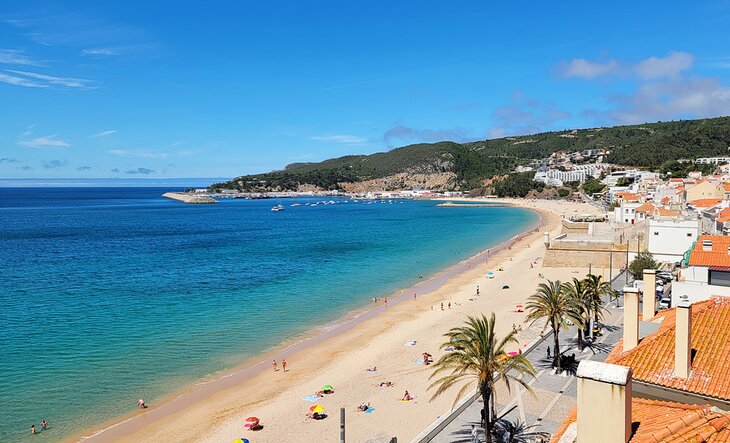
Occupying a wedge of Iberia and sharing a border with Spain and a fantastic coastline with the Atlantic Ocean, Portugal's location in this sun-kissed corner of Western Europe lends it a singular appeal.
Its southern reaches remain a compelling vacation destination, renowned for gloriously sandy beaches and world-class golf courses . The country's interior, meanwhile, offers a wealth of contrast: rolling plains; broad rivers; deep, verdant valleys; and remote mountain ranges.
More far-flung parts of Portugal, namely the Azores and Madeira offer off-the-beaten-track destinations showcasing nature at its best and a different cultural and gastronomical experience.
Defining Portugal's history is an amazing collection of monuments and historic buildings, many of them recognized by UNESCO as World Heritage Sites. And underpinning the country's personality is its people - open, friendly, and hospitable. Spend some time traveling the country, and you'll be enamored by the color, flavor, and warmth of its character.
For help planning your trip, see our list of the best places to visit in Portugal.
7. Parque Natural da Ria Formosa
9. parque natural da serra da estrela, 11. guimarães, 12. madeira, 14. parque nacional da peneda-gerês, 15. bragança, 16. mértola, 18. the azores, 22. parque natural da arrábida.
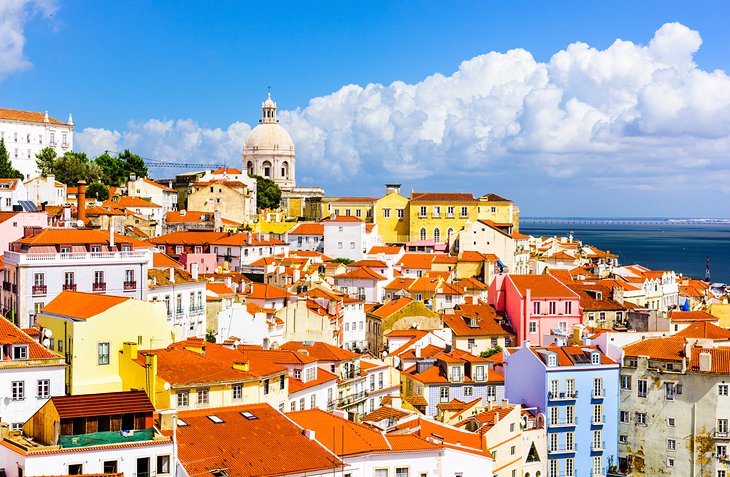
Lisbon, the capital of Portugal, is one of Europe's most alluring cities. Set on the banks of the River Tagus, this vibrant Atlantic port is scattered over a series of hills that heighten its splendid waterfront location. Exploring the city's historic core is a journey into its fascinating past - a heritage exemplified by celebrated visitor attractions , such as the mighty Castelo de São Jorge and Alfama , the oldest part of Lisbon.
A collection of world-class museums extends the cultural experience. To the east, away from the city center, you can marvel at the modernity of Parque das Nações and its crowd-pulling sites such as the brilliant Oceanário.
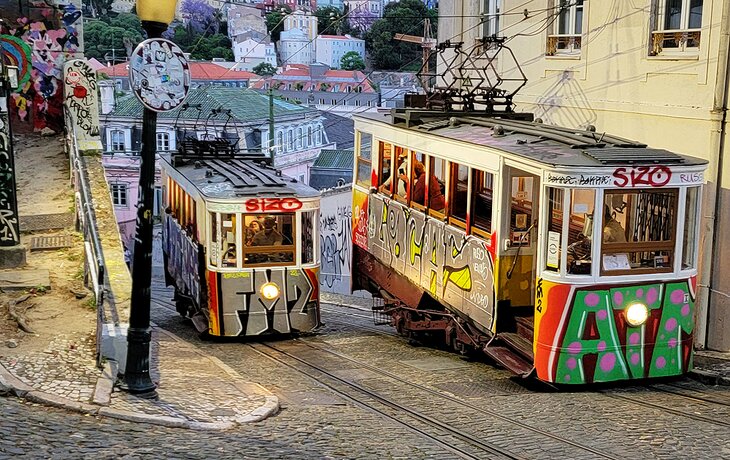
Across to the west in Belém , Portugal's golden Age of Discovery is mirrored in the magnificent Mosteiro dos Jerónimos and the quirky Torre de Belém , both UNESCO World Heritage Sites.
In between, you can amble across handsome tree-lined squares; stroll along broad, riverfront esplanades; or take in jaw-dropping panoramas from the various miradouros, or viewpoints, dotted across the city.
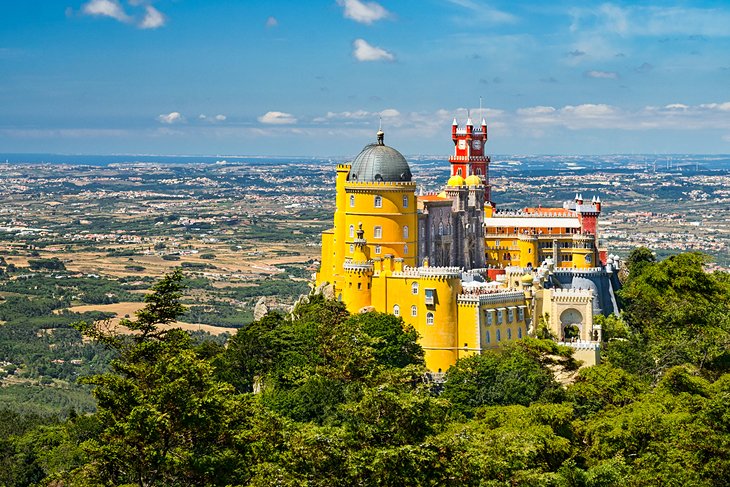
Enchanting Sintra is one of the gems in Portugal's glittering sightseeing crown. Recognised by UNESCO for its remarkable cultural landscape, this historic and captivating town is definitely worth putting aside a full day to absorb. It's one of the most popular day trips from Lisbon .
Clustered under the lip of the wooded Serra da Sintra hills, the town is dominated by the landmark Palácio Nacional , its signature twin chimneys looming over a pretty square edged with houses painted in a palette of pale pink and ochre with splashes of yellow.
Peering down over this picture postcard setting is the ancient Castelo dos Mouros , seemingly hewn out of the granite escarpment it runs along. Crowning the highest hill is the bewitching Palácio da Pena , used in the 19th century as a summer retreat by the Portuguese royal family.
Sintra offers plenty of hiking trails for the avid walker, but you'll need a stout pair of legs to conquer the demanding hills surrounding the town. The highest points of the serra offer breathtaking views across the Atlantic coastline and distant Cascais .
- Top-Rated Tourist Attractions in Sintra
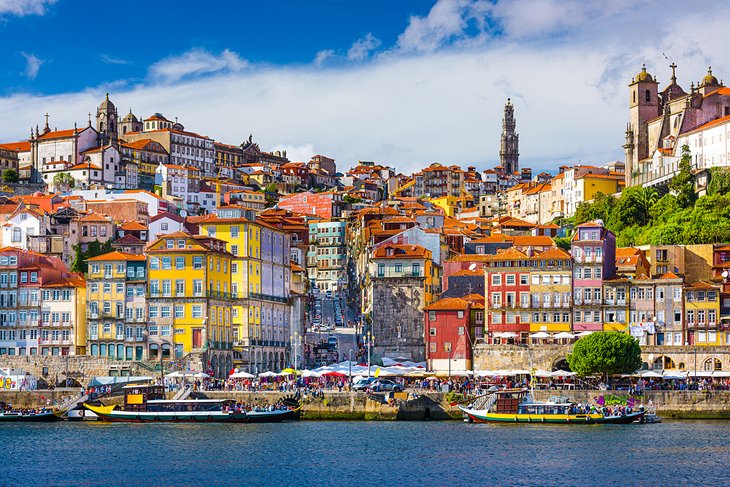
With its robust granite architecture and commercial disposition, Oporto (or "Porto"), Portugal's second city, rewards visitors with a very different experience to that of the capital.
Sited at the mouth of the River Douro and blessed with a waterfront - the Ribeira - acknowledged by UNESCO as a World Heritage Site, Porto is a destination endowed with Baroque churches and Neoclassical buildings that number some of the best examples of their kind in the country. Of particular note are the needle-like Torre dos Clérigos and the imposing Sé , the city's cathedral.
Another landmark structure is the iconic Ponte Dom Luís I , the spectacular double-decked iron bridge that spans the Douro and connects the city with Vila Nova de Gaia . A leisurely stroll along the Ribeira delivers a tangible sense of history, where you can breath in the briny atmosphere of the place.
The river provides a scenic route to the Douro Valley , a verdant landscape of terraced hillsides dotted with hamlets and villages. A popular sightseeing option is to join one of the many cruises that ply the meandering waterway.
- Read More: Top-Rated Tourist Attractions in Porto
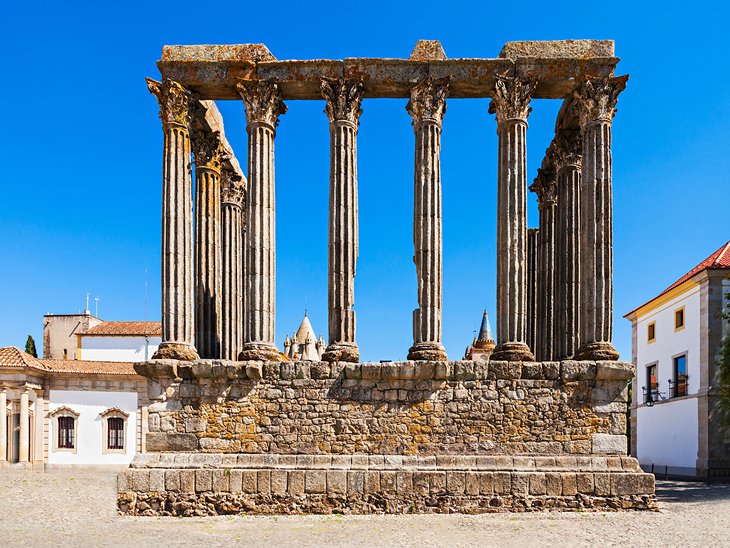
Deep in the heart of the Alentejo is Évora, one of the most beguiling destinations in Portugal. Renowned for its amazing ensemble of well-preserved monuments, Évora deserves close and unhurried scrutiny.
Its medieval walls enclose centuries of history, a timeline illustrated by the impressive Templo Romano , which dates from around the second century, and the brooding but compelling 12th-century Sé (cathedral). Another tourist highlight is the 16th-century Igreja de São Francisco, with its morbid Capela dos Ossos, where the walls are lined with skulls and bones.
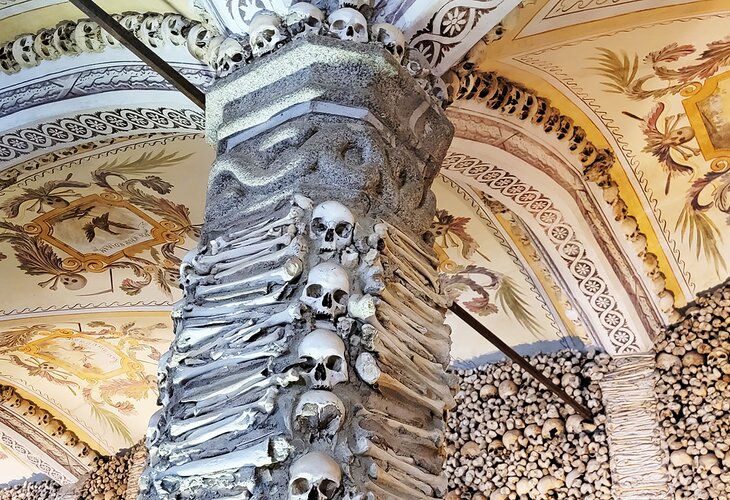
The historical significance of Évora and the unspoiled condition of its architectural treasures has won it coveted UNESCO World Heritage Site status. But you'll also be taken with the city's delightful market-town ambience and down-to-earth personality: it's a pleasure to wander and shop through its Moorish alleys; browse engaging museums; and lunch in attractive squares, where you're considered a guest rather than a tourist.
- Read More: Top Tourist Attractions & Things to Do in Évora
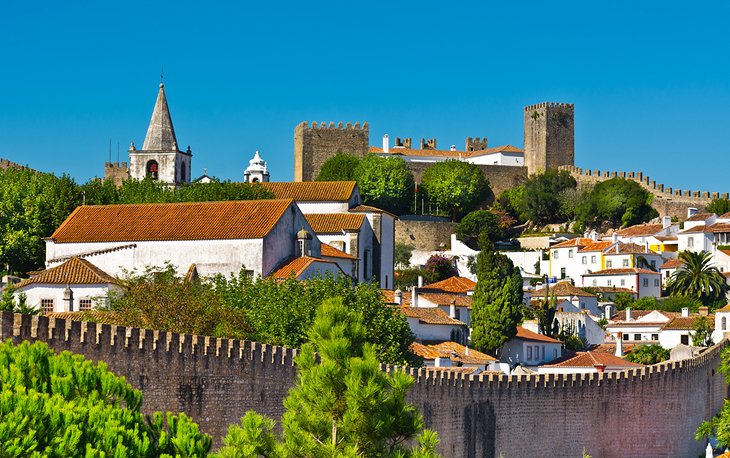
What does a king give his queen for a wedding present? For the lucky queens of Portugal, it was the achingly pretty town of Óbidos , a custom that prevailed for hundreds of years. These days, it's gifted to the general public, and it's certainly worth the hour's drive north out of Lisbon to reach it.
Óbidos is an artist's dream. An assortment of whitewashed cottages, cafés, and handicraft stores lining a series of narrow, cobbled streets are completely enclosed by sturdy medieval walls.
There's also the Igreja De Santa Maria , which features a wonderful interior of blue and white 17th-century azulejos (tiles).
A museum on the town's attractive square includes rare works of art by the 17th-century painter, Josefa de Óbidos.
You can walk along the top of the battlements for lovely views over the terra-cotta rooftops and the lush plains beyond. The fortifications form part of the landmark castle , whose keep looms guardian-like over the charming scene below. The castle itself is now a pousada, an upscale period hotel.
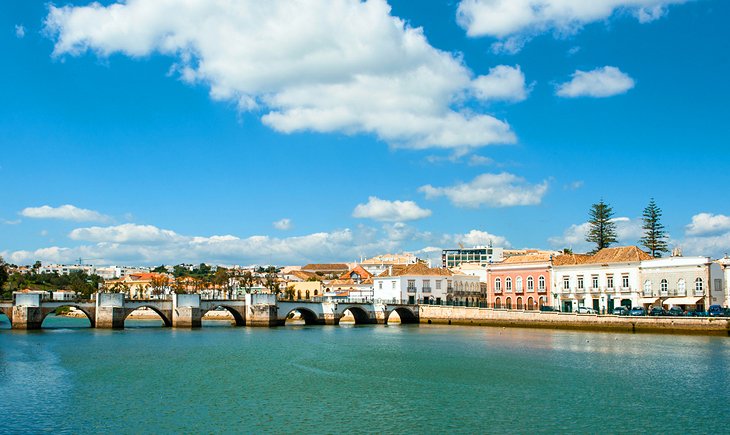
Cited by many a guidebook as the most captivating town in the Algarve, Tavira does indeed tick all the scenic boxes. The Rio Gilão cuts a smile through this pleasantly laid-back town, with a Roman footbridge connecting one side with the other.
The waterfront makes for a wonderful walk, before or after you've uncovered the rest of Tavira's historic treasures. The castle walls provide glorious views across the old town and the nearby coast. You can also explore the Igreja de Santa do Castelo , the grandiose church where warrior knights are entombed.
The town also boasts a fascinating museum, the Núcleo Islâmico . Highlights include a rare 11th-century figurative vase.
An appealing option, especially during the hot summer months, is to visit the offshore Ilha de Tavira , an enormous beach that, even in high season, has plenty of room to spare. It's reached by passenger ferry from a jetty at Quatro Águas.
- Read More: Top-Rated Tourist Attractions in Tavira & Easy Day Trips
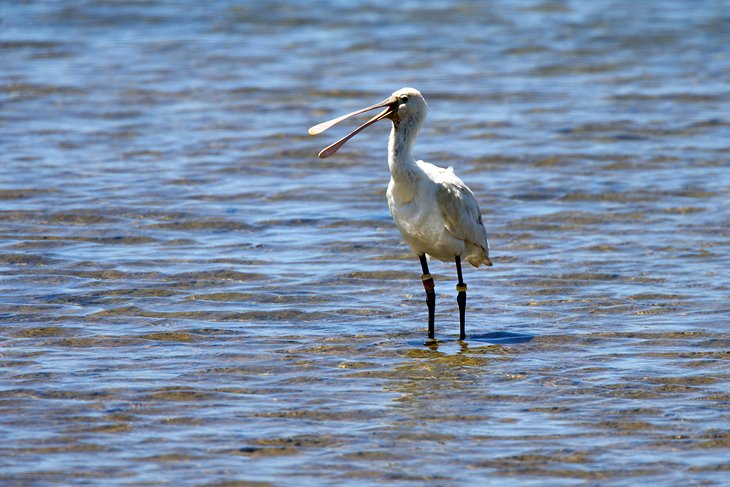
The Algarve is justly famous for its pristine coastline, and one of its natural wonders is the Parque Natural da Ria Formosa. This protected marine habitat constitutes a 60-kilometer stretch of marshland, saltpans, shallow water lagoons, and sand dune islands that run from Quinta do Lago east past Faro all the way to Cacela Velha .
A haven for an abundance of flora and fauna, the park is crisscrossed by a series of nature trails with proximity to some of the animals associated with this region of Portugal. From observation hides built on the lakes, bird-watchers can spy species like the rare purple gallinule, while out on the mudflats, flocks of greater flamingo can be admired. On land, look out for the delicate sea daffodil and flourishing goosefoot and, if you're lucky, the Mediterranean chameleon.
One of the walks passes the renowned San Lorenzo golf course , itself a draw for all sorts of birdlife. The park's headquarters are near Olhão , where visitors can pick up maps and information leaflets.
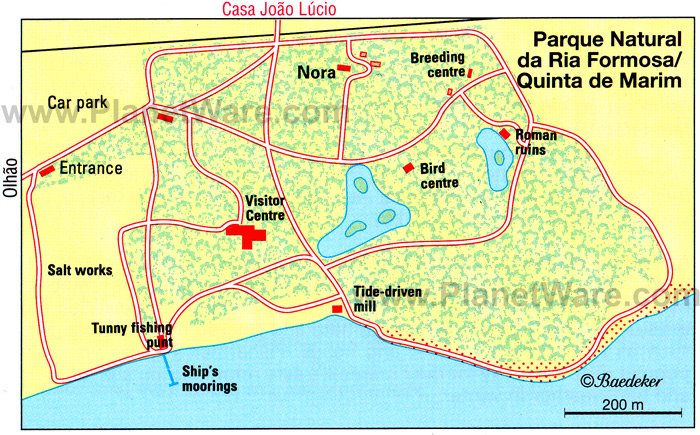
The historic hilltop university in Coimbra is just one reason to visit this venerated Portuguese city. But the wealth of additional visitor attractions , much of them clustered around the Velha Universidade , classified by UNESCO as a World Heritage Site, merits a full day's sightseeing.
The undoubted highlight of a tour of the old university campus is the stunning Biblioteca Joanina , a Baroque gem of gilded and marbled wood and frescoed ceilings. You can also climb to the top of the 18th-century clock tower for a giddy perspective over the entire area. Your exploration should include the imposing late 12th-century Se Velha (old cathedral).
Back in the old town below, there are further historic buildings to discover, among them two former convents and the Igreja de Santa Cruz , consecrated in 1131, which contains the tomb of Portugal's first king, Afonso Henriques.
Elsewhere are a number of interesting museums; a botanical garden; and the fun-filled Portugal dos Pequenitos , a park containing scale models of the country's most prominent traditional buildings.
And the river itself is a pleasant diversion, with a broad esplanade flanking both banks - great territory for long, lazy walks.
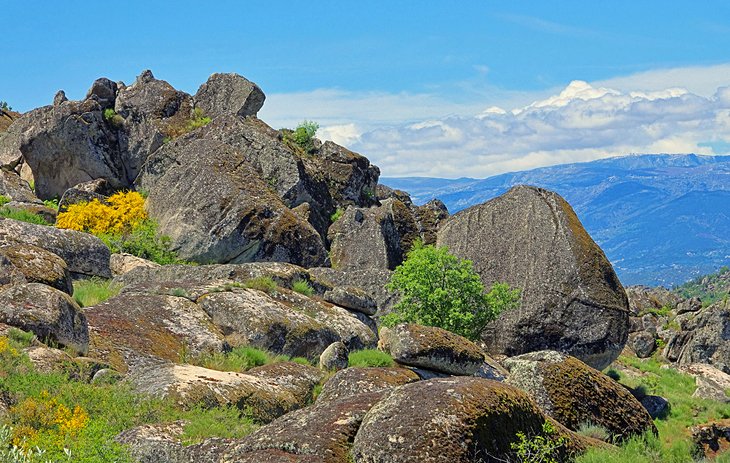
For good reason, the highest peaks on mainland Portugal, the Serra da Estrela , are called the "star mountains." Rising to 1,993 meters above sea level at its highest point, the range, or more precisely the plateau, is a dramatic natural feature of central Portugal. It is often snowcapped in winter, when opportunistic skiers take advantage of what is probably the shortest ski season in Europe.
Otherwise, the granite escarpments and glacier-cut valleys are classic hiking country, with a network of signed long-distance paths and tracks covering the terrain. Along the way, walkers can take in some absolutely stunning countryside and absorb the traditional character of the place, epitomized in villages like Linhares and Valezim .
The mountains are home to the Serra da Estrela sheepdog, a breed unique to Portugal. You are bound to come across proud locals walking one of these powerful but mild-mannered dogs. The area is also known for the deliciously rich and creamy Serra cheese - arguably Portugal's finest cheese. Look for it on sale in the stores that serve many a local village.
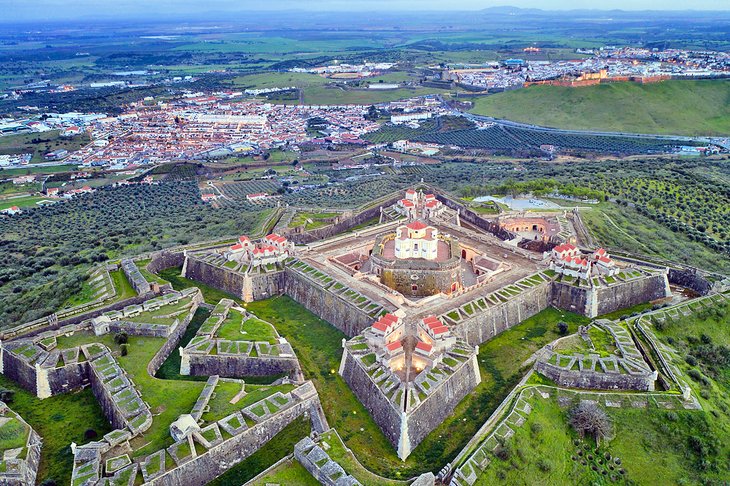
The heavy, star-shaped walls that make up the military fortifications surrounding Elvas are among the best-preserved examples of military architecture in Europe. In fact this frontier town, set on a hilltop in the Alentejo, 15 kilometers from the border with Spain, is so remarkable for its mid-17th-century defences that UNESCO has declared Elvas a World Heritage Site.
It's a long drive east (and should perhaps be combined with a visit to the nearby Spanish city of Badajoz ), but those making the effort to reach this fascinating destination will be rewarded with a truly imposing circuit of walls, deep moats, and star-shaped ramparts. Within this impregnable ring lies a warren of steep, cobbled streets and a number of worthy visitor attractions, notably the Igreja de Nossa Senhora da Consolação , whose nondescript façade belies a truly glittering interior.
A castle, set on the north wall, affords fine views over the area and takes in two smaller outlying forts and the Aqueduto da Amoreira , the town's impressive 16th-century aqueduct.
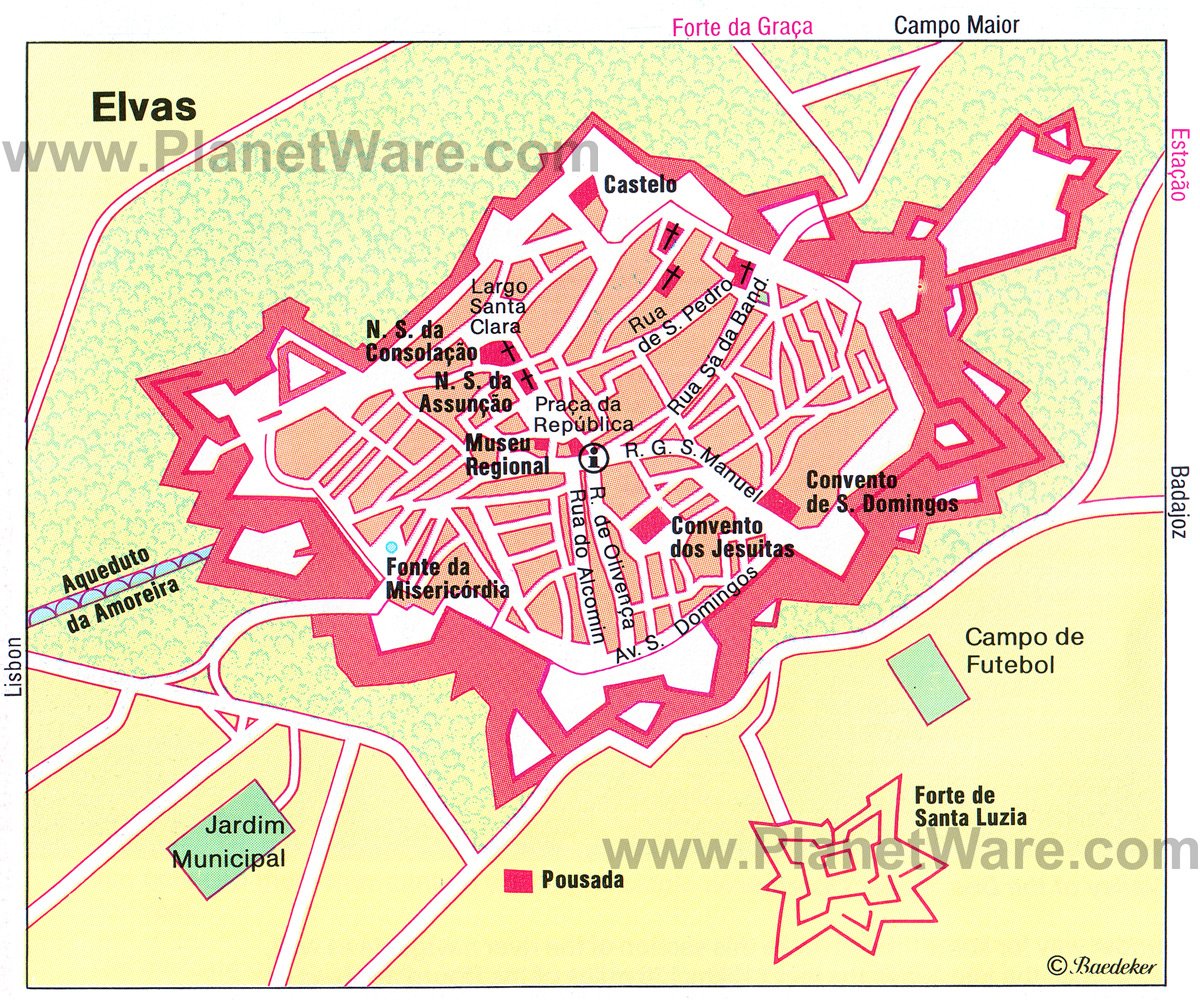
It's fitting that the old center of Guimarães is a UNESCO World Heritage Site, given that this noble city was once the capital of Portugal. That was during the 12th century, when the country's first king, Afonso Henriques, proclaimed this northern city the birthplace of the nation.
A hugely evocative place, Guimarães is the location of a number of important historic monuments, not least the castle , where Afonso was reputedly baptized. The equally significant Paço dos Duques , the royal palace, houses an engaging museum, although the Museu de Alberto Sampaio , which is in the Romanesque cloister of Nossa Senhora da Oliveira, on Largo da Oliveira, has a no less outstanding collection of artifacts.
Actually, Guimarães's famous main square appears straight out of the Middle Ages, with its elaborately carved granite facades; ornate statuary; and the Padrão do Salado , a 14th-century shrine standing in front of the monastery.
After re-living all this history, you should browse the medieval quarter by exploring on foot the maze of narrow cobbled streets past several wonderfully preserved old town houses.
- Read More: Top-Rated Tourist Attractions in Guimarães
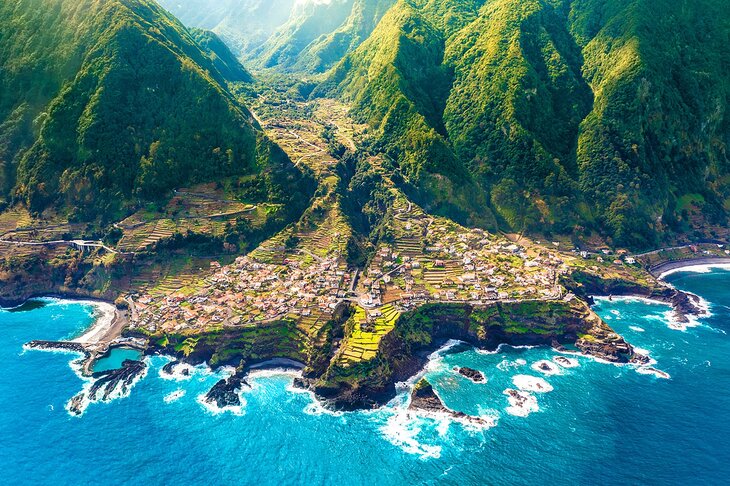
The Madeira Archipelago is a set of four volcanic islands located off the northwestern coast of Africa that have long drawn visitors to their sunny shores. Known by the nickname "Pearl of the Atlantic", the islands are striking, with rugged coastlines, razorback mountains, and subtropical vegetation.
Discover the wonders of the islands, where gastronomy reigns supreme. Indulge in the freshest vegetables and seafood, thanks to the unique microclimate and abundance of the ocean. The capital city of Funchal is a true gem , full of charm and excitement. Wander through its cobblestone streets, admire the old homes and vibrant public gardens, and soak up the lively atmosphere of the harbor.
A delight for outdoor adventurers, hiking trails (or levadas as they are known locally), follow historic irrigation channels to dramatic lookouts. Other more traditional hiking trails wind their way back into the mountains through dense forests to hidden waterfalls.
Although the islands may conjure up visions of golden sand beaches, be aware that Madeira has black pebbly shorelines that are not conducive to strolling in your bare feet or laying out on a towel.
Madeira is a popular port of call for cruise ships and can also be easily accessed by plane in less than two hours from Lisbon or less than four hours from the United Kingdom.
Travelers often ask if they should go to the Azores or Madeira. One big advantage Madeira has over the Azores is its mild year-round climate due to its southern position. While the Azores are a great summer destination, winters are cool and wet. Madeira's daytime highs in winter are around 20 degrees Celcius, and upper 20s in summer.
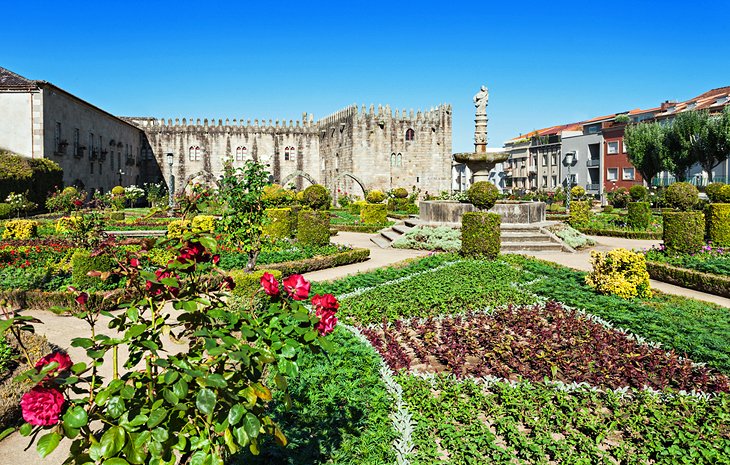
Braga is one of Portugal's grandest cities. Located in the north of the country, the destination has a long history as a religious and commercial center. To wander Braga's historic quarter is to enter a predominantly 18th-century world of handsome mansions, imposing churches, and striking palaces . A number of spruce parks and gardens break up the austere granite veneer that characterizes much of the architecture.
Begun in the 11th century, Braga's cathedral, the Sé , is an obvious visitor attraction and symbolizes the fact that the city remains the ecclesiastical capital of Portugal. The city's central square is a wonderfully atmospheric place to linger, perhaps in one of the cafés housed under the arcades. The adjoining 14th-century Torre de Menagem is all that remains of Braga's original fortifications.
A worthwhile diversion is the Bom Jesus do Monte, the spectacular religious sanctuary located 1.5 kilometers east of the city. Pack a picnic and expect large crowds at weekends.
- Read More: Top Tourist Attractions in Braga & Easy Day Trips
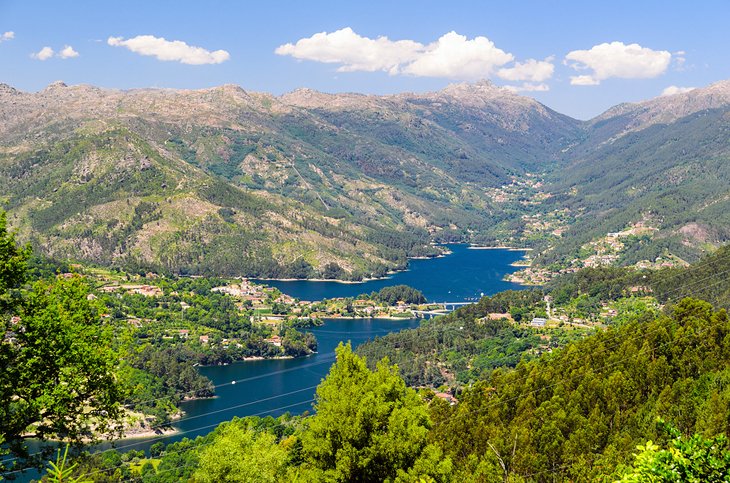
Portugal's only national park, the magnificent Parque Nacional da Peneda-Gerês is one of the country's greatest natural wonders. Occupying more than 700 square kilometers in Portugal's northeast Minho region, near the border with Spain, the rocky terrain encompasses dramatic mountain scenery; lush, yawning valleys; tumbling waterfalls; and deep, crystal-clear lakes.
Traditional villages, hamlets cut from granite and even an old spa resort, Caldas do Gerês , add personality to this bleak but beautiful landscape.
Wolves and wild boar still roam the park's more remote regions, while above, golden eagles spiral effortlessly on mighty thermals rising over dramatic peaks.
The park is a magnet for outdoor enthusiasts. Waymarked trails offer plenty of hiking opportunities, from two-hour romps to day treks. Scattered rural guesthouses and a few designated camping sites provide basic accommodation, though there are hotels in larger towns.
Spring is an ideal time to visit, with the countryside already bursting into full bloom. But even in midwinter, this outstanding destination remains a very special place.
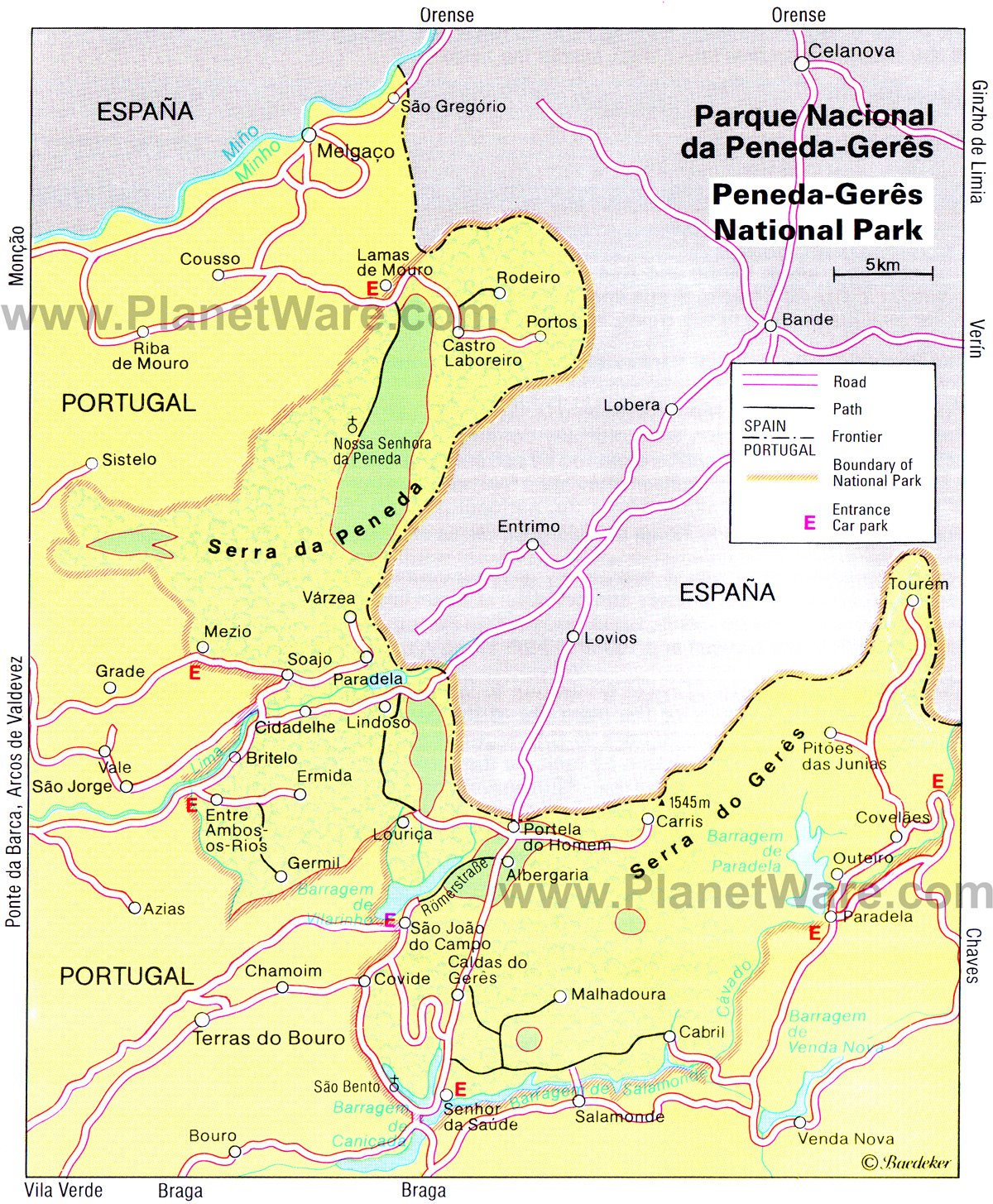
The most remote city in Portugal is also one of its most enticing because you literally do have to travel to the farthest corner of the country to get to Bragança . The old town is especially compelling in that it's completely enclosed by a ribbon of imposing granite walls.
By exploring this walled Cidadela , or "citadel," which dates from 1130, you can glean a tangible sense of the Middle Ages. The ancient streets are lined with squat, whitewashed cottages, and the church of Santa Maria features a striking painted ceiling. But it's the brooding castle and its sturdy keep that really catches the imagination.
Another highlight is the Domus Municipalis , an odd pentagonal council chamber that dates from the 15th century. It's the only surviving example of Romanesque civic architecture in Portugal. Because of the distances involved, it's worth planning an overnight in Bragança, and while the Cidadela is the obvious attraction, the outlying Parque Natural de Montesinho , a 70,000-hectare reserve lying between the city and the border with Spain, is an enticing alternative.
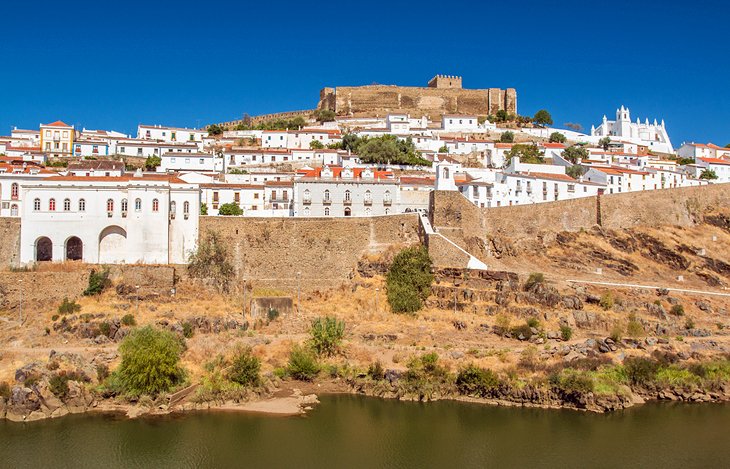
The Alentejo has its fair share of hilltop towns, but few are as appealing as Mértola . Furthermore, this whitewashed smudge of a community sits over the River Guadiana, and the scene is quite idyllic. But what really sets this destination apart is the fact that the whole place has been designated a Vila Museu - a museum site.
Mértola's origins date back to the Phoenicians, who created a bustling river port, a facility later used by the Romans and then the Moors. This diverse and colorful timeline is the basis for the cluster of excellent mini-museums dotted in and around the old town, with each one devoted to a separate epoch.
Helping to illustrate the Arab's residency is the landmark 13th-century castle strategically perched on the top of a hill. The views from the keep command a glorious panorama of the surrounding countryside.
The castle grounds feature an excavated site, where you can admire evidence of Moorish, Roman, and Christian occupation. Not surprisingly, Mértola's church, sited just outside the castle walls, used to be a mosque.
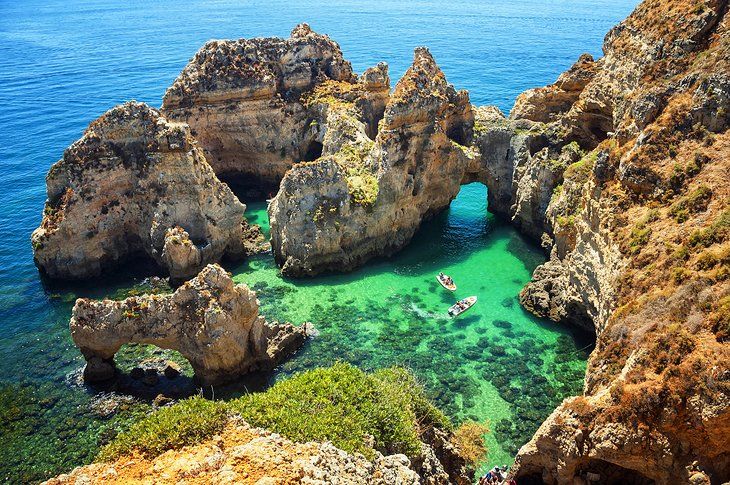
One of the premier resort towns in Portugal, Lagos basks in the warmth of the Algarve sun and is the preferred vacation destination for thousands of visitors, who flock to the country's south coast every year.
Known for the fabulous beaches that flank the town either side of its international marina, Lagos is also home to some truly magical rock formations, sandstone cliffs that tower over a series of sea caves and weirdly shaped grottoes. If you can lure yourself away from the sand, these can be visited as part of a fun-filled sightseeing cruise, among numerous other water sports options.
Back on terra firma, Lagos' cultural draws include the remarkable Museu Municipal and its adjoining Igreja de Santo António , the interior of which is one of the most lavishly decorated in the entire region.
And if you appreciate sunsets, you'll love Ponta da Piedade : the lighthouse is a favorite spot to watch the sun dip below the Atlantic horizon.
- Read More: Top-Rated Tourist Attractions in Lagos
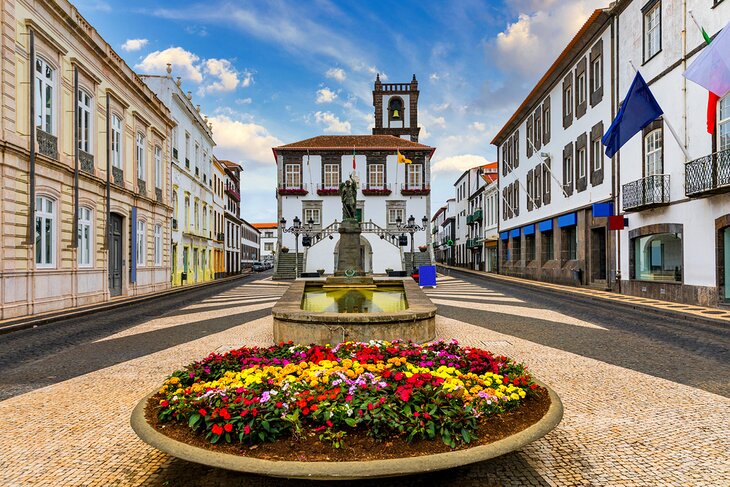
The Azores archipelago is a hidden gem of nine volcanic islands located in the mid-Atlantic. They boast a breathtaking landscape of verdant mountains, meandering rivers, thermal hot springs, crystal-clear crater lakes, and magnificent coastlines.
It's a nature lover's playground with an almost endless array of things to see and do ranging from terrestrial pursuits like birdwatching, hiking, road biking, canyoning, and visiting volcanoes, right through to aquatic options including diving, swimming, fishing, and whale watching.
Layer on top of all that the warm and hospitable Azorean culture of enjoying dining, festivals, and even bullfighting, and it's a heady mix of fun. The epicenter of the good times is the capital city of Ponta Delgada with its lively waterfront, the historical quarter full of beautiful 18th- and 19th-century buildings, and the 16th-century Forte de São Brás.
The Azores are easily reached via a two-hour flight from Lisbon. It's also possible to do a free stopover here from North America on your way to mainland Europe via Azores Airlines. The Azores are also a major cruise stop for trans-Atlantic and European operators.
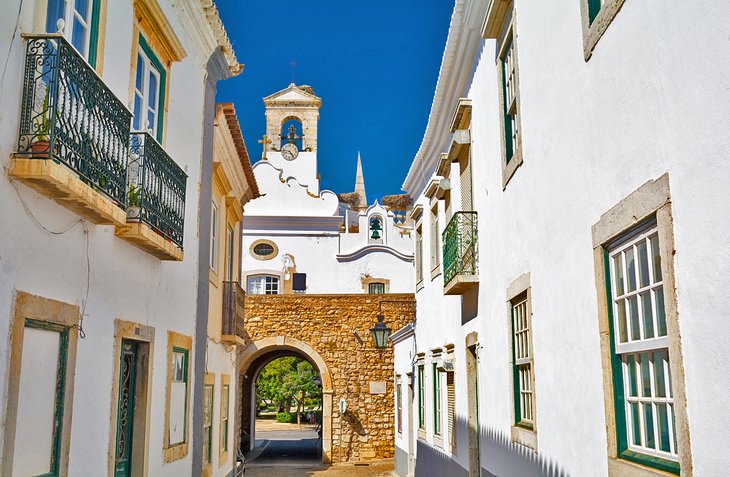
The largest city in the Algarve and the regional capital, Faro has more to offer the visitor than often meets the eye. With its international airport, imposing shopping mall, and sea of concrete high-rises, first impressions are of a nondescript urban sprawl. But peel away the modern veneer, and this is a city with lots to see and much to tell.
Faro's Cidade Velha (Old Town) is the historic core and where tourists should head for. Ringed in part by 16 th -century walls built on Roman foundations, the Old Town's centerpiece is the impressive Sé (cathedral) . Dating back to the 13 th century, this venerable building boasts a dazzling Baroque interior of gilded and lacquered woodcarvings, inlaid marble, and fine azulejo tiling. A highlight is climbing the narrow staircase to the top of the medieval tower , where you can admire sweeping views across the quarter and the Parque Natural da Ria Formosa.
Other Old Town standouts include the fascinating Museu Municipal de Faro , itself set within the hallowed confines of the serene Convent of Our Lady of the Assumption. Beyond the walls is Igreja do Carmo . The church is known for its spooky Capela dos Ossos ( Bone Chapel ), lined with the skulls and bones of more than 1,000 monks.
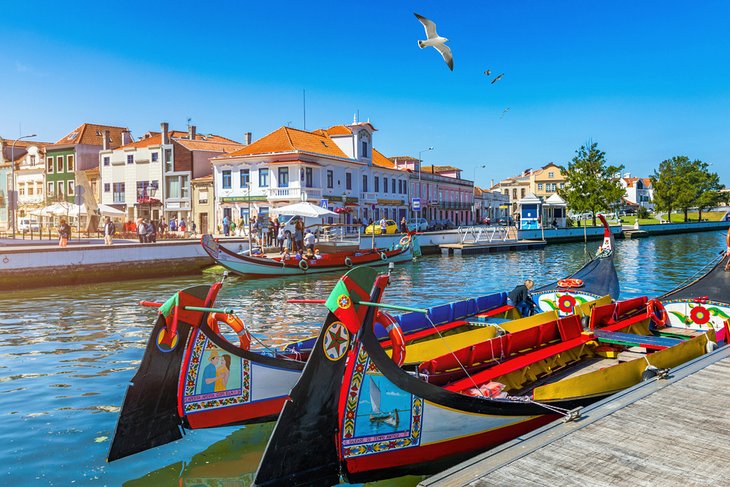
Not for nothing is Aveiro called the " Venice of Portugal ." This attractive city set in the country's Beira Litoral region lies on the edge of a system of coastal lagoons and is crisscrossed by a series of canals that have become the destination's distinguishing feature. Colorful gondola-like boats called barcos moliceiros , traditionally used to harvest seaweed but today used as novel sightseeing vessels, navigate these narrow waterways.
The city is famed for its Art Nouveau architecture - embellishing the picturesque waterside are dozens of shops, restaurants, and houses featuring this early 20 th -century decorative style. In fact, there's a museum dedicated to this artistic expression, the Museu Arte Nova.
But for a broader picture of the city's culture and heritage, spend time browsing the Museu de Aveiro . Occupying the 15 th -century Convento de Jesus , the museum's fascinating collection includes exhibits relating to Santa Joana, a daughter of King Afonso V who lived in the convent from 1472 until her death in 1489.
Luring visitors beyond the city center is the Vista Alegre porcelain works. Established in 1842 and a hallmark of fine craftsmanship, Vista Alegre exports its products around the world. A museum, the founder's palace, and a shop selling discounted merchandise are all worth discovering.
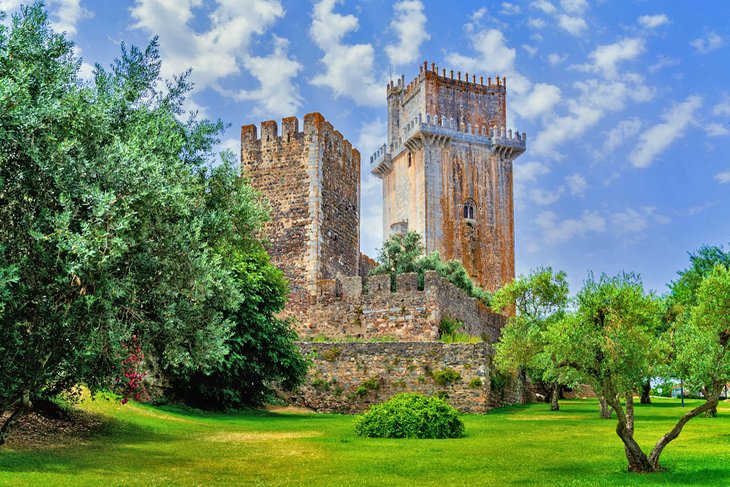
Rural sun-drenched Beja is the main town of the Baixa Alentejo (Lower Altenjo). Commanding a strategic position in the center of a vast region of golden plains, Beja was founded as Pax Julia by Julius Caesar in 48 BC and grew into an important and prosperous city.
Roman influence is still evident today in and around the destination, notably at the Ruinas Romanas de São Cucufate, the ruins of a villa complex located to the north of Beja.
Most of Beja's monuments, however, are clustered together in the historic old town. A rewarding introduction to the city's illustrious past is to visit the Museu Regional . Housed in the impressive Convento de Nossa Senhora da Conceição , the museum is noted for its Roman artifacts and Flemish paintings. History buffs should also spend time in the Museu Visigótico , set outside the castle walls within the Visigoth-era Igreja de Santo Amaro.
The castle itself is always worth a detour, not least for its 40-meter-high keep, the Torre de Menagem. You can climb a steep flight of stairs to reach the top and admire a truly inspiring panorama.
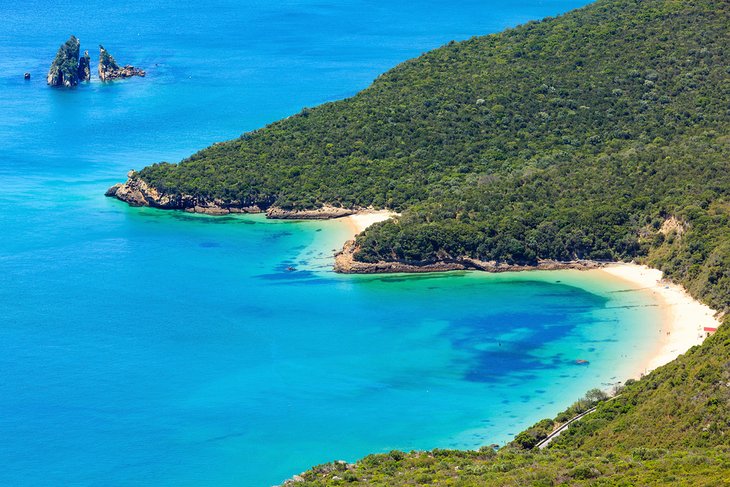
The Arrábida Natural Park is just 40 kilometers south of Lisbon but a world away from the urban clamor that is the Portuguese capital.
Hugging a wedge of coastline between the city of Setúbal and the town of Sesimbra , this verdant swathe of scrub and woodland blankets the craggy slopes of the Serra da Arrábida mountain range, a stunningly beautiful environment separated from the Atlantic Ocean by ribbons of golden sand.
The park is a haven for wildlife and perfect for biking, hiking, and other outdoor pursuits . Meanwhile, the truly adventurous can indulge in coasteering - climbing, walking, jumping, and swimming Arrábida's rocky coastline.
In fact, the coast is dotted with a number of superb cove beaches. Praia do Ribeiro do Cavalo is especially scenic, framed as it is by outcrops of limestone rock formations and ideal for swimming, diving, or snorkeling.
Inland, cultural curiosity can be satisfied by advance booking a tour of the Convento da Arrábida . Hidden away in dense shrubland, this enigmatic convent was built by Franciscan monks in 1542. Tours take in the monastery building, gardens, shrines, and cells.
To recuperate from a busy day's sightseeing, head for the achingly pretty harbor village of Portinho da Arrábida . Here, you'll find a cluster of quaint waterfront restaurants that face the crystalline waters of the Bay of Setúbal.
More Related Articles on PlanetWare.com
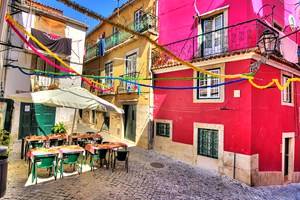
Planning Your Portugal Itinerary: Once you have figured out what you want to see and the places you want to visit, it's time to start thinking about a routing and what's practical. Depending on the amount of time you have, you may want to focus on just one or two areas, or you may decide to see it all. For help planning, see our article on Where to Go in Portugal: 7 Great Itineraries .

More on Portugal
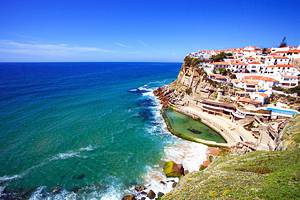

25 Stunning Places to Visit in Portugal (+ map)
- November 2, 2021
- Europe Portugal
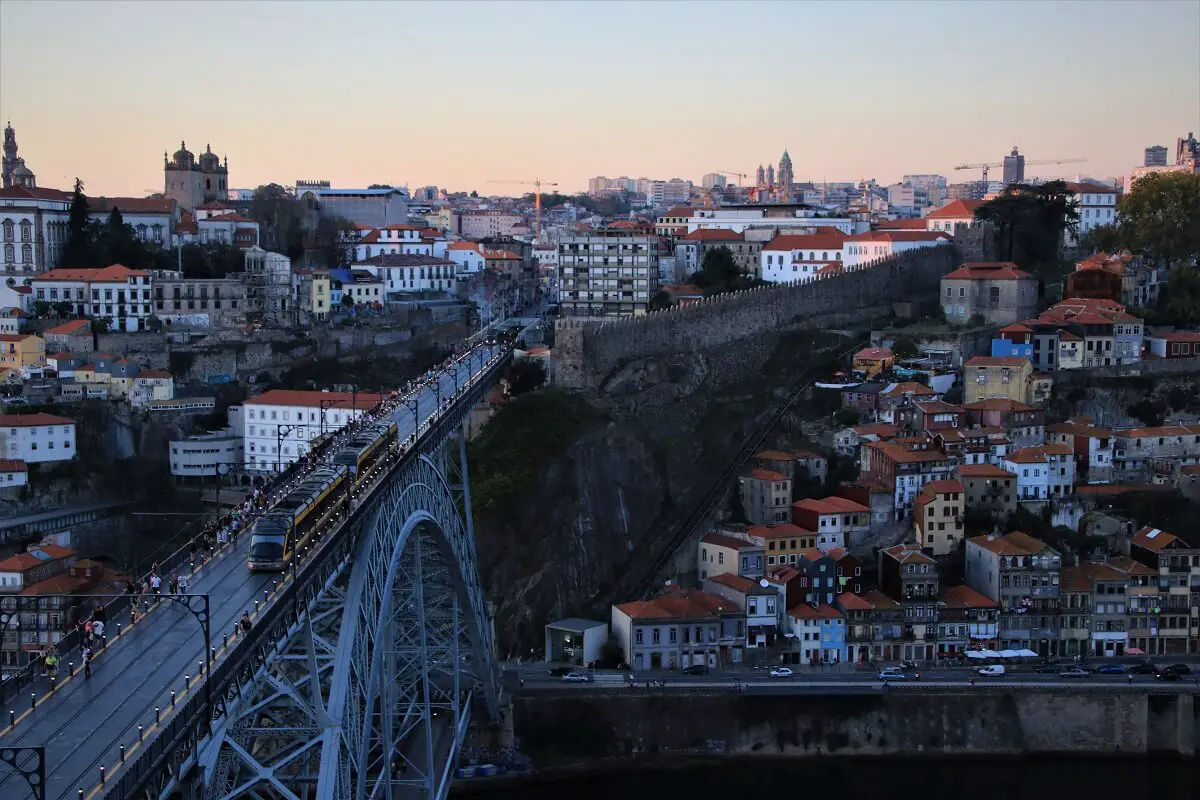
Portugal has become in recent years one of the most attractive places to visit in Europe and there are a myriad of reasons for this. Its fabulous wine regions, isolated islands, cool cities, charming towns, wild beaches, beautiful national parks, rich culture and history will make you want to stay more or revisit as soon as possible. But this sudden attention also means that Lisbon, Porto and Algarve are on everybody’s bucket lists and full of tourists. While they are spectacular places for first time visitors or city-breaks, I’d also recommend you to venture a little off-the-beaten path, to less touristy places and try the true taste of Portugal.
Check out our list of the best places to visit in Portugal and start planning your own adventure! I hope the map of Portugal below will make it easier for you to spot some interesting locations not far from the major hotspots.
25 Best Places To Visit In Portugal
1. lisbon – a sunny capital and one of the best places to visit in portugal.
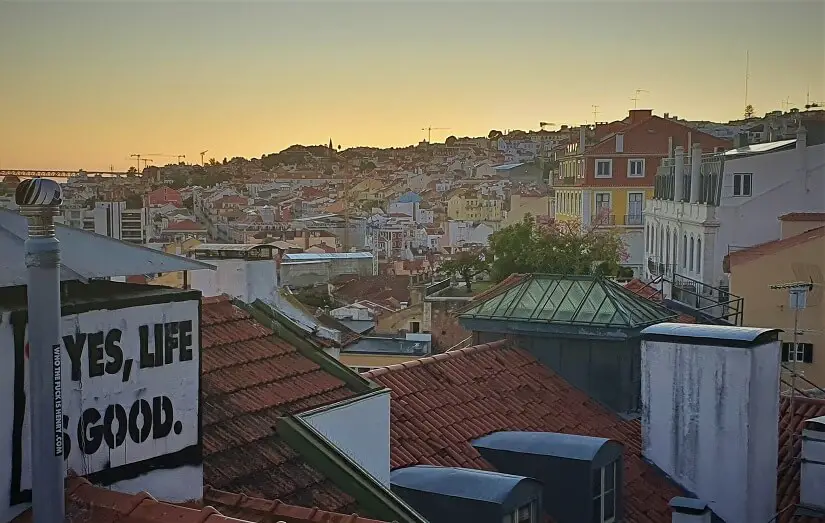
Being the capital of Portugal and its largest city, as well as a World Heritage site, Lisbon is an obvious place to start. It’s an amazing mix of old and new, starting with Moorish quarter Alfama and ending with the modern Parque das Nações in the east. Go on a walk through the narrow lanes of the capital’s diverse neighborhoods. You’ll find gothic cathedrals, local cafes, traditional shops, incredible street art, beautiful azulejos and lovely squares around every corner. Enjoy a tasty pastel de nata and try to hear the dramatic rhythms of fado.
READ ALSO: 35 THINGS TO DO IN LISBON IN THREE DAYS
Don’t just hop on the famous vintage tram 28, but explore also other routes and most importantly, walk, walk a lot. Lisbon is not exactly pedestrian friendly, as it was built on a series of hills. But this also translates into gorgeous viewpoints called miradouros and postcard-perfect panoramas. Lisbon will also reward you with beauty, charm and authenticity that you don’t find in many other European capitals.
Accommodation: Where to Stay in Lisbon?
2. Porto – Portugal’s charming second biggest city
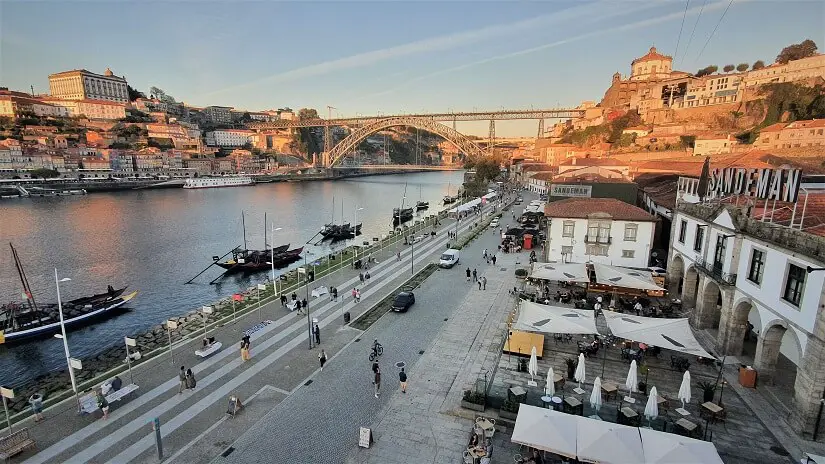
Spread on the hills that overlook the Douro River, Porto is the second largest city in Portugal and an increasingly popular destination in Portugal. With its 14th century walls, medieval winding streets, colorful houses and medieval winding alleys, it’s easy to see why. The historic center is an UNESCO World Heritage Site. A few years ago Porto was on nobody’s radar. As our guide to Paiva said, you couldn’t see the tourists among the locals. Now, you can barely see the locals among the tourists, especially around the city center. But Porto has indeed a personality of its own and it would be a huge mistake to skip it.
READ ALSO: 30 THINGS TO DO IN PORTO IN THREE DAYS, PORTUGAL
Climb up the Clerigos Tower for the best views over the city. Find out where the author of Harry Potter took her inspiration from. Walk around the Ribeira riverfront, listen to some live music and watch the boats float past. Then, cross Luis bridge to Vila Nova de Gaia and enjoy a glass or more of port wine at the best centuries-old cellars. Finally, watch the most wonderful sunset in Porto from Jardim do Morro.
Accommodation: Where to Stay in Porto?
3. Coimbra – the romantic university city and one of the best places to visit in Portugal
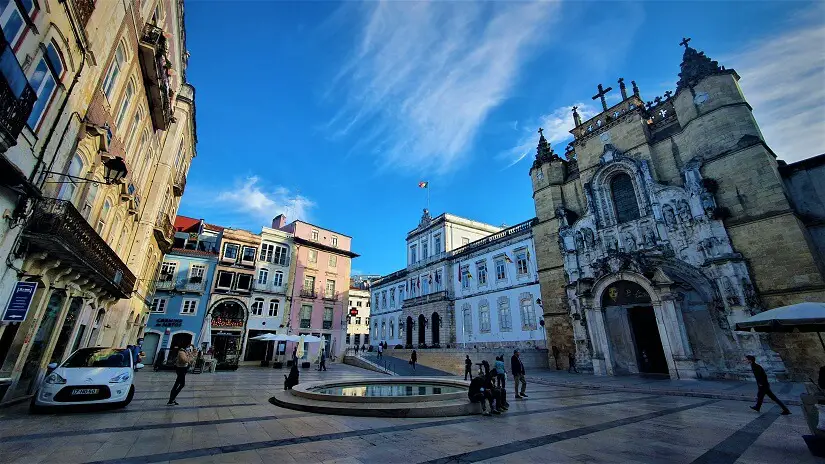
Home to one of the oldest universities in Europe, that’s also an UNESCO World Heritage site, everything in Coimbra seems to revolve around students. The city is far less touristy than the previous two, but still full of history and culture. I’d dare to say it was my favorite city in Portugal, if I could stop thinking about the beautiful sunsets in Porto and Lisbon.
Coimbra has probably the most beautiful parks we’ve seen during our month in Portugal. Start with Penedo da Saudade, full of poems from former students, and continue with the peaceful oasis Jardim da Sereia and the botanical garden with a real bamboo forest. Many places in town are connected to love stories of former inhabitants, like Pedro and Ines bridge or the mysterious Quinta das Lágrimas . Other historical gems are Santa Cruz church, part of which was turned into a pretty cafe and Santa Clara-a-Velha Convent. As a city of students, in Coimbra evolved a different and unique form of fado, sang by groups of male students. Some songs were dedicated to girls, while others are about knowledge and life.
READ ALSO: COIMBRA – THE BEST THINGS TO DO AND SEE WITH MAP (PORTUGAL)
Accommodation : This is the hotel we stayed at in Coimbra for one night. It’s not the best looking one, but it’s central and the owner was more than willing to help us and accommodating when we got there very late because of a transport strike. We could also check out late.
4. Évora – a charming world heritage site town
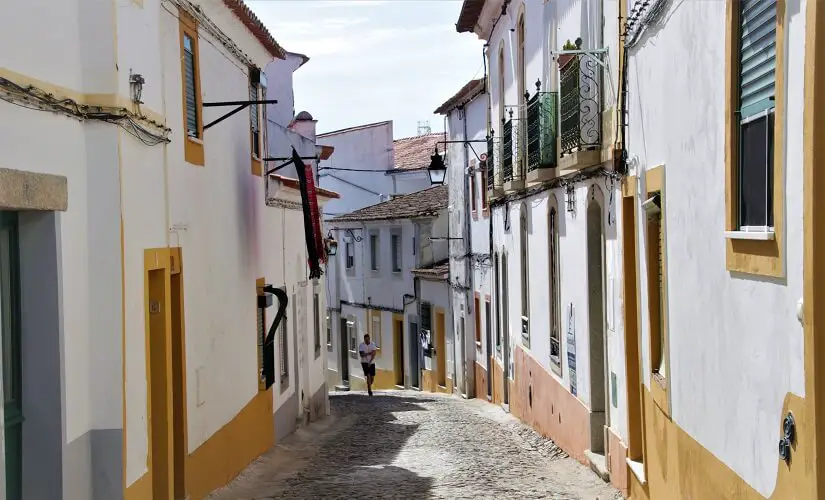
As it’s close to Lisbon, located in Alentejo wine region and an Unesco World Heritage site, Évora attracts a pretty large number of tourists. Its history dates back more than 2000 years and the town flourished under Roman rule.
The main spots to see are the Cathedral of Évora, the largest medieval church in Portugal, the Temple of Diana and the Chapel of Bones. The last one displays exactly what the name says, the bones of over 5000 former residents moved there from the nearby cemeteries. An unusual and eerie place in Portugal, it was “decorated” by some monks that wanted to remind people the transience of life.
But the best of Évora is the atmosphere, given by the white-washed houses, Moorish courtyards, medieval squares and the 16th century aqueduct. Even if it doesn’t meet its initial role anymore, it’s been fully integrated in the life of the modern town, with cozy cafes, attractive restaurants and quirky shops built right under its arches.
Accommodation: Where to Stay in Évora?
READ ALSO: EVORA: 15 BEST THINGS TO DO ON A DAY TRIP FROM LISBON, PORTUGAL
5. Aveiro, the only place in Portugal with water canals and Costa Nova, one of the locals’ favorite places in Portugal
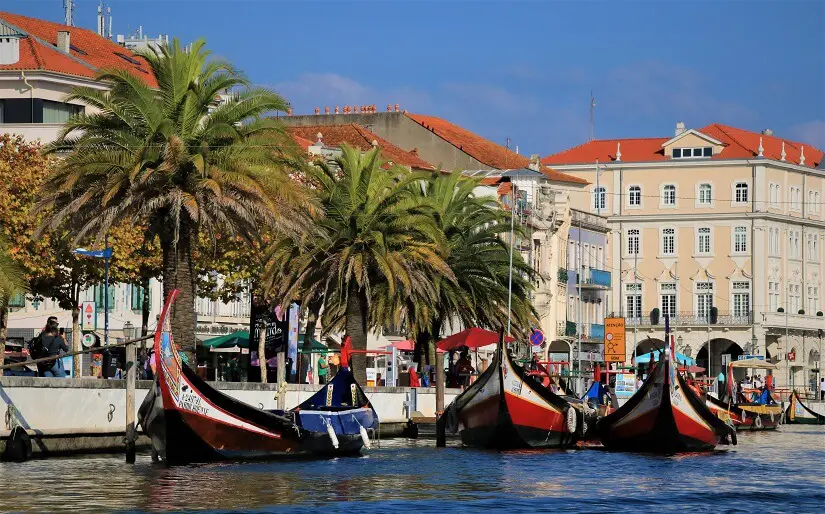
Also known as the Venice of Portugal, Aveiro is a small town with colorful boats floating along canal waters. Don’t expect it to look like Venice too much, though. The nickname is more for publicity, but the town is still nice and worthy of a visit. One of the best things to do is ride a moliceiro, alias the gondolas of Aveiro, previously used to collect seaweed.
The architecture is also quite interesting, as it combines the typical Portuguese tiles with the decorative Art Nouveau style. In fact, the town, tiny as it is, has 28 buildings featuring this early 20th century decorative style that embellish the waterside and an Art-Nouveau Museum. Quite a pleasant mix. Aveiro also boasts a fish market designed by Eiffel, which is another must-see, in case you get there. Nearby, the rainbow-striped fisherman houses in Costa Nova are some of the locals’ favorites to spend their summer weekends. For us, it’s a trendy place to spend half a day at the beach and snap some colorful photos.
READ ALSO: AVEIRO: 15 COOL THINGS TO DO ON A DAY TRIP FROM PORTO
6. Faro, an often overlooked place to visit in the Algarve region of Portugal

Faro is the capital of Algarve and definitely one of the best places to visit in Portugal. However, many visitors skip it in favor of the most famous holiday resorts. We didn’t do it and we are really glad with our choice. Before getting to Coimbra, I thought this was the perfect city in the country, just the right mix of bustle and peace. At the same time, we deeply disliked Portimão as a basis for exploring the region. Anyway, there is no accounting for tastes.
Let’s get back to Faro! Stepping into the old town is like going back in time. The main site is the old cathedral. For a small fee, you can climb up the tower, visit the church, museum and a small bone chapel. The city has a small marina from which you can easily get to the islands in order to enjoy a day at the beach. Ria Formosa lagoon, also set nearby is a great place for exploration and bird-watching. Seafood and fish are fresh and tasty everywhere and the most traditional dish is cataplana.
Accommodation: Here is a beautiful accommodation in a traditional Algarvian house
READ ALSO: 17 BEST THINGS TO DO AND SEE IN FARO, PORTUGAL
7. Sintra, home to some of the prettiest castles and palaces in Portugal
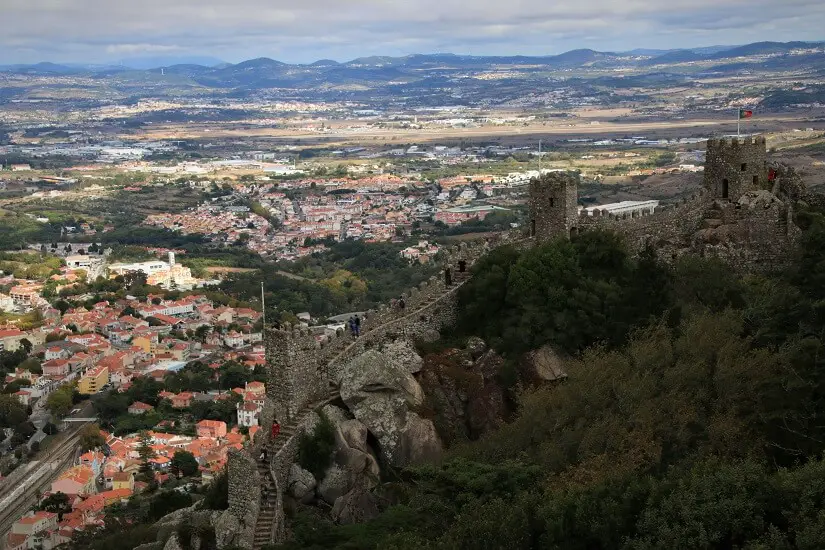
Just 40 minutes away from Lisbon sits Sintra, the wonderland of Portugal, with historic castles and idyllic mansions that one could explore for days. The most known of them all is Pena Palace, set high up on a hill surrounded by exotic trees. If you’ve ever seen a photo of Sintra, it’s probably one of its red and yellow-painted walls. But there are many others.
READ ALSO: SINTRA: THE ULTIMATE GUIDE FOR PLANNING A DAY TRIP FROM LISBON
Next door to Pena Palace spread the ruins of the 8th century Castle of the Moors. Even if very little is left out of the fortress, the views and the walk on the long walls are jaw-droppingly. In the town center, the most famous castle is Sintra Palace, with its twin iconic chimneys. Another quirky palace is Quinta da Regaleira with its mysterious initiation well, underground tunnels and masonic symbols. A little further away, Montserrate Palace is one of the most beautiful and underrated of the architectural jewels in Sintra. These are just a few of the castles and palaces in Sintra, but I hope more than enough to make you want to pay it a visit .
Accommodation: Where to Stay in Sintra?
8. Obidos – one of the prettiest places to visit in Portugal
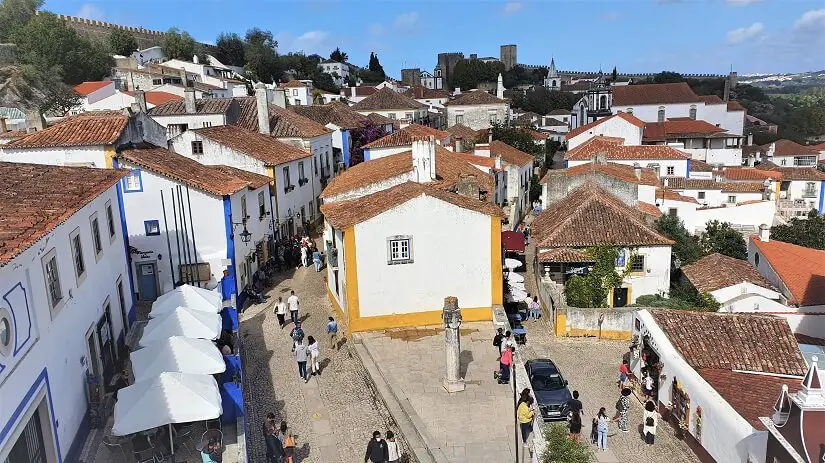
The ancient walled town of Obidos is one of the most pretty towns in Portugal. Centuries ago, Queen Isabel fell in love with it and her husband decided to give it to her as a gift. To understand what enchanted her so much, you must visit it and see for yourself. Encircled by walls, with whitewashed houses and a medieval castle on one side, now turned into a hotel, Obidos transports its visitors directly into the era of ladies and knights. Its labyrinth of cobblestone alleys dotted with cafes and shops are a marvel to explore.
The vineyards around and isolation add even more to the picturesque of the location. The town is also an UNESCO recognized Creative City of Literature. One of the churches was converted into a library, as well as one of the cellars. But many other places have collections of books, to sell or just as decorations. The coolest and most unusual hotel that will transpose one instantly into the local ambiance, is the The Literary Man Óbidos Hotel .
Visit Obidos, Nazare, Fatima and Batalha on a day trip from Lisbon!
READ ALSO: OBIDOS: 10 THINGS TO DO ON A DAY TRIP FROM LISBON, PORTUGAL
9. Peniche – a historic town in Portugal surrounded by the sea
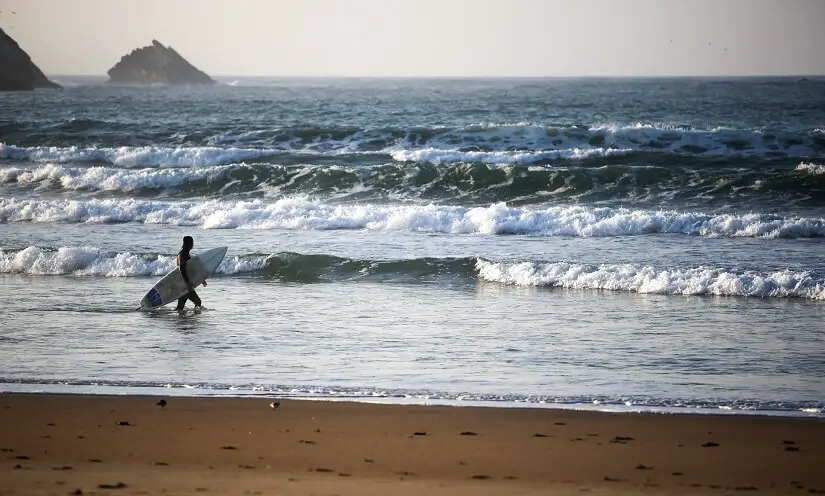
Very close to Obidos is Peniche, a tiny town set on a peninsula surrounded by the sea. Here’s set the seaside fort where Salazar used to detain political prisoners. This is also the main tourist attractions. However, the walled old town is nice and romantic. It also boasts gorgeous beaches perfect for water sports. Berlengas Islands Nature Reserve, just a boat ride away from Peniche, is one of the most beloved holiday destinations of the Portuguese people. When I asked our guide to Arouca about his favorite destinations in Portugal, this was the first one he mentioned.
10. Nazare – a pretty coastal town that attracts international surfers and backpackers
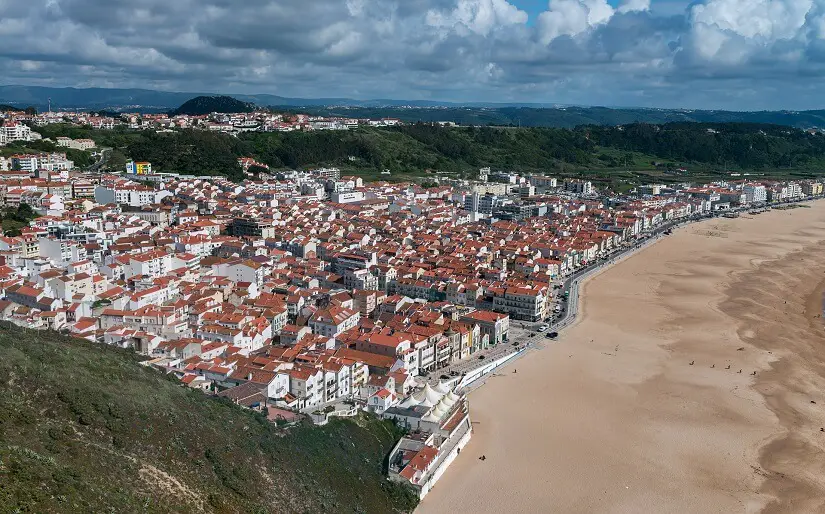
Nazare is a fishing town with rugged costal cliffs and beautiful beaches. But this seaside location has also gained international recognition due to its enormous waves reaching more than 30 meters. These are caused by an undersea canyon and you can find all about it at the small surf museum there. Although the monster waves only happen during a short period of time every year, Nazare is still one of the best destinations in Portugal year round. With a rich fishing tradition, dating back hundreds of years, it’s also home to fantastic seafood restaurants. Visitors can relax on its golden sands, check out some of the historical churches and chapels or take the funicular from the beach to the top of the cliffs.
11. Amarante – a pretty town in Portugal with indecent cakes
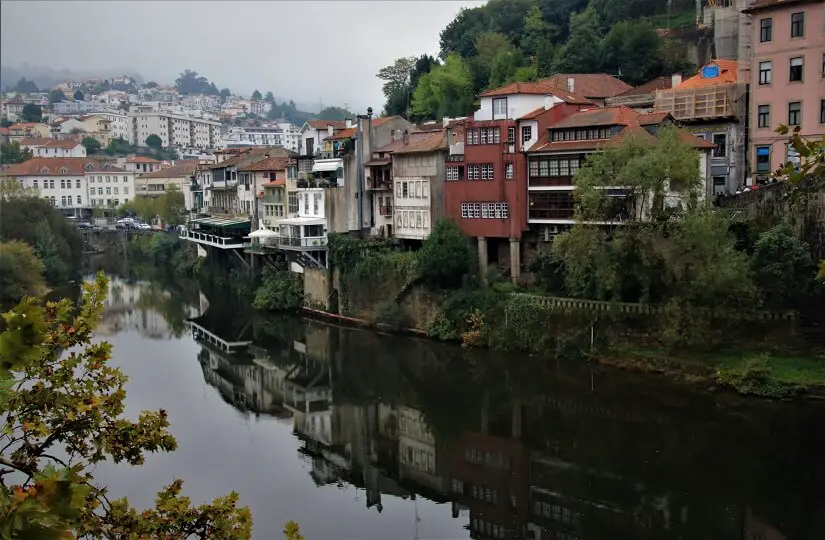
Amarante is one of the oldest towns in Portugal, dating back to the 12th century. Set in the middle of Minho wine region, the town is famous for its vinho verde. The locals have even an unique way of serving it, in small bowls instead of glasses, just like a soup. An attractive riverside town, at the foot of the mountains, it’s hard not to fall for its beauty.
The main sights of this medieval location is San Gonzalez bridge, rebuilt in the 18th century after the original one from the 13th century. One of the local sweet treats (traditionally very very hard to bite) and with a pretty indecent shape is related to a legend of this saint, that built the town and helped old ladies get married. But, of course, everything came at a price. Even if it’s a small countryside town, it’s also home to an one star Michelin restaurant. Amarante is one of the best day trips one could take from Porto.
12. Pinhao, a pretty town in Portugal and the center of Douro Valley
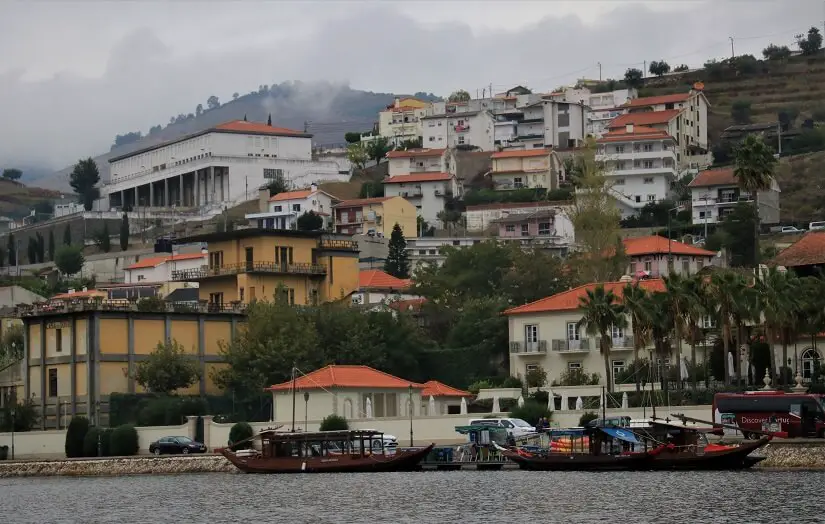
Due to its commercial importance after the Brittish gained a taste for port wine, Pinhão became the first modernized town in Douro Valley. It had electricity, phone lines and telegraph far before the other municipalities in the region. A railway to connect it with Porto was also built, as most of the wine produced here was meant for export. Spectacular scenery with rolling hills surrounds this small town and nothing compares to a peaceful boat cruise on the Douro. As you float past the best wineries, take a moment to enjoy the serenity and a glass of port.
READ ALSO: DOURO VALLEY: BEST THINGS TO DO IN PORTUGAL’S FAMOUS WINE REGION
13. Cascais – a cosmopolitan coastal resort and a great place to visit in Portugal
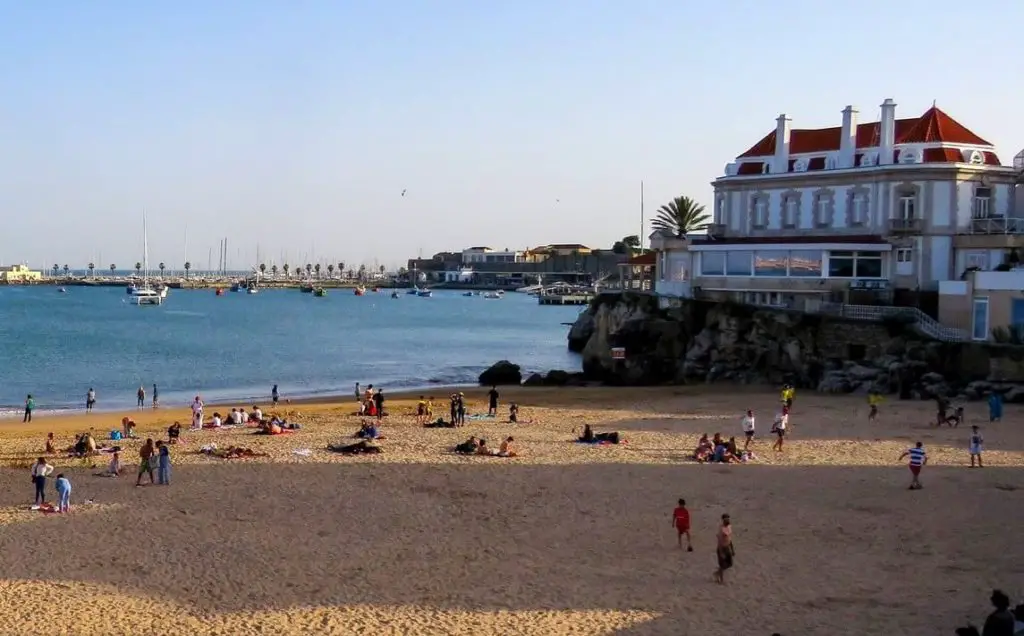
Just one hour west of Lisbon, Cascais is a chic coastal resort with idyllic beaches and a rugged coastline. It gained popularity in the 19th century, when King Louis I of Portugal chose it to be his summer retreat. The elegance of the town is a reminiscence of those golden times. Take a walk to explore the historic center and discover Boca do Inferno, a prelude for what you’d encounter in the Algarve region. The most sought beach is Praia do Tamariz. Another attraction in town is its beautiful marina with luxury yachts that shine in the bright sunlight.
14. Lagos – probably the most beautiful small town in Algarve
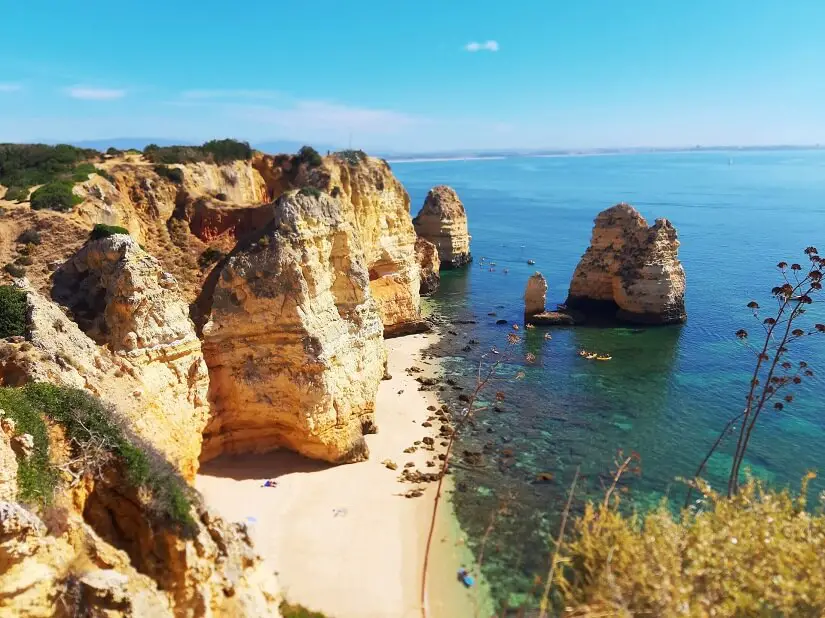
Lagos is a jewel of the Algarve region. It has everything a charming Portuguese town should, but also a stunning countryside and coastline that surrounds it. A short walk away from the center is Ponta de Piedade, a beautiful rock formation looking like a bridge nestled in the ocean. A great location to see the sunset at the Atlantic ocean is the lighthouse there.
The main historical attractions are the Municipal Museum and Church of St. Antonio. Other fun activities one can do in Lagos include kayaking tours, boat trips, snorkeling, stand-up paddle, rock climbing and many more. Lagos is a popular day trip from Faro, the capital of Algarve, or the other resorts in the region. But one could also spend one or two nights in it with no regret.
READ ALSO: BEST THINGS TO DO IN ALGARVE, PORTUGAL
15. Braga, one of best places to visit in Portugal
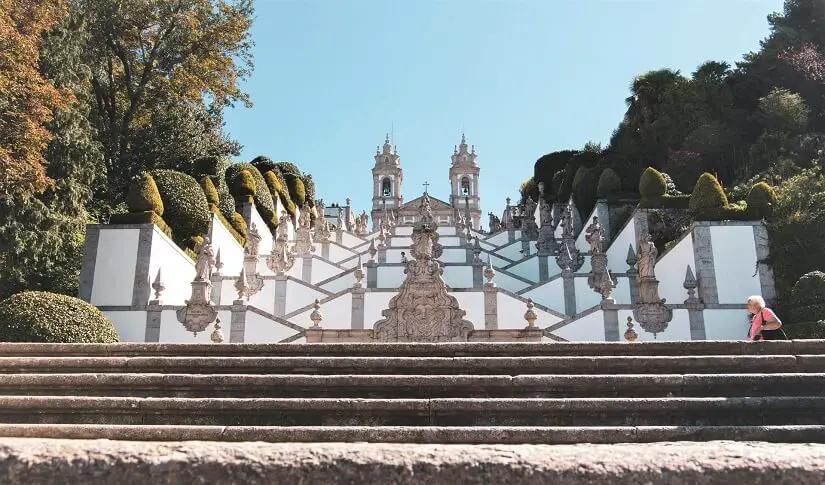
Portugal’s third-largest city is home to great restaurants, an university and historic sites. These would make a visit worth it by themselves. But Braga also has Roman ruins, pretty squares and an 18th century palace. However, the most famous tourist attraction stands just on its outskirts. Even UNESCO recognized its value as a world heritage site. Bom Jesus do Monte, as this is the church I’m talking about, is world-famous for its gorgeous baroque staircase which penitent pilgrims used to climb on their knees. The city center has a lively and youthful ambiance, thanks to the great number of students, full of cheap cafes, bars and restaurants. Braga is not only the religious center of Portugal, but also a modern city and one of the best places to visit in Portugal.
16. Guimaraes – home to an UNESCO listed old castle and one of the best places to visit in Portugal
A 10th century castle with panoramic views over the city and surroundings and its overall royal ambiance convinced UNESCO to recognize this place as a world heritage site. If this was enough for them, I think it should also make the cut for our bucket list. But just in case, let me add some more things.
Guimarães has a special value for the Portuguese people as it’s considered that this was the place where the country’s roots were set, during the Battle of São Mamede in 1128. The first king of Portugal won and decided to found this beautiful country. Next to the castle, which is pretty much in ruins, but still has spectacular views, there’s the Grand Dukes of Braganza Palace built in the 15th century. This was now turned into a museum, which is the most visited tourist attraction in the north part of the country. Rua de Santa Maria, in the old town, is one of the most beautiful streets in town, but the city hall square is even more charming.
Visit both Braga and Guimaraes on a day trip from Porto!
READ ALSO: GUIMARAES – BEST THINGS TO DO AND SEE ON A DAY TRIP FROM PORTO
17. Parque Natural da Ria Formosa
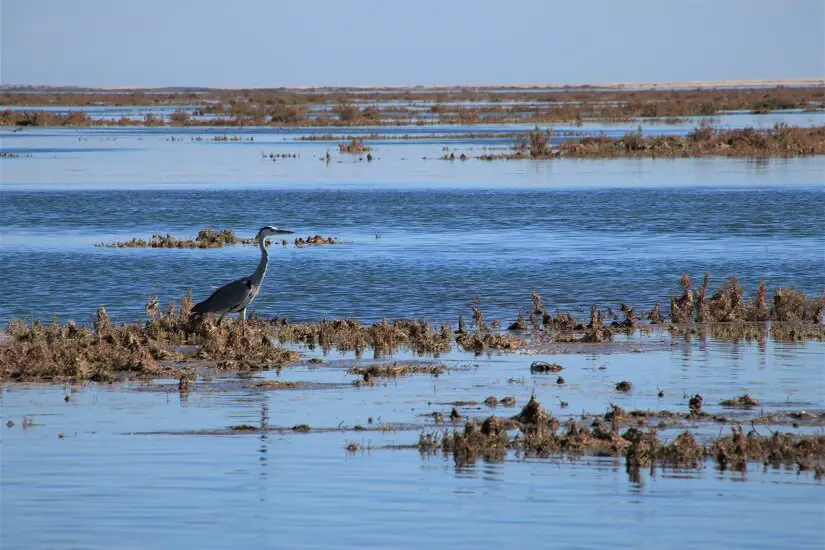
Algarve doesn’t only have wonderful beaches and a rigged coastline, but also one of Portugal’s natural wonders, the Parque Natural da Ria Formosa. This is a protected habitat consisting out of marshland, shallow water lagoons, saltpans and sand dune islands set just next to Faro. In fact, one of the best things one can to in Faro is to go on a small group boat tour of this beautiful spot. The land park is crisscrossed by a series of trails which allow visitors to admire the abundance of flora and fauna. Some of the rare species one can spot here are the purple gallinule, flamingo, egret, heron, fishing eagle and spoonbills. It’s indeed a fantastic way to spend a tranquil afternoon.
18. The Algarve Coast and Benagil Caves – the sunseekers’ favorite and one of the best places to visit in Portugal
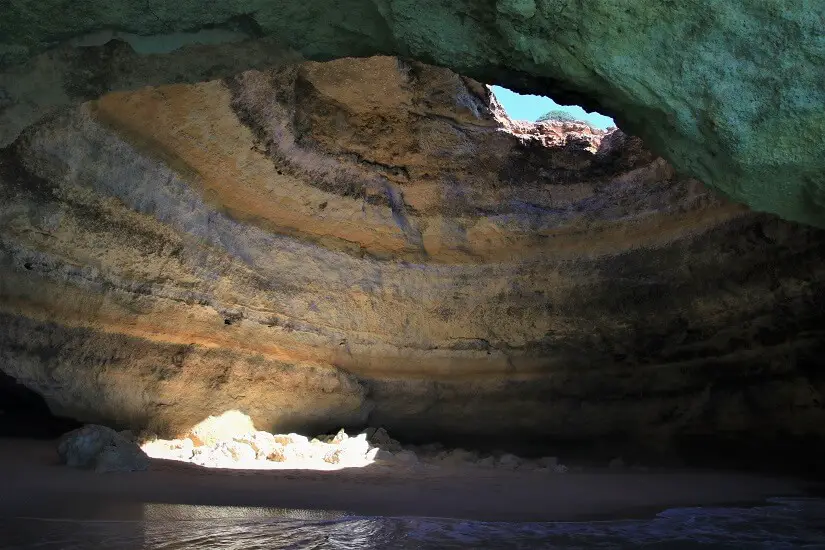
There are many beautiful beaches in Portugal, but the ones in Algarve are definitely some of the best. Located along Portugal’s south coast, at the Atlantic shore, these region is considered by many the ultimate summer destination with top beaches, striking rocky cliffs and scenic landscapes. But even if you prefer going off-season to avoid the crowds, there are still plenty of things to do in Algarve.
Take a day trip to explore some of the dramatic cliffs or a boat ride to some of the most spectacular caves and grottos. Benagil cave is the most popular one, due to its roof hole that lets the light in, but there are many more. Besides, even without entering any cave, the rugged coastline is a marvel to look at from the sea.
Even in winter the weather is mild enough to allow one to explore and discover, not only the beaches and unique rock formations, but also cork forests, Roman ruins and historic tiny towns where you can get to know the true Portugal hospitality and culture. It also offers some of the best golf opportunities in the country. Did I mention the tasty cuisine? Traditionally it consists mostly of fresh seafood, fish, fruit, almonds and carob beans. Some of the dishes tourists will only find in this part of Portugal.
Accommodation: Where to Stay in Algarve?
19. Berlenga Islands
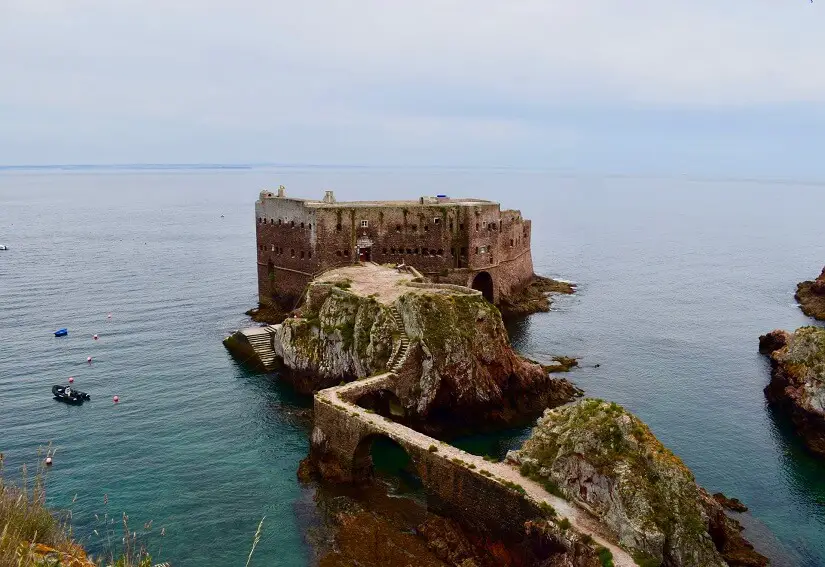
The Berlengas Islands are not quite as famous as the Azores or Madeira. But they are close to the mainland and one of the favorite destinations in Portugal of the locals. In order to get to them, one first has to reach Peniche and take a boat ride from there. These rocky islands, dramatic and barren, are considered a natural reserve. As a result, one can only spend the night in Berlenga Grande. Here’s also the highlight of the islands, the St. John the Baptist fort sitting on a small rocky outcrop. But there’s not much to do there during the night. A day trip might be best . During the day, be prepared to go hiking, snorkeling, birdwatching or swimming in picturesque caves and grottos.
20. Douro Valley – the most scenic wine region in Portugal
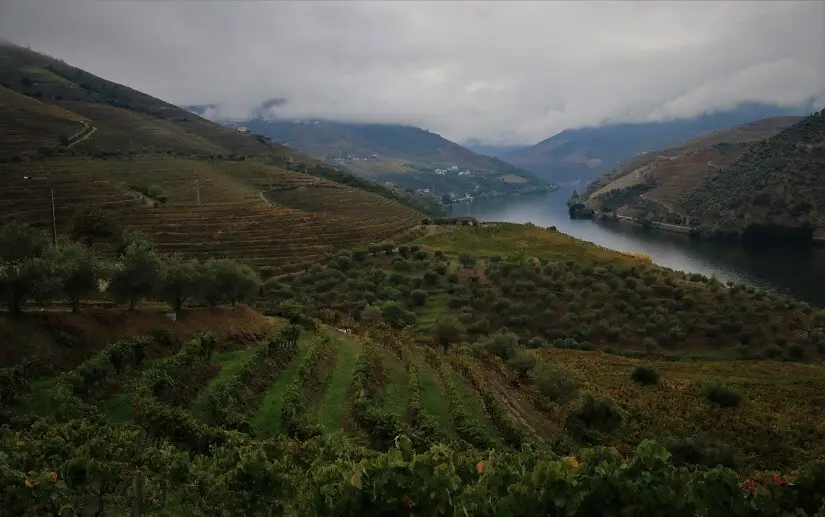
A trip to the north of Portugal would be incomplete without a tour of the Douro valley. The Douro river, once a wild and turbulent river, was tamed by the construction of 8 dams and now is the perfect place for a peaceful ride on a rabelo boat that one can take from Pinhao. From its tranquil waters, you’ll be able to admire the rolling hills full of vineyards and almond trees. This area supplied for centuries the grapes for the best port wines that brought Portugal international recognition. Carrying port from farms to the mouth of the river was the initial purpose of the old rabelo boats.
You’ll see the names of the major companies in Porto proudly displayed on the surrounding hills. If you happen to be there in autumn, don’t miss the opportunity to visit one of the colorful vineyards. Actually, fall season or not, visiting one of the vineyards is still a must, in order to find out more about the history of port, wine production and taste it right there, where it was born. The entire landscape east of Porto is an UNESCO World Heritage site as one of the oldest wine regions in the world. While one can take in the views from the train that crosses Douro Valley, I’d recommend a tour, that will also take care of the visits to the farms and the boat ride for you .
This being said, take into consideration that port wine has nothing to do with wine except its name. If you really want to taste some great and real wines, buy a plane ticket to Moldavia and visit one of the best cellars there, Milestii Mici or Cricova .
READ ALSO: PORT WINE – EVERYTHING YOU NEED TO KNOW ABOUT IT
21. Peneda-Gerês National Park
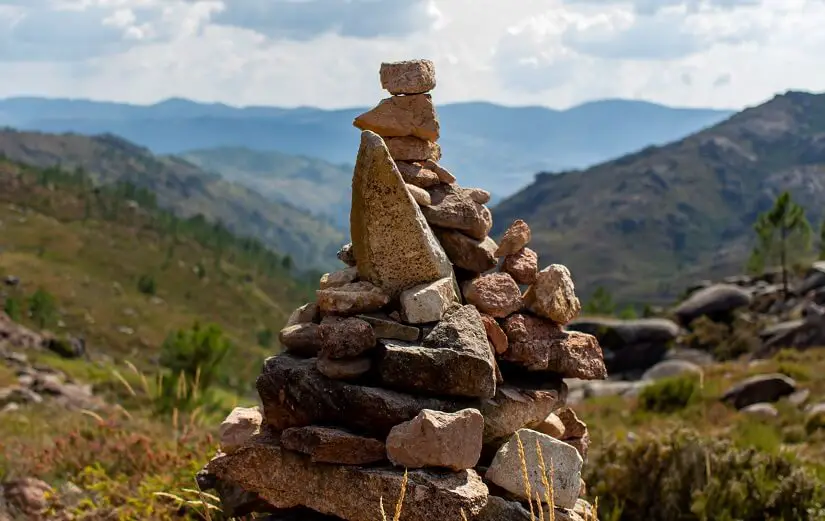
The only national park in Portugal, Peneda-Gerês National Park includes mountains, forests, emerald lakes, waterfalls and secluded villages frozen in time. It is an excellent place to check out the wildlife in the Iberic peninsula, as well as traditional granite houses and centuries old castles. Some of the local species you might spot here are the Iberian wolf, ibex and wild boar. Be also prepared for a rewarding bird-watching session and try to identify part of the 15 different species of bats. Even if you’re not lucky enough, the vast park is also home to scenic peaks, wild streams, steamy thermal springs and flower-covered meadows. The best way to experience the natural landscape is on foot, but you can also take a 4×4 tour if you don’t have much time at your disposal. Camping is also allowed in specific parts, as well as swimming in some of the natural pools.
22. Serra da Estrela and the Schist Villages – a scenic natural reserve and one of the best places to visit in Portugal

Serra da Estrela is home to 27 cute villages made out of a traditional stone called schist. Go on a thrilling drive to discover them or a relaxing hike. The most famous ones are Talasnal, Casal Novo, Linhares, Valezim, Aigra Velha, Aigra Nova, Comareira and Pena. These are also Portugal’s highest mountains. Thus there is no lack of scenic rugged cliffs. Serra de Estrella is probably the best place in Portugal for outdoor adventures. In this range, one will also stumble upon Portugal’s only ski slope. But don’t get over excited about it, as Portugal has the shortest ski season in Europe.
Also called the star mountains , Serra da Estrella rise up to 1993 meters above see level, but the maximum height in continental Portugal got to 2000 m when a tower was put on top of the highest peak. Along the roads, one will also come across the Serra da Estrela sheepdog, a breed unique to Portugal. The mountains are home to the delicious and creamy Serra cheese, a delicacy on sale in the local villages. However, not all trails are well signposted. So it’s be best to go together with a local guide .
23. Paiva walkways and Arouca footbridge
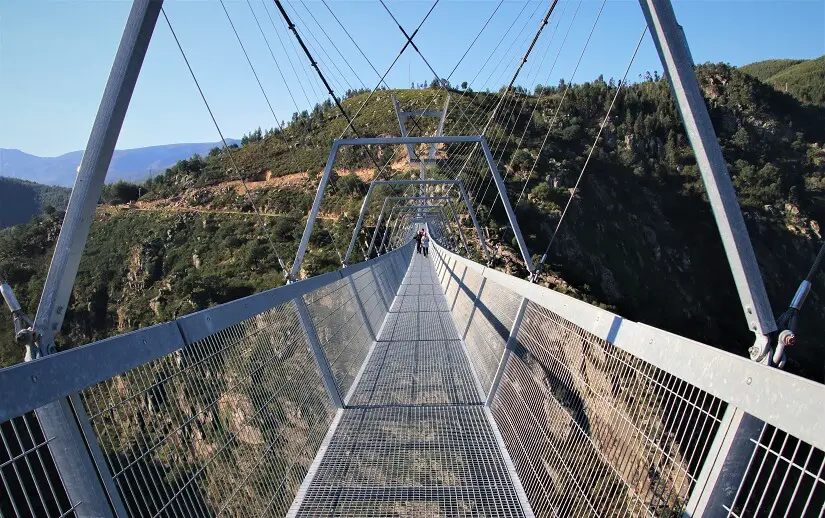
Paiva walkways and Arouca suspended footbridge are located just outside Arouca, 80 km away from Porto. The 8 km path is a bit challenging, but will reward one with outstanding beauty, a peaceful woodland, tumbling waterfalls and pristine gorges. It’s now accessible for almost everyone, as a wooden boardwalk was build along the trail that meanders through the UNESCO Arouca geopark. There are quite a few stairs on the way. Thus, it will still test one’s physical state. The trek takes around 2.5 hours to complete. If you decide to do it, remember to pack some snacks, a hat, sunscreen and plenty of water. At the start of the path, one can also cross Arouca suspended footbridge, the newest attraction in the area. This is the longest pedestrian suspension bridge in the world. While crossing it, enjoy the breathtaking view over the valley and Aguieiras waterfall.
READ ALSO: DAY TRIP FROM PORTO TO AROUCA BRIDGE AND PAIVA WALKWAYS
There’s no public transport to the bridge and pathway. If you don’t have a car, you could join a small group tour from Porto, as we did. The guide took care of the tickets, transport and an awesome traditional lunch. Of course, he also gave us a lot of useful information about the area and much more.
24. Madeira – one of the best places to visit in Portugal
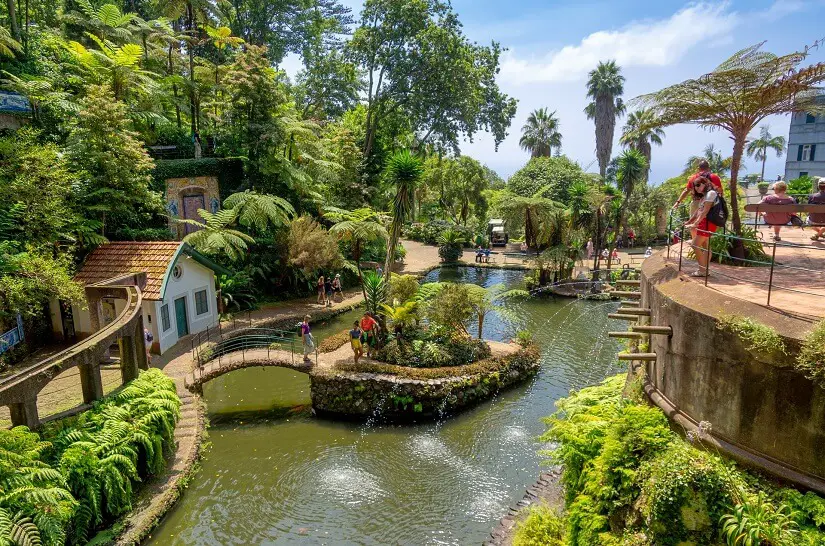
The “Floating Garden of the Atlantic” is located just between Portugal and Northern Africa. Along with Azores it’s an autonomous region in Portugal. It’s popular for its wines, beautiful Orchid Garden and unspoilt landscape. Funchal, the capital of the archipelago, is a delicios mix of modern and tradition. In April and May the Madeira Flower Festival takes place and Funchal organizes its annual Flower Parade. Dancers, singers, performers of all ages dressed in beautiful, bright flower costumes, overwhelming amounts of exotic flowers, beautiful colors and great atmosphere – this is what you can expect. When the sun goes down, those that love a fun-filled nightlife will appreciate the nightclubs, casinos, and restaurants. It’s grown into one of the trendiest Portuguese destinations and it is easy to see why.
Accommodation: Top Madeira Accommodations
25. The Azores Islands – an unique and beautiful archipelago in Portugal
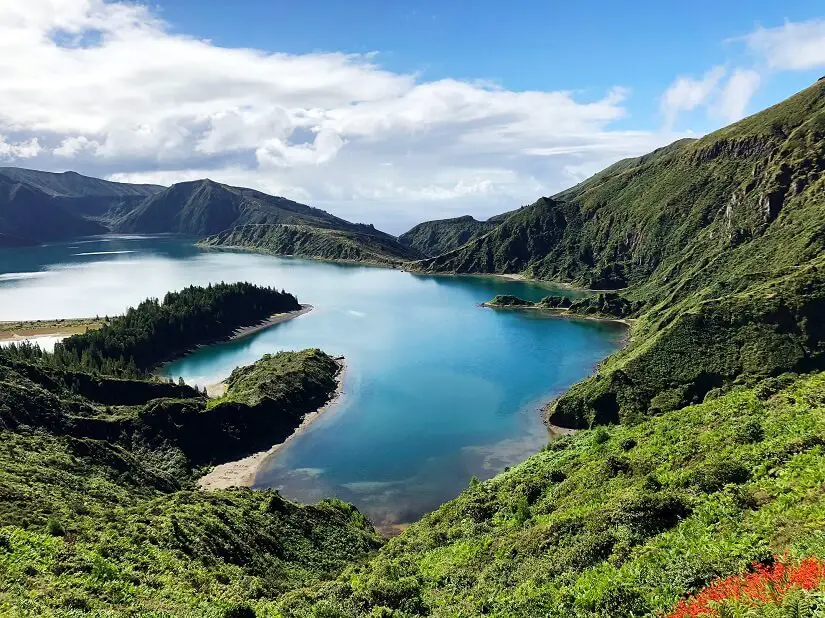
The Azores is a remote archipelago, far away from the bustle on the continent. But it is still one of the best places to visit in Portugal. Visitors can enjoy full days of exploring the great outdoors, surfing and sunshine in the middle of the Atlantic Ocean. Like nowhere else in Portugal, the villages here are set among tea plantations and volcanic lakes. One can also get close to friendly dolphins and whales on one of the many tours organized by local agencies. Snorkeling and diving are also popular activities that allow one to admire the beauty of the seabed and sealife around the islands. Thermal pools are dotted around and you can relax while your dinner is cooked in a traditional pot buried for hours. Finish off with a refreshing dip in Lagoa do Fogo, a lake in a volcanic lagoon.
Accommodation: Where to stay in the Azores?
So, here you have it, a list of the most beautiful destinations in Portugal in order to start planning your trip. We would never encourage you to skip Lisbon or Porto, as they are the quintessence of Portugal, but I do suggest that you add some of the less known spots in Portugal to your itinerary. They might surprise you and become some of the best places you have ever visited in Portugal or even Europe.
Have you ever visited Portugal? Do you know other places people should not miss in Portugal? Share them in the comment box below!
Still here then you must have liked this post. why not share it on pinterest.
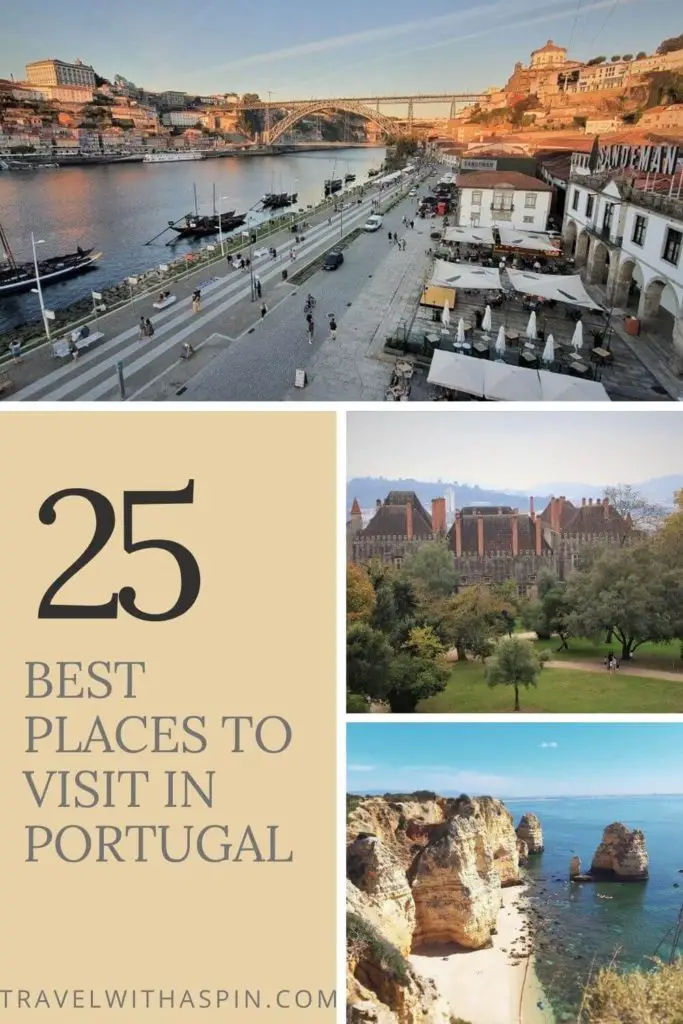
Travel With A Spin contains affiliate links. If you make a purchase through these links, I will earn a commission at no extra cost to you. Thanks for reading!
Leave a Reply Cancel reply
Your email address will not be published. Required fields are marked *

These Are The 22 Most Beautiful Places In Portugal To Visit
By: Author Angela Price
Posted on Last updated: January 22, 2024

If you want to see the best of Portugal but are unsure where to go, I have you covered! There is no shortage of breathtaking places to see in Portugal, and the travel information in this guide highlights towns, cities, coastal areas and national parks. It tells you what to see and do in each destination and tells you why Portugal needs to be the next place you travel to!
Table of Contents
Is Portugal Worth Visiting?
Portugal has a string of great places to visit and is undoubtedly one of the most beautiful countries in Europe. Its temperate climate of hot summer days and mild winters allows visitors to enjoy its world heritage sites, bustling cities, idyllic scenery and delicious traditional food all year round.
And it doesn’t stop there. Add the unique natural landscapes of the stunning islands of the Azores and Madeira and the white sandy beaches that entice visitors to the Algarve, arguably the best part of Portugal to visit, and you can see why Portugal is worth visiting.
Outdoor enthusiasts will love the opportunity to kayak, paddleboard and surf in Portugal’s sea, rivers and lakes, and walkers will love the challenge of the hiking trails in Madeira’s “Levada channels” high up in the mountains.
And let’s not forget the historical landmarks that Portugal is famous for, as well as the modern street art in Lisbon, Porto and Agueda, a nod to the 21st century. One thing’s for sure; there are so many places to visit in Portugal that all you will have to worry about is how long you will stay!
These destination travel guides highlight the best places to go in Portugal. From beaches and national parks to bustling towns and cities, there will surely be a place perfect for you.
This travel guide may contain affiliate links – For more information, please read my disclaimer and privacy policy.
Portugal Location Map
1. Explore Lisbon, the capital city of Portugal

Lisbon, the capital of Portugal, is the perfect destination for a European city break. It is also a great starting point for exploring the rest of the country.
This colourful, cosmopolitan city is chilled but buzzy, cool but cultured and overflowing with things to see and do, making it one of the best cities in Portugal.
Lisbon, which sits on the river Tagus, is a city of hills, which means castles and epic viewpoints. If you’re not into hauling yourself up a hill, Lisbon has the answer in its iconic yellow trams and funiculars.
Take the tram up to São Jorge Castle and check out the fabulous views across the city. Sunset is a good time to do this.
Wind your way down through the cobblestone lanes of the city’s oldest district, Alfama , one of the best places to visit in Lisbon.
Maybe stop for ameijoas a bulhao pato (dish of clams) made with olive oil, white wine, garlic, and bay leaves, and one of Portugal’s popular food dishes .
Look out for colourful tiled walls and listen out for the mournful strains of Fado music seeping out from the shuttered windows of cosy bars and restaurants in Barrio Alto.
Getting around Lisbon
It is really easy to get around using the Lisbon metro . You can take the train to the beautiful Jerónimos Monastery in Belem, a Unesco World Heritage Site.
While you are there, try Pasteis de Belem, Lisbon’s famous custard tarts – one of my favourite things about Lisbon. The bakery is right next door to the monastery!
While in Belem, check out the Monument to the Discoveries, the Belem Tower and the futuristic Museum of Art, Architecture and Technology (MAAT) – and that’s just day one.
And the beauty of visiting Lisbon is that you can enjoy both the city and the sea all in one trip with a visit to the surfing town of Ericeira , a mere 40-minute drive away and one of the best places to visit on the west coast of Portugal.
For more things to do in Lisbon, check out this 3-day Lisbon itinerary . You can also find the best districts to stay in Lisbon in this comprehensive accommodation guide.
If you are looking for weekend breaks from Lisbon, there are plenty to choose from. One of the loveliest places to visit is Castelo Branco . It’s a 2-and-a-half-hour drive from Lisbon and a perfect place to visit, especially in June when the cherry season arrives.
Traveller Tip:
Stay at the 5* EPIC SANA Lisboa Hotel in Amoreiras neighbourhood. This modern hotel has a rooftop infinity pool with fabulous views over the city. It’s also very close to the Metro station or a 25-minute walk to the city centre.

Best Things to Do in Lisbon
Lisbon History, stories and lifestyle walking tour
Buy tickets for the Lisbon Aquarium
Lisbon food and wine tasting tour
Take a day trip from Lisbon to Pena Palace Sintra, and Cascais
2. Discover Porto and its famous wine cellars

Porto is a Unesco World Heritage Site and one of the top 10 places to see in Portugal.
Nestled along the Iberian peninsula and known for being the birthplace of port wine, there are many port cellars in Porto along the banks of the magnificent Douro River, mostly in Vila Nova.
There are, however, so many other things to do in Porto that a 3-night break to Portugal’s second-largest city is a must.
Down by the river in Porto’s trendy Ribeiro district. You will find restaurants, bars and Porto boat tours cruising beneath the city’s six bridges.
Glide underneath the city’s landmark Dom Luis 1 bridge, designed by one of Gustave Eiffel’s students, and marvel at the double-decker pedestrian and vehicle crossing.
Porto is also well known for the white and blue “azulejo” tiles .
Visitors can see them decorating buildings all around the city. One of the things to see in Porto is the beautiful azulejo tiles at the Sao Bento train station. They are worth checking out even if you aren’t catching a train!
Harry Potter in Porto
History lovers will find visiting Igreja de São Francisco and its gruesome catacombs fascinating. At the same time, Porto Cathedral, with outstanding views down to the river, is a must-see Porto landmark.
Harry Potter fans won’t want to miss Librario Lello, the charming bookstore supposedly the inspiration for J.K. Rowling’s novels.
Make sure that while you are in the city of Porto, you try two regional dishes. The first is Francesinha – a sandwich containing melted cheese, cooked meat, tomato and beer sauce. The second is an egg custard pastry called Pastel de Nata available at almost every Porto bakery!

Best Things to Do in Porto
Palacio-da-Bolsa guided tour in Porto
Hear traditional fado music at a live show with wine
Duoro Valley, wine tasting on a day cruise from Porto
3. Take a cruise in the Douro Valley

The Douro Valley is one of Portugal’s most beautiful places, and a Douro River cruise is one of the top things to do in Portugal.
With the gentle river meandering through thousands of acres of terraced vine-covered hills, this idyllic section of central Portugal is the world’s oldest demarcated wine region.
Grapes have been grown in the Douro Valley for over 2,000 years, and the Portuguese authorities set their official boundaries in 1756.
For wine lovers, this is one of the best places to go in Portugal. Visit any number of the port houses and vineyards in the Douro Valley. Some of the best wineries in the Douro Valley , such as Sandeman and Croft, have tasting rooms directly off the main highway.
Another classic Douro activity is to take a trip on a “Rabelo,” a traditional flat-bottomed boat, down the river itself.
A look at Pinhao
Visitors should also stop in the small town of Pinhao. Though it only had one main street, Pinhao is the largest settlement in the region. It has a historic blue-tiled train station and an adorable wine shop that offers tastings and Portuguese pasteis de Nata (custard tarts).
There are plenty of places to stay in Pinhao , but for those looking for true 5-star luxury, the Vintage House set in a former 18th-century wine estate offers the perfect stay in the Douro Valley.
The most popular place to stay in the Douro Valley is at one of the wineries – many of the “casas” operate as a B&B.
You will also find several lovely boutique inns, like Casa Cimeira , dotted along the Duoro River.
If you’re short on time, I recommend a guided day tour. That way, you can learn about the local history and culture, drink an irresponsible amount of port (without worrying about driving), and see the beauty of the Douro Valley from every angle.

Best Things to Do in the Duoro Valley
Visit Pinhão and enjoy a one-hour Rabelo boat guided tour
Best Duoro Valley Tours
From Porto Duoro wine tour with lunch and cruise
4. Visit the historical city of Braga

Less than an hour from the well-known tourist hotspot of Porto is Portugal’s oldest city, Braga. It oozes history, religion and stunning Baroque architecture and is home to Portugal’s oldest religious monument, Sé Cathedral, and other churches.
Day trip visitors to Braga often start the day by venturing out of the city centre, where the UNESCO World Heritage Site of Bom Jesus do Monte sits proudly on top of a hill.
Bom Jesus greets pilgrims and tourists alike with a spectacular staircase of nearly 600 steps leading up to the chapel. There’s a funicular available too, and the surrounding gardens mean it’s a hit with visitors and a landmark not to miss while in Braga.
Returning to the city centre, a trip to Sé Cathedral is a must. A walk through the colourful streets and past traditional tile-covered buildings will undoubtedly lead you to more churches, museums and the all-important street cafes.
Be sure not to miss a walk through Arco da Porta Nova, the beautiful Baroque arch built in the 18th century, and don’t forget to visit Braga Tower, a remnant of the medieval castle of Braga.
To get an authentic feel for Braga, my favourite thing to do is head to one of the markets. Spend a while perusing the different stalls before having a coffee at the popular Café A Brasileira . Come evening; there’s only one thing for it, the traditional Portuguese dish francesinha for dinner.

Best Things to Do in Braga
Braga fun city tour by tuk tuk
Best Braga Tours
From Porto – Braga and Guimarães day trip
5. Wander the cobbled streets of Coimbra
One of the most beautiful towns in Portugal, yet one of the lesser-known UNESCO world heritage sites, is the charming river town of Coimbra, which can be visited from Porto on a day trip.
Steeped in amazing historical monuments, Coimbra is home to the oldest academic institution in Portugal and was once a Moorish stronghold.
There are many interesting things to do in Coimbra , including taking a walk through the quaint streets of the 12th-century University of Coimbra, getting wowed by its stunning architecture (Santa Cruz Monastery and Joanine Library are especially remarkable), and learning all about its Harry Potter legacy.

Wander through the steep yet beautiful historic centre, listen to a soulful Fado rendition, and get some stunning city views across Rio Mondego.
Be sure to carry a good pair of walking shoes because the old town and the university are located on a hill slope, and a lot of walking is involved.
When in Coimbra, try Pastel de Tentúgal, a unique Portuguese dessert from the nearby town of Tentúgal.
Don’t forget to add a half-day trip to the Roman ruins of Conimbriga which are less than 10 miles away. Conimbriga is home to some of the most well-preserved Roman mosaics in the world.

Best Things to Do in Coimbra
Coimbra live fado show with wine tasting
Mondego River kayaking tour
University of Coimbra walking tour
Best Coimbra Tours
Day trip from Porto to Fatima and Coimbra

6. See the Umbrella Sky project in Águeda

Águeda, a small town of 47,000 inhabitants, is located in Portugal, one hour from Porto (63km).
It is famed for the Umbrella Sky Project installation , shading the streets during hot summer days and is one of the most fun places in Portugal.
Hundreds of vibrantly coloured umbrellas cover multiple streets throughout the charming town.
It is probably one of the most beautiful cities in Portugal and gives so many positive vibes. There are also tons of street art and music events making this small town a worthwhile stop on your trip to Portugal.
You don’t need long to see the small village of Águeda – a couple of hours will be plenty. Just wander the happy streets and stop by O Tipico for lunch, indulging in their fantastic food.
Closely situated 30 minutes from Aveiro, “the Venice of Portugal” is known for its canal resembling Venice. You can stay overnight in Aveiro as there may be more options as it’s a bit larger town.
If you up for visiting off-the-beaten-track destinations, then Águeda is for you! It is definitely one of the lesser-known places to go in Portugal and so very unique.

7. Visit the Unesco World Heritage Site of Evora

Step back in time to the ancient city of Evora. Narrow cobbled streets wind through a maze of local shops, ornate churches, outdoor cafes and Roman ruins.
This UNESCO World Heritage city dates back over five thousand years and has been inhabited since the 2nd century B.C.
The walled city sits 83 miles south of Lisbon and is a good halfway point to the Algarve. It is surrounded by the picturesque Alentejo region known for its olive fields and traditional villages.
Evora’s 16th-century whitewashed buildings are decorated with wrought-iron balconies and azulejos tiles. Open-air shops sell cork products, ceramic tiles and other regional keepsakes.
Evora is known for its 1st-century Roman ruins and The Templo Romano Evora, which boasts 12 original stone pillars.
This walkable historic city is also known for its grand churches, and there are several must-see tourist attractions in Evora. Igreja de Sao Francisco is decorated in carved wood and azulejo tiles.
A visit to the eerie Capela dos Ossos, Chapel of Bones, is off the main cathedral and one of the unusual things to do in Portugal. Several thousand bones and skulls decorate the walls and pillars. It is said to be a reflection of the transience of human life.
The stunning 1204 A.D. Cathedral of Evora is one of the area’s oldest buildings, with rooftop views overlooking the city. The painted scenes of Angels and carved gold decor surrounding the 1580s Igreja da Graca make it a Portugal must-see.
Rua Alcarcova de Baixo is a popular evening hotspot with bars, cafes and outdoor seating.

Best Things to Do in Evora
Evora Tales and Legends Walking Tour
Best Evora Tours
From Lisbon – full-day Evora tour with wine tasting
Evora and Megaliths day tour from Lisbon
From Lisbon – Evora and Monsaraz day tour
8. See the picturesque canals of Aveiro

Only one hour from Porto by train, the charming city of Aveiro makes for an easy day trip or interesting stopover when driving between Lisbon and Porto.
Dubbed the Venice of Portugal, Aveiro is renowned for its picturesque canals and painted gondolas known as Moliceiros. Ferrying visitors along the maze of waterways in the city centre, a trip on a traditional boat is one of the highlights of visiting this seaport city.
Besides its rich maritime history of primarily cod fishing, Aveiro charms with elaborate Art Nouveau buildings, engaging museums and a wealth of cafes and restaurants lining the main waterway.
Stroll the quaint side streets to discover traditional Portuguese tiles adorning the old train station and many homes, churches and shops in the city.
Visit the salt pans in the Aveiro lagoon and the open-air eco-museum to discover the region’s history and traditional methods of salt production.
Pop into the famous Aveiro Fish Market to see the frantic action of the day’s catch being unloaded and try some of the region’s famous seafood dishes. And don’t miss sampling the sweet egg-yolk treat of Ovos Moles, the regional delicacy that pairs perfectly with coffee.
Whilst Aveiro offers visitors a wealth of laid-back activities, it is undoubtedly a “moliceiro” boat ride through the city canals that is a highlight and favoured activity from all who visit – not to be missed!
The elegant Hotel Moliceiro with delightful views over the central canal is a fabulous upmarket choice for those wishing to stay the night.

Best Things to Do in Aveiro
Traditional Moliciero boat tour in Aveiro
Aveiro boat trip and city highlights walking tour
Best Aveiro Tours
Aveiro half-day tour with cruise from Porto
From Porto: Aveiro, Paiva Walkways and Arouca 516 Footbridge
9. Enjoy the beach at Costa Nova Do Prado

Often mistaken to be in Aveiro, the beautiful beachside town of Costa Nova is actually a short drive away.
Surfers and wind-surfers favour Costa Nova for its magnificent waves and stunning beach. However, the magnet that pulls photographers and tourists to Costa Nova is the candy-striped houses that line the strip of land between the lagoon and the beach.
Once used as storage and shelter for fishermen’s equipment and boats, these shelters had no separating floors when first built. Over time, the fishermen added levels to enable families to live together.
These iconic traditional houses, known as “haystacks’ to the Portuguese, are now privately owned as holiday homes and holiday rentals.
If you want to stay in one of the candy-striped buildings, the M Costa Nova has been restored and has sea views.
You should visit the Fishing Market while in Costa Nova. Freshly caught shellfish from the lagoon is prepared and served immediately.

10. Visit the fairytale Pina Palace in Sintra

Sintra is a special place and, without a doubt, one of Portugal’s best places to visit.
The town has been the home of the Portuguese royal family, Moorish princes, and eccentric millionaires since the 10th Century. They’ve all left behind some of the most magnificent fairytale castles and palaces in Europe that have made Sintra a UNESCO World Heritage Site.
Pena Palace is the most famous castle in Sintra , with its red and yellow towers visible for miles around.
If you want to look inside the palace, you need a ticket; otherwise, you can admire the palace from the outside. There are extensive gardens, and the view outside the palace is probably sufficient for most people.
The Moorish Castle has splendid views of the countryside and Pena Palace and has a fascinating history.
La Quinta de Regaleira was a private home whose owner designed the gardens to create a mystical wonderland.
You might recognise the Well of Initiation from photos on Instagram – it was used for ceremonies possibly related to the Freemasons or Tarot – whatever its purpose, don’t miss exploring the gardens. The Sintra National Palace and the Palace of Monserrate are other popular attractions here.
Many people visit the magical town of Sintra on a day trip from Lisbon , but you will have more time to explore if you spend at least one night here.
If you have the time, a drive through the Parque Natural de Sintra-Cascais to Cabo da Roca on the coast is also worth the effort.
Make sure to watch the sunset from the Moorish Castle, the views are incredible!

Best Things to Do in Sintra
Pena Palace and park entrance ticket
Quinta da Regaleira skip-the-queue ticket with audio tour
Best Sintra Tours
From Lisbon day trip to Sintra, Cabo da Roca and Cascais
11. Walk the historic city walls in Obidos

You feel like you’ve gone back in time when you visit Obidos , about an hour north of Lisbon. It’s a small, well-preserved medieval town with much to offer visitors.
City walls surround the town, much like Dubrovnik in Croatia . They are pretty impressive to see but even more spectacular to walk on. You get terrific views of Obidos and the surrounding countryside.
Allow at least an hour for this walk, then treat yourself to the local cherry-flavoured liquor, Ginja served in a chocolate cup.
Many stands sell Ginja and other souvenirs along the town’s main road. Nearby, venture inside the Santa Maria Church, where King Afonso V married his cousin Isabel in 1444.
The best time to go to Obidos is in July when they have the Medieval Festival. You can bring a medieval costume or rent one during your visit. The highlight is their medieval feasts on Friday and Saturday evenings.
You can easily visit Obidos on a day trip if you have a car or take the bus. There are also many organized tours from Lisbon.
However, why not stay longer at the luxury hotel Pousada Castelo de Obidos in the town’s medieval castle?
I loved the city wall walk, but there were times it was a bit scary without a handrail. Don’t let that deter you, just be careful; the views are worth it.

Best Obidos Tours
From Lisbon – Fatima, Obidos, Batalha, and Nazare Group Tour
12. Take in the sea air at Viana do Castelo

Viana do Castelo is a charismatic coastal city in northern Portugal, 70km from Porto. It is a city bathed by the Atlantic Ocean and the Lima River.
The city has a strong tie with the sea, with a big port. It was known for its shipbuilding and essential role in cod fishing campaigns.
But besides the beach and the river, the city has a charming old medieval city centre with plenty to do. You will find the costume museum in the city centre, where you can admire different local costumes.
Viana do Castelo is also known for its jewellery, the famous heart of Viana, a golden heart with a beautiful design in filigree.
You must visit Santa Luzia Basilica atop the hill outside the centre. From the Basilica, you will find breathtaking panoramic views overlooking the city of Viana do Castelo, the Lima River, and the shoreline.
Another top attraction is the Gil Eanes Hospital Ship, a former hospital ship converted into a museum. Here you will learn about Portugal’s brave history in the cod fishing campaigns.
Finally, you can spend time on the beach, surfing or sunbathing, or drive to Ponte de Lima, 30km from Viana do Castelo, one of Portugal’s oldest and most charming towns.
Viana do Castelo is also the perfect place to eat fresh fish, which is always delicious. But, our top tip is to try the “Bolas de Berlim” (Berliner) in the Natario pastry shop.

Best Things to Do in Viana Do Castelo
Viana do Castelo kayak tour at Lima river
Viano do Castelo Vez river SUP tour with transfer options
Best Viana Do Castelo Tours
From Porto – Viana Do Castelo and Ponte Lima private tour
13. Enjoy outdoor adventures in Porto Covo

One of the standouts of an impressive line of terrific fishing villages along the southwestern coast of Portugal, and only a 2-hour drive from Lisbon, is lovely Porto Covo .
With fantastic trails along the photogenic cliffs up and down the coast, hikers and bikers will find plenty to occupy them.
Like most places along Portugal’s Atlantic Coast, surfing is a top Portugal pastime and one of the many outdoor things to do in Porto Covo.
Several top beaches within walking distance of the village offer a nice variety of scenic, sheltered and wild surf.
Praia Grande is a big, beautiful stretch of sand next to Porto Covo that gets busy mid-summer but usually still has plenty of room for everyone to spread out.
Meanwhile, in the other direction, Praia dos Buizinhos is a picturesque jumble of rocks great for photos and collecting seashells.
Visitors can find the best surfing in Portugal at Praia de Vale Figueiras.
Further south, the old ruins at Praia da Ilha do Pessegueiro are perfect for history lovers and anyone fascinated by the remains of Forte do Santo Alberto, which are still noticeable on the small offshore island.
A guided day trip from Lisbon highlighting the southwest coast of Portugal is a good way of seeing Porto Covo if you are strapped for time.
There is a good selection of local Portuguese restaurants specializing in excellent seafood in the gorgeous, whitewashed old town centre. With mild winters and hot, sunny summers, Porto Covo is a superb choice nearly all year round.
Parque Campisimo Porto Covo offers a wide range of accommodation from comfortable suites with kitchenettes, to camping and RV spots.

14. Wander around Faro, the Algarve’s charming capital city
Faro is the capital of the Algarve but is often regarded as simply the gateway to Portugal’s beach resorts. Before heading to other places in the Algarve, take some time to explore the charming town of Faro.
Start by wandering along Faro’s streets lined with whitewashed buildings. Stop to peek inside traditional shops selling Portuguese handicrafts and delicacies.
Then on to the Cathedral of Santa Maria with its bone chapel and bell tower. Climb to the top for an amazing view over the town of Faro and the natural park of Ria Formosa.

Afterwards, check out the ancient Roman and Moorish city walls, where you will find Faro Cathedral and Arco da Vila, the ornate city gate.
And don’t forget there are beautiful beaches in Faro. A quick 25-minute walk from Faro’s train station will find you on one of the best beaches in Portugal (Praia de Barreta). Favoured by windsurfers and sailing enthusiasts, it is the perfect spot to unwind after exploring the town of Faro.
If you want somewhere special to eat in Faro, look no further than Ria Formosa Restaurant on the rooftop of Hotel Faro . The food is amazing, and the views across the harbour are sensational.
Best Things to Do in Faro
Fado show at the Municipal museum
Faro Old Town guided walking food tour
Hop-on Hop-off Faro city tour by tourist train
Best Faro Tours
From Faro – Dolphin watching and wildlife
Deserta Island and Farol Island catamaran boat trip from Faro
From Faro – Ria Formosa sunset boat trip
From Faro – Benagil Cave and Marinha Beach guided day trip
15. Discover Estoi, a hidden gem in the Algarve

Another great place to visit and a quick 15 minutes by taxi from Faro is the town of Estoi.
A hidden gem in the Algarve, this sleepy town has the most beautiful restored 19th-century pink facade palace turned into a luxury hotel called Pousada Palacio de Estoi. It reminds me of the Villa Ephrussi on the French Riviera.
You can wander around the hotel grounds and enjoy a refreshing drink under its pastel bougainvillaea trees before checking out the mosaics and Roman Ruins of Milreu, a short walk away or a herb tour at Dias de Aromas.
16. Stroll through the historic streets of Tavira

Visit Tavira, one of Portugal’s prettiest towns in the eastern Algarve region, and you’ll step back in time. This hidden gem is a mere 30 kilometres from the Spanish border. As you ramble through its old streets and alleyways, one cannot help but fall under its spell.
It has virtually remained unchanged over time. Its traditional Portuguese characteristics and Moorish influences are still very much everywhere. Beautiful latticework doors and the Moorish-influenced door knockers in the shape of hands to the colourful azulejo tiling to the low whitewash buildings.
Don’t miss some of Tavira’s key historic buildings . The 16th-century Renaissance church (Church of Mercy). The 13th-century Gothic-style church (Church of Saint Maria), or the seven-arched Roman bridge spanning the slow-flowing river of Gilão from the 1100s.
After you have explored the charming old town, it’s time to head to the beach! Tavira offers a beautiful coastline with several golden sand beaches with warm turquoise water.
The beaches are a short ferry ride away, separated from the mainland by lagoons and waterways, part of the Parque Natural da Ria Formosa.
Don’t miss the incredible sight of the Parque Natural da Ria Formosa. It is considered one of the 7 Natural Wonders of Portugal.

Best Things to Do in Tavira
Cabanas de Tavira dolphin watching boat tour
Tavira tuk tuk city tour
Tavira hop-on hop-off tourist train
Best Tavira Tours
From Albufeira full day tour of Faro, Olhão and Tavira
17. See the famous cliffs and beaches of Lagos

One of the best places to visit in Portugal is the lively town of Lagos in the western Algarve. It is also one of the best places in Portugal for families, with its sandy beaches and shallow waters.
Jam-packed with fun water activities, beautiful beaches such as Meia Praia, and surrounded by nature, there are many things to do in Lagos , making it one of the best coastal towns in Portugal.
Head to the incredible cliff formations at Ponta da Piedade or to the westernmost spot of Portugal to see the Sagres cliffs and castle.
You can also take a boat trip to explore the incredible Algarve rock formations and caves from the water. Lagos is also perfect for learning how to surf, with some of the best surf spots in Europe close by. Or maybe you want to learn to scuba dive to discover hidden cave systems?
Lagos’ historic old town is quaint with a chilled vibe that attracts tourists from all over Europe and is often voted as one of the top 10 places to visit in Portugal.
Lagos is excellent for bars with live bands and has lots of restaurants. You can find anything from ecological vegan food to local dishes. It is also a good destination for solo travellers hoping to meet other like-minded travellers.
Traveller Tip:
Especially spectacular is Benagil Cave! It’s only a short boat drive away, but to enter the actual cave, you have to go by SUP or kayak. Consider a day trip to Benagil beach and see the caves from there.

Best Things to Do in Lagos
3-hour classic Algarve food tour
Kayaking and boat cave explorer tour
Boat cruise to Ponta da Piedade
Algarve catamaran cruise
Lagoa Slide and Splash Waterpark entry tickets
18. Explore the incredible Benagil caves in Carvoeiro

Carvoeiro is a beautiful small fishing town on the western Algarve coast of Portugal. Most Algarve tourists visit for a relaxing beach holiday, but one of the best things to do in Carvoeiro is to visit the Benagil caves and a trip to the port town of Lagos.
The stunning Praia de Carvoeiro beach is one of the most beautiful beaches in the Algarve.
Along with golden sands and rock formations, you’ll find small caves in the bay for those who like exploring. Carvoeiro is an excellent holiday destination for families and one of the best places to go in Portugal for couples. It is an easy day trip from Albufeira or Ferragudo.
You’ll also find a mix of the younger and older generation during the summer when Carvoeiro can get quite busy.
It is quiet during the off-season and mainly caters for holiday visitors who come to relax on the golden beaches and enjoy Carvoeiro’s restaurants without the crowds.
Perched on the cliffside and offering stunning bay views is one of the popular Carvoeiro hotels, named Tivoli Carvoeiro.
If you plan on taking a day trip to Carvoeiro, make sure you arrive early to park. It can be challenging to find a spot on the narrow Portuguese streets, especially in peak season.

Best Things to Do in Carvoeiro
Benagil caves kayaking experience
Benagil Caves sunrise paddleboarding tour
Caves, coves and secret beaches Benagil kayaking tour
Best Carvoeiro Tours
From Portimão – Sunset Cruise to Benagil Cave
From Portimão – Pirate Ship Cave Cruise
Benagil Hidden Caves Tour by Kayak or SUP from Albufeira
Benagil sea cave tour with local guide from Lagos
From Vilamoura – guided sightseeing cruise of Benagil caves with beach BBQ and drinks
19. Visit Ria Formosa Natural Park, a must for nature lovers

Ria Formosa is a protected natural park in the northern Algarve region.
Stretching over 60 km of the Algarve coastline and covering an area of 18000 hectares, Ria Formosa Natural Park is a patch of mudflats, marshes, and a lagoon dotted with sandy beaches. The national park also includes five barrier islands and two peninsulas, all of which are one of Portugal’s seven natural wonders.
With a unique environment and rich biodiversity, Ria Formosa makes an ideal home for various flora and fauna. The lagoon is also the winter home for as many as 20,000 migratory birds crossing between Europe and Africa. Visitors can see ibis, flamingoes, herons, egrets, white storks, and many other bird species throughout the year.
Faro, Tavira and Olhao are the main towns located within or close to the natural park, making them an ideal base to explore.
As far as exploring Ria Formosa, there are many ways to do it. You can take boat and photography tours, which take roughly 5 hours.
You can also take boat trips to explore the five barrier islands. Alternatively, enjoy the walking trails through the pine forest and muddy marshes. You can also hire a kayak, stand-up paddle or snorkel in the waters; the options are truly unlimited.

Best Ria Formosa Natural Park Tours
Ria Formosa Faro Islands catamaran cruise
Segway Tour and Birdwatching in Ria Formosa Natural Park
From Faro – 4 stops, three islands Ria Formosa catamaran cruise
From Olhão – 4 hour Ria Formosa Island Tour
20. Explore Madeira, Portugal’s Golden Island

Madeira lies over 1000 kilometres southwest of Portugal and enjoys a temperate climate all year round. The tropical Atlantic Island is an affordable and diverse destination.
Visitors can explore the city’s parks, museums and churches in the charming capital, Funchal , known for its purple jacaranda trees and black and white mosaic pavements. Alternatively, enjoy newer attractions like the CR7 museum (dedicated to local hero Cristiano Ronaldo) or Aquapark Madeira.
Take a scenic cable car ride from Funchal’s long promenade to the colourful Monte Palace Tropical Gardens . Return to Funchal with a thrilling ride on Monte’s iconic wicker toboggans, followed by a glass of Madeira wine to steady your nerves.
The rest of Madeira Island offers something for everyone. Swim in naturally formed pools at Porto Moniz, explore the lava tubes at Sao Vicente or learn about Madeiran culture at Santana Theme Park. Relax on a sandy beach in Calheta or tackle one of Madeira’s famous Levada hikes.
Keen hikers travel to Madeira worldwide to walk these scenic trails along the levadas (irrigation channels) that crisscross Madeira. Choose between mountain trails, on the coast or through dense forest.
Most visitors stay in Funchal, where the major attractions can be visited on foot, but we enjoyed a rural stay in Estreito da Calheta in the sunny southwest of the island.
If time permits, add a few days to your Madeira holiday itinerary and head to Madeira’s sister island, Porto Santo. Here, you will find idyllic golden sandy beaches and a laid-back vibe across the island.
There is a levada hike for everyone. A picturesque and varied hike is Levada do Risco.

Best Things to Do in Madeira
Madeira skywalk, Porto Moniz volcanic rocks and Fanal tour
Dolphin and whale watching by luxury catamaran
Madeira’s best of the East tour from Funchal
Rabacal levada hike and jeep safari from Funchal
Nuns Valley, Monte and sleigh ride tour from Funchal
21. Visit the Azores, Portugal’s Green Island

São Miguel, known as “Green Island,” is the largest of nine islands in the Azores archipelago, off mainland Portugal. It is known for its lush green landscapes and natural hot springs and is a wonderful holiday destination, particularly for travellers searching for an epic outdoor adventure.
Begin your Azores holiday by flying into the main Azores airport in Ponta Delgada, São Miguel’s capital city. Explore the striking streets and cobblestone squares on foot, or take to the waters of the North Atlantic Ocean.
Several companies at Marina Ponta Delgada offer water sports rentals and other activities like dolphin swimming and whale watching tours. Or join a private group island tour to see some of the hidden gems on São Miguel island.

Make a trip northwest from the capital to the twin crater lakes of Sete Cidades.
Hike to jaw-dropping lookouts like Miradouro da Boca do Inferno or, if the weather allows, rent a kayak or SUP board and take in the view of the blue and green lakes from the water.
Finally, head to Furnas in the east to take a dip in the island’s famous hot springs.
While you’re here, try a quirky cup of purple tea at Chalet da Tia Mercês and delicious Cozida das Furnas or volcanic stew. This traditional stew is cooked underground with heat from the natural volcanic cooking holes and is available at many Portuguese restaurants.
No matter when you visit São Miguel, the weather can be wildly unpredictable – a fair price to pay when visiting a gorgeous volcanic island in the middle of the North Atlantic. Be sure to pack accordingly!

Best Things to Do in the Azores
Sao Miguel swimming with dolphins
Half-day whale-watching trip
Sao Miguel West full-day van tour with lunch
Furnas night thermal pools and dinner
22. Be at one with nature in Peneda-Gerês National Park

Peneda-Gerês National Park is Portugal’s only national park and one of Portugal’s most famous landmarks .
It is situated in the north, close to the Spanish border. In addition to the stunning natural landscape, at Peneda-Gerês, you can also discover the region’s impressive biodiversity, embark on some adventure sports such as canyoning or rafting, go bird-watching, and swim in turquoise lagoons, or hike and take in the views.
It’s easy to spend a day exploring on your own or with the support of a local guide. Either way, it’s the perfect day trip from Porto. Visiting on your own, you’re able to go at your own pace; however, the local guides know all of the best things to do in Gerês , including finding great spots for swimming or photo opportunities.
Some companies that offer small-group tours of Peneda-Gerês are also involved in local sustainability efforts, such as Oporto Adventure Tours. These tours will often include local lunch in an authentic village and time for swimming in the lagoons, with a portion of ticket revenue dedicated to reforestation in the park.
There are many entrances and routes/trails throughout the park, so research your routes beforehand if you plan on going without a guide.
Bring binoculars! Many visitors often tout the lagoons, activities, and trails without doing much service to the local flora and fauna of the region. You may even be able to spot the elusive and endangered Pyrenean desman, a relation of the mole and shrew!

Best Things to Do in Peneda-Gerês National Park
Self-guided electric bike tour in Peneda-Gerês National Park
2-Hour buggy tour in Peneda-Gerês National Park
Best Tours to Peneda-Gerês National Park
From Porto – small group day tour to the national park
From Porto – Peneda-Gerês National Park canyoning tour
Peneda-Gerês waterfall hike and kayaking from Porto
And there you have it! Twenty-one sensational places to visit in Portugal! Have you found a favourite Portuguese destination to add to your travel list? Let me know in the comments box below.
Do you need to arrange travel insurance, car hire or accommodation? Please check out my resources page to help you plan your trip.
Please Pin for Future Travel to Portugal

You May Also Like to Read:
10 Beautiful European Destinations to Visit
I would like to receive occasional updates and new travel posts.
Notify me of follow-up comments by email.
Friday 26th of November 2021
Interesting post! These sensational places to visit in Portugal do make me feel like visiting there. Next month, it's Christmas so I might visit there with my lovely wife and celebrate Christmas together.
Tuesday 25th of May 2021
Useful, detailed post, thanks. Some new places added to our list!
Sunday 23rd of May 2021
Such a great post, can't wait to get back to Portugal and visit some of these places!
Love this post! Some beautiful little spots to add to my list!
WhereAngieWanders
I'm glad you found some new places to visit in Portugal - there certainly are a lot of really beautiful places to explore.
47 Reasons To Visit Portugal In 2024
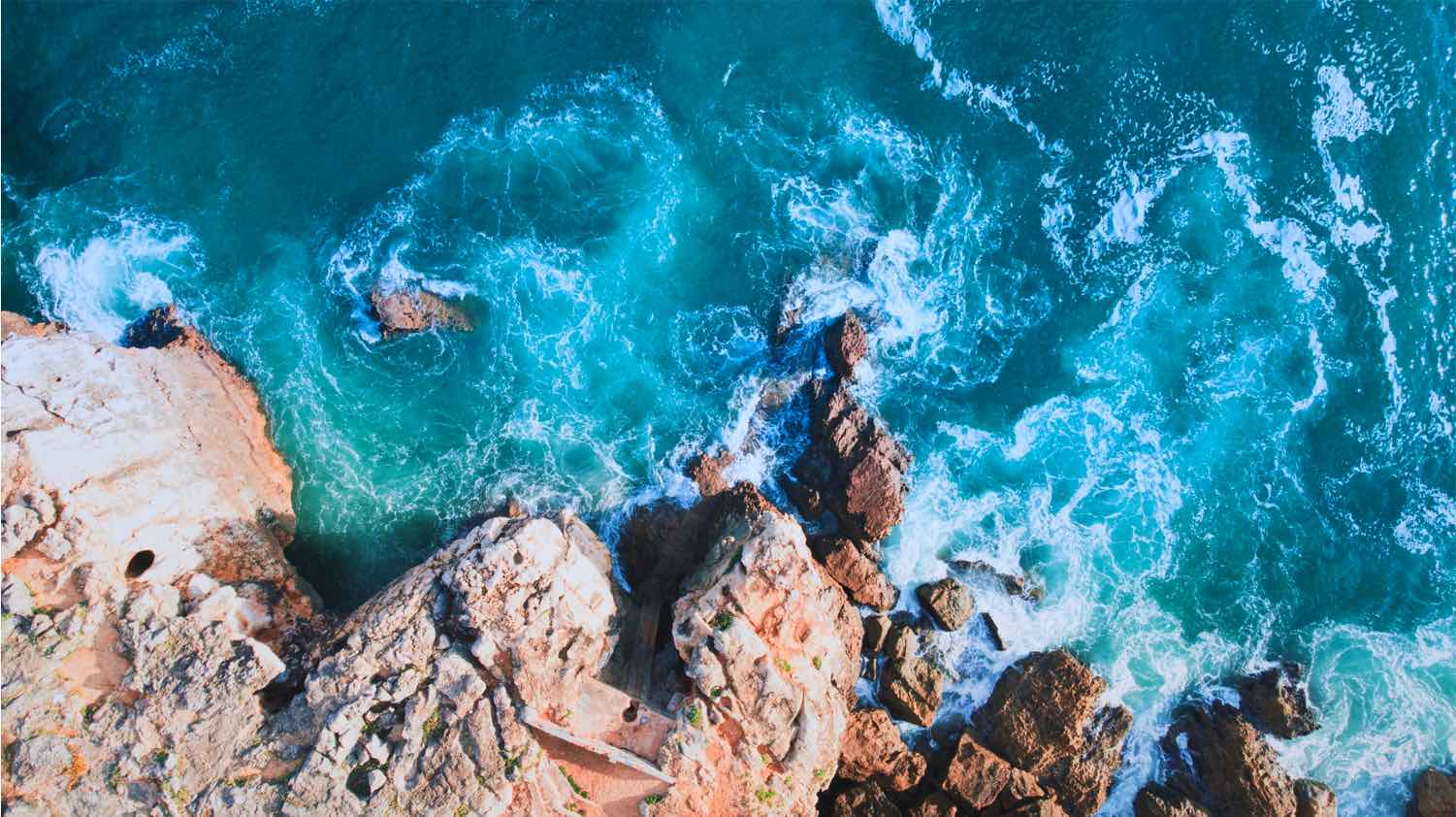
Oh Portugal. Lately, my home country has stepped directly into the bucket lists of millions of travelers. Why? Here are dozens of reasons to visit Portugal as soon as possible! .
Forgotten for decades in the shadows of Southern European giants like France, Italy or Spain, Portugal has been the trendy place to go in the past years. But… why?
I have compiled dozens of reasons to make you travel to Portugal this year. My secret goal is to make you book a flight before you even finish the list!
Note: this post was fully updated for 2024.
1 The sun sets in the sea.
A small detail that makes all the difference. Luckily Portugal has the majority of its awe-inspiring coastline and beaches facing west , which happens to be the orientation the sun sets every day.
Visit the coastline and sunsets will be amongst the most fantastic memories you’ll have from your stay.
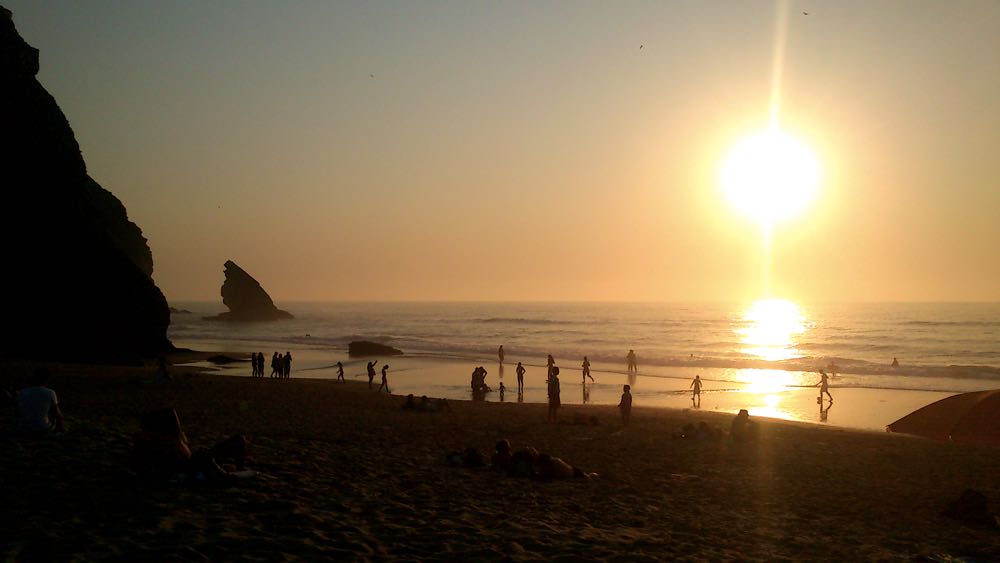
2 Trams make everyone happy.
Life in Portugal’s major cities has been beautified by historical trams running all over the downtown in the past century. Particularly in Lisbon, it’s impossible not to smile when seeing the yellow lovely vehicles going up and down the hills.
While trams are a definite eye-candy, there are some lines who are known to be uncomfortable and a pickpocketing paradise .
3 The coffee is damn good.
This association might not be immediate, but if I say that back in its glorious days, Portugal colonized Brazil, Angola, and East Timor – producers of some of the finest coffee – things make more sense.
You’ll never find a better value-for-money relation for coffee in Europe. A good quality espresso will cost you no more than 1 EUR.
4 You can live a fairytale in Sintra.
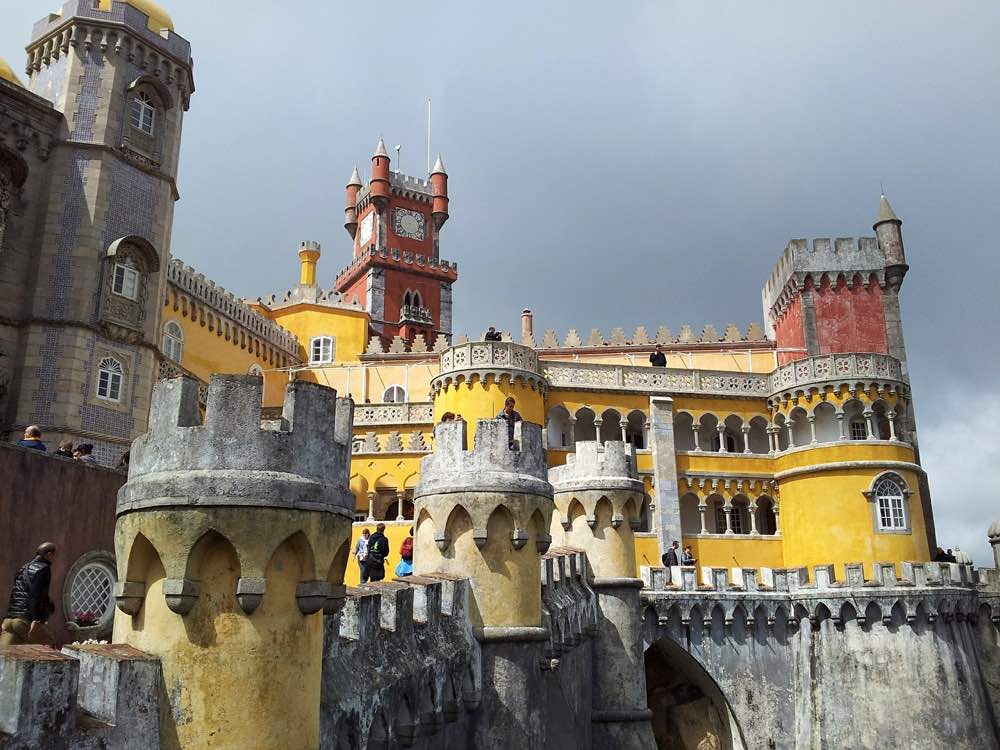
Only a 40-minute train ride from Lisbon , this little hilltop town is an impressive display of elegant palaces, castles, and fortresses all in the spectacular setting of the Sintra-Cascais Natural Park .
The romantic architecture of Palácio da Pena is not to be missed and is the closest real-life example of a Disney castle (well, apart from Disneyland).
5 The fish is uber fresh.
Vegetarians can skip this one. More than 800km of coast, the biggest fishing zone in Europe and laughable prices make of Portugal one of the most fish-friendly places you’ve ever been.
Fish species to try in Portugal 🐟
- Bacalhau (codfish) – they say there are 1001 ways of cooking bacalhau in Portugal and I wouldn’t be surprised if it was true. Try bacalhau à brás (with eggs, potatoes, and onions), bacalhau com natas (with whipped cream) or simply pastéis de bacalhau (in a deep-fried dough).
- Dourada (sea bream) – normally served grilled or baked in the oven with mashed potatoes and/or vegetables.
- Sardinha (sardine) – a Portuguese classic, these are normally done in the grill and served with a salad or potatoes.
- Robalo (sea bass) – normally served grilled or baked in the oven with mashed potatoes and/or vegetables.
6 Cobblestone streets are everywhere.
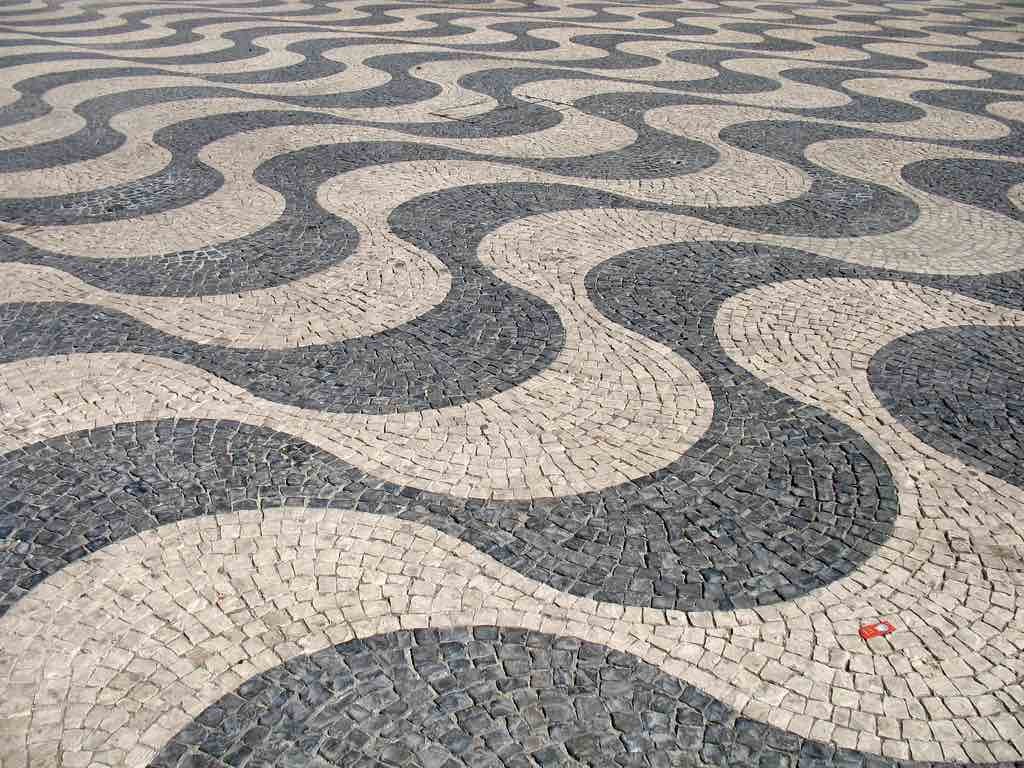
Calçada Portuguesa is the type of mosaic floors that part of urban planning in the major cities of Portugal (and also in Portuguese-influenced places like Rio de Janeiro ). Personally, I think they’re crazy expensive, and I can see myself easily twisting an ankle when of the stones gets loose. And I don’t wear high heels.
That said, I’ll admit the patterns and designs in some of them are quite stunning and make a square or street really come alive. Walking in Portugal is literally walking on art!
7 Santos Festivities will rock your world.
Portugal has all kinds of music festivals, art events, and parties but this is the real authentic thing. In June, residents from both Lisboa – Santo António festivities – and Porto – São João festivities – flock to the most traditional neighborhoods for the festivities in honor of the local saints.
You don’t need to be religious to join the party though. Expect lots of popular Portuguese music ( pimba ), lots of grilled sardines and a party that lasts until dawn.
Santos festivities in Portugal 🎉
- Santo António (Lisbon) – held on the night of 12th to 13th of June. There are events and street parties during the entire month of June though – check Festas de Lisboa website .
- São João (Porto) – also happening throughout June, but the big night is the 23rd. Bring a plastic hammer to the party! (I’m serious)
8 It’s possibly Europe’s best climate.
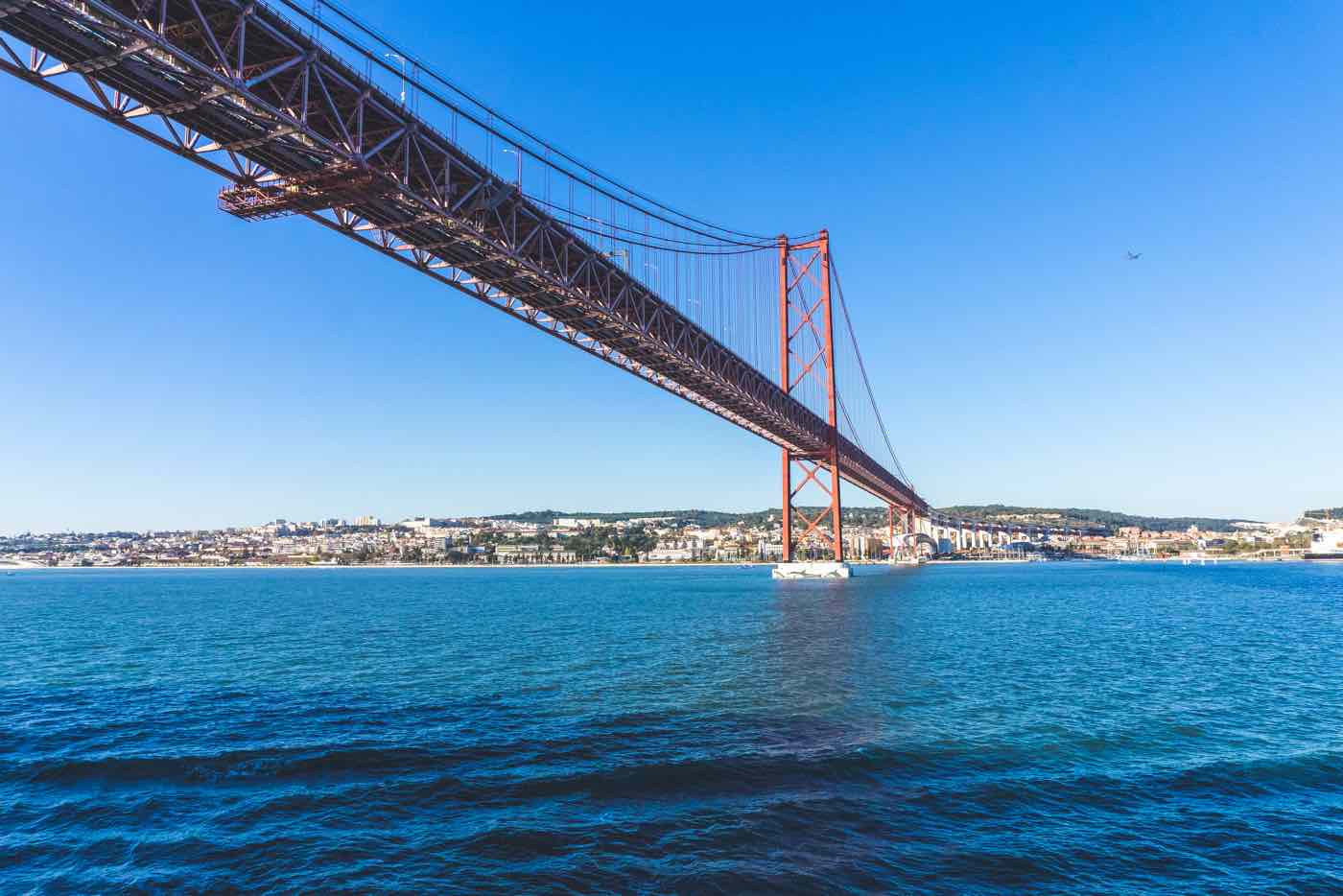
Mild winters with temperatures rarely drop below 5ºC along the coast, hot summers refreshed by the Atlantic breeze and the highest number of hours of sunshine in Europe. Hard to beat this.
9 Azulejos are your next design obsession.
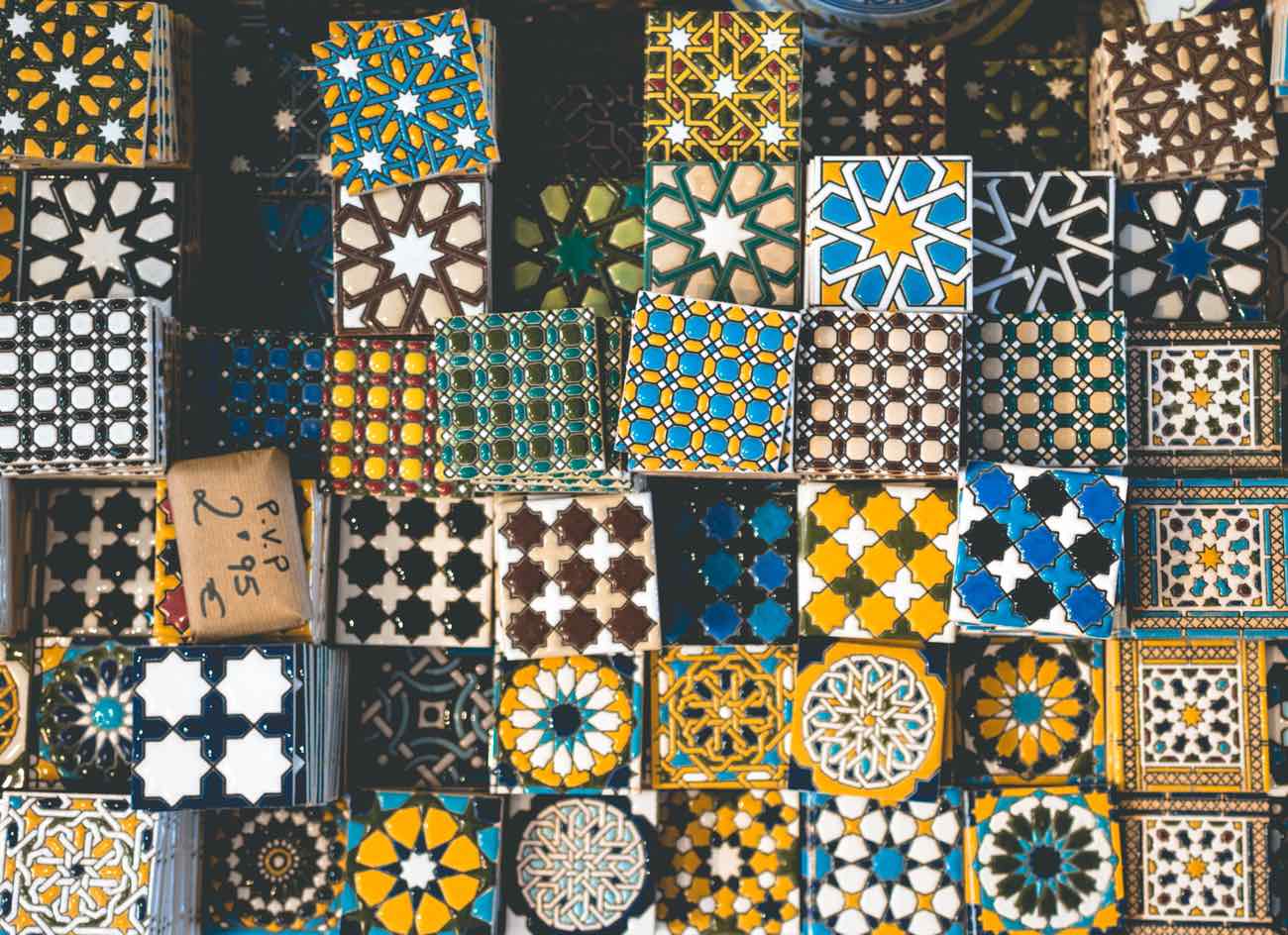
I reckon there’s no other place in the world where #tileart is so popular. Prepare to find elaborate-painted tiles on the historical buildings, modern design installments and even souvenirs shops.
There’s even a tile museum which is one of the hidden gems of Lisbon !
Careful where you buy the tiles from though. In recent years, a parallel business consisting of ripping tiles off from walls and sell it in places like street fairs and markets – e.g. Feira da Ladra , in Lisbon – has arisen.
10 We are serious about wine.
Despite the famous Port Wine, Portugal seems to be in the second-tier in the wine world, right after France, Italy, and Spain. And yet, Portuguese wines win the most prestigious awards every year.
Chances are there is a great quality wine at a very reasonable price waiting for you. My favorites are any kind of vinho verde , the white wines from Alentejo and the red wines from the Douro region .
11 You’ll fall in love with Porto.
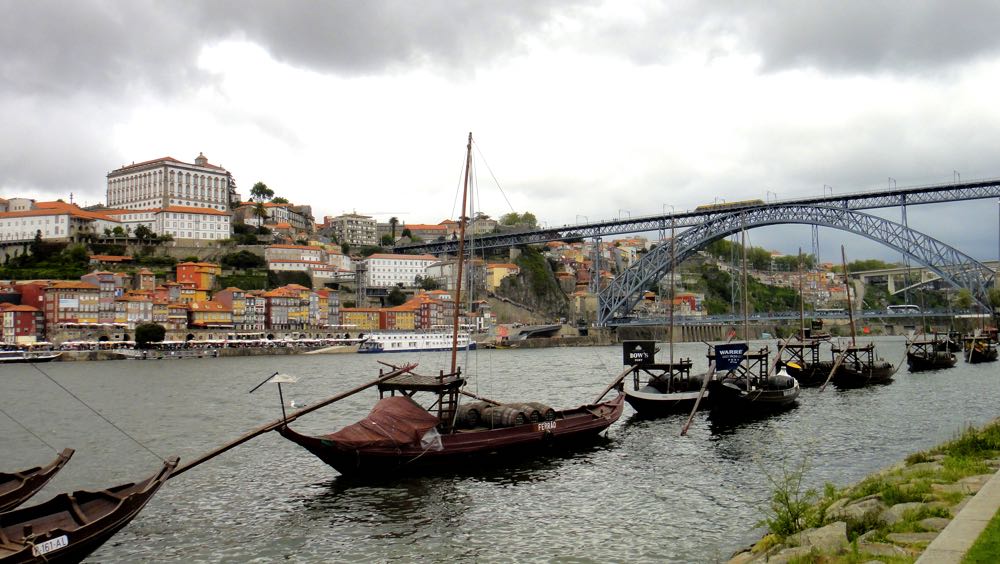
Speaking of wine, the second-largest city in Portugal has renewed itself in recent years and is becoming a serious European city break destination. People are amongst the friendliest in the country, food is great, prices are even better and the city is settled in a serious romantic setting. What’s there not to like?
Check out my Porto travel guide for dummies and my detailed weekend itinerary I use to show the city to friends and family visiting.
⭐ My top value-for-money suggestions to stay in Porto ⭐
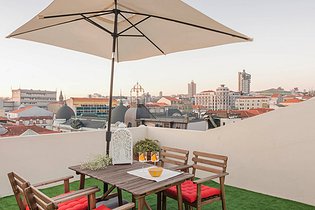
Or search on your own
To make your life easier, start searching with my pre-selection of best value-for-money hotels in Porto . This list only includes rooms in the best areas of downtown Porto , with WiFi and good-to-excellent reviews.
12 Pastéis de Nata are a feast to your taste buds.
A lot is said about pastéis de nata (custard tarts). I’ll just say if you leave the country without trying this wonder of the world of pastry, something is profoundly wrong with you. For foodies, it may be one of the strongest reasons to visit Portugal. My favorites are in Manteigaria, in both Lisbon and Porto.
13 It’s the ideal place to learn or master the art of surfing.
If you are into surf, the wild uncrowded Atlantic waves, mild climate and the huge community of surfers and surf camps should easily seduce you. Nazaré , Peniche , Ericeira and all the coast of Alentejo are amongst the hot spots of surfing in Portugal.
Recently, the Azores also have been discovered as a surfing hotspot and São Miguel is now the location of a stage of the World Surf Championship.
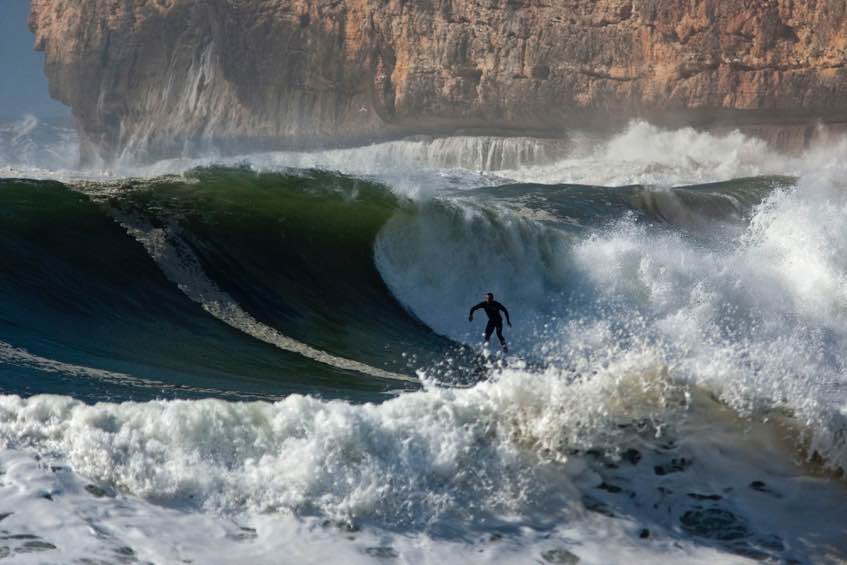
14 We actually can communicate with you.
Portugal has more fluent English speakers than any other southern European country. Due to subtitled (and not dubbed) movies and TV series, younger generations, in general, are all able to speak good English and with quite a spot-on accent. Older people tend to have English and French as their second language. Anyway, the point is: we get what you’re saying.
15 Fado music will make you emotional.
Fado is probably the most melancholic and deeply emotional music you’ll ever hear and still somehow makes the ideal soundtrack for every trip to Portugal. Even if you don’t understand a word, it has the power to make you introspective. The new generation of singers like Ana Moura and Mariza is making fado sexy and modern.
16 We are professionals on the activity of going to the beach.
You’ll probably know Portugal’s beaches are among the country’s highlights, it’s in every postcard and travel brochure. What I particularly enjoy is their diversity. Whether you go for the wild beaches of Costa Vicentina – for a roadtrip in the beautiful Portugal’s coastline -, the volcanic dark sands of the Azores or the balmy beaches surrounded by towering cliffs in the Algarve , you can be sure to be laying your towel in a top-notch beach.
17 Days are brighter.
Apart from being one of the places with more hours of sunshine per year, Portugal is also where the light comes from anywhere. The buildings normally have light-colored walls, there is bodies of water close by, and even a large area of the streets has light marble. With that amount of light available naturally, no wonder why the movie industry loves shooting in Lisbon . Just make sure you bring your sunglasses!
🇵🇹🏃🏻 Walking on waves. Surrounded by trendy cafes and shops, Rossio is the main square in the heart of Lisbon. The mosaic patterned floor gives an illusion of walking on ridges! #portugal #visitportugal #lisboa #lisbon #🇵🇹 Uma foto publicada por BRUN🌎 (@bruno_mb) a Jun 12, 2016 às 7:08 PDT
18 You can back in touch with nature in the Azores Islands.
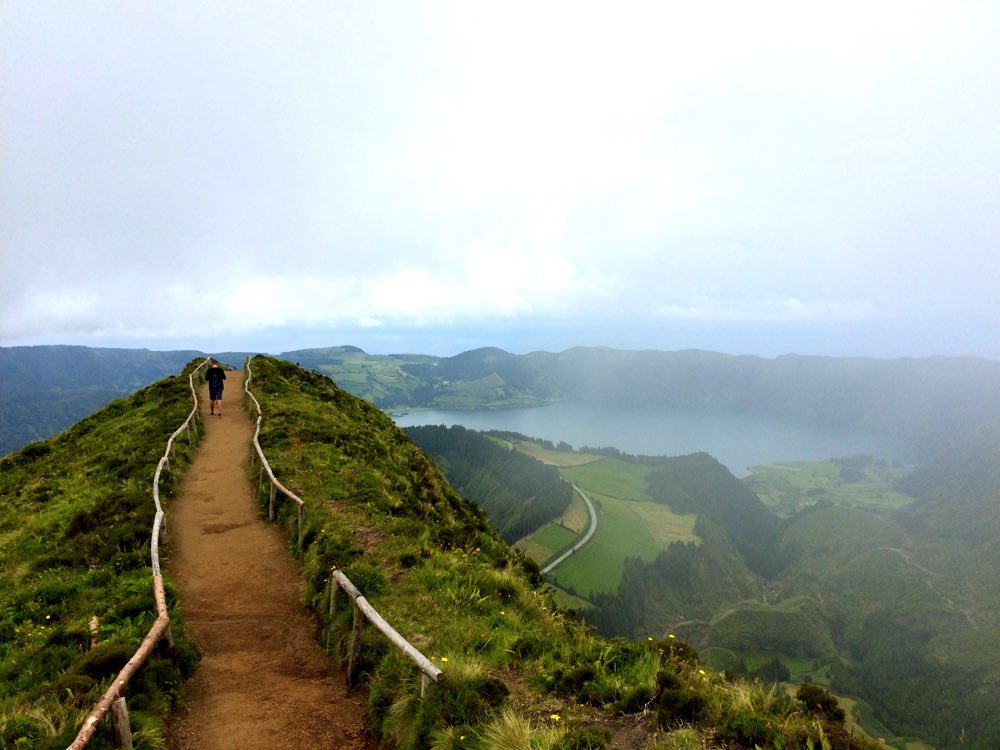
Hard to remain unbiased, because São Miguel island is the place where I was born. Located 1500km off the coast of Portugal, exploring the stunning lakes, mountains and cliffs in these volcanic islands is a truly unique experience.
I’ve put together a guide to help decide which islands to go and a compilation of all the things you need to know before going to Azores . Go while they are still a hidden gem.
19 Music festivals pop out like mushrooms.
Music festivals have become a huge part in the summer event calendar. And there are festivals for all kinds of musical tastes all across the country. MEO Sudoeste in Alentejo targets a younger crowds seeking electronic and pop music. NOS Alive and Super Bock Super Rock near Lisbon with more rock and indie vibes are amongst the most popular.
20 People will welcome you like true friends.
As a general rule, Portuguese are very nice and easy-going people. They will try hard to make you feel at home and this is more evident the further North you go in the country. You’ll learn that all we really care about is the sun, good food, a drink, and a good chat with friends.
21 Lisboa will keep you busy… and happy!
🇵🇹 PORTUGAL | 🙌 Archigasm. The new Museum of Art, Architecture and Technology opened a few months ago in Belém, just a few steps away from the river Tejo. It’s awesome to see Lisbon evolve into a modern and cool city with spaceship-like buildings! 👽 #Portugal #wintersun #architecture #museum #lisboalive #lisboa #Lisbon #lisbonlovers #portugaldenorteasul #visitportugal #portugal_em_fotos #instaportugal #portugal_lovers #portugal_de_sonho #super_lisboa #portugalalive #topportugalphoto #beautifulworld #wanderout #wonderfulworld #the_daily_traveller #aplacetoremember #places_wow #toplisbonphoto #worldtourists Uma foto publicada por BRUN🌎 (@bruno_mb) a Jan 5, 2017 às 10:26 PST
The second oldest city in Europe (after Athens!) is a trendy, cool and alternative hotspot right now.
With inspiring architecture, a bustling nightlife and stunning beach day-trips around , Lisbon is the new european obsession. If you’re planning to go, check out the 7 things to do there and my 3-day itinerary of Lisbon .
My top hotel recommendations in Lisbon ⭐
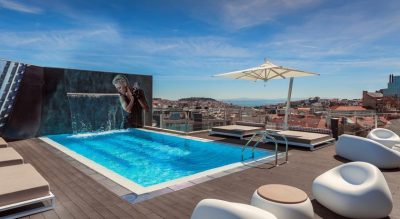
We Love F Tourists Located in busy Rossio – the heart of Lisbon – it’s just one of those amazing value places that will make you feel at home. Perfect to make friends. Book now
Or… find your own!
Use this list of quality hotels and guesthouses I’ve put together to get you started. ALL of these are located in the best central areas of Lisbon , with WiFi and with a rating of 8 or higher. Just pick your favorite!
22 The shellfish is to die for.
While you are in Portugal , prepare to taste the sea like never before. Like seafood itself, portuguese cuisine is fresh and comes in all sorts of delicious and original combinations. Clams, shrimp, lobster, crab and other kinds of shellfish and seafood is widely available. Salada de polvo (octopus salad) and Carne de Porco à Alentejana (pork with clams) are a must-try.
23 It’s a golf-friendly destination.
Okay, so my knowledge of golf is close to what I know about artichokes plantations in Egypt: zero. I don’t even particularly like it. All I know is there are close to 70 golf courses in the country – half of them classified as high standard -, especially in the Algarve area. If golfing is your thing, all the conditions are met for you to have a great time in Portugal.
24 You’ll learn to crave Francesinha.
Does the idea of a steak, ham, cheese sandwich with an egg on top and a gravy-based sauce seduce you? I guarantee this Porto’s specialty is unlike anything you’ve ever tried before. Tip: save it for lunch and have something light for dinner. For the sake of your arteries.
25 You can still find authenticity.

Despite recent years have broken all records in tourism, you can still expect many calm and peaceful places. Many authentic restaurants, shops, and experiences undiscovered my tourists remain authentic, particularly if you venture out to the interior of the country .
26 We don’t kill the bull.
I personally hate bullfights and it amazes me how it’s still a thing in the 21st century. That said, a good thing is that we at least we don’t kill the bull…in public.
Also, we have forcados : a group of men who challenge the bull directly, without weapon or protection of any kind. Because if you are going to mess with an animal, that’s the way it should be, right?
Don’t let the prices rise more. Book your accommodation in Portugal now!
27 óbidos is a journey in time..
This little town is encircled by a ring of medieval walls and shows off a rebuilt Moorish castle, now a rural hotel ( Pousada ). Wandering around the streets of Óbidos is quite an experience and if you pair with the International Chocolate Festival, it’s a double win. Don’t forget to try the local ginjinha , a cherry-infused liquor!
28 The world’s best aquarium is there.
Seriously, I’m not bragging. Recently, travellers from Trip Advisor elected Oceanário as the best aquarium in the world. If you don’t go for the couple of otters, the penguins or the huge main tank, the architecture of the building is a reason to visit by itself.
Lisbon is very trendy right now and hotels can sell out often. Book your hotel as soon as possible!
I’ve made your life easier and you can start your search with my pre-selection of hotels in Lisbon . This list only includes the top-rated reviewed hotels in the heart of the city, with WiFi included.
29 The nightlife is unique.
Like many other things, alcohol is also cheap in Portugal which makes it the ideal place to go both to celebrate something going on in your life or to forget your ex. In the big cities, the default is to go have a drink, chat and even dance on the street. The nightlight districts in Lisbon and Porto are Bairro Alto and Galerias , respectively.
30 There is a bakery in every corner.
There’s life beyond custard tarts in the bakery department too. Portugal produces incredible pastries and loaves of bread which I deeply miss here in Barcelona . I challenge you to enter one of the many bakeries and try to choose only ONE thing to eat. ONLY ONE.
[mc4wp_form id=”4137″]
31 We have big waves. I mean REALLY big waves.
Nazaré is a name you may have heard on the news. Garret MacNamara and others have surfed some of the absolute largest waves in the world there (30+ meters). Apart from an attraction for surfers and photographers, Nazaré is also the most traditional fishing village in Portugal, showing colorful traditions and of course, great fresh fish!
32 It has got almost one millennium of history.
Technically a country since 1143, Portugal has kept its borders untouched since then. It once was one of the most powerful countries in the world. During the Discoveries era, its empire spread out over South America , Africa , India and even Asia . This heritage alone is a reason to visit!
33 Neighborhood markets are fun.
Markets are the essence and beating heart of any town or city and Portugal is not an exception. Whether you go to the renewed Mercado da Ribeira in Lisbon, to the more classic Mercado do Bolhão in Porto or any other, you’ll have a great time in the middle of fresh fruit and vegetables, delicious restaurants and the yells of the vendors trying to catch your attention.
34 There are 1001 ways to cook codfish and they’re all amazing.
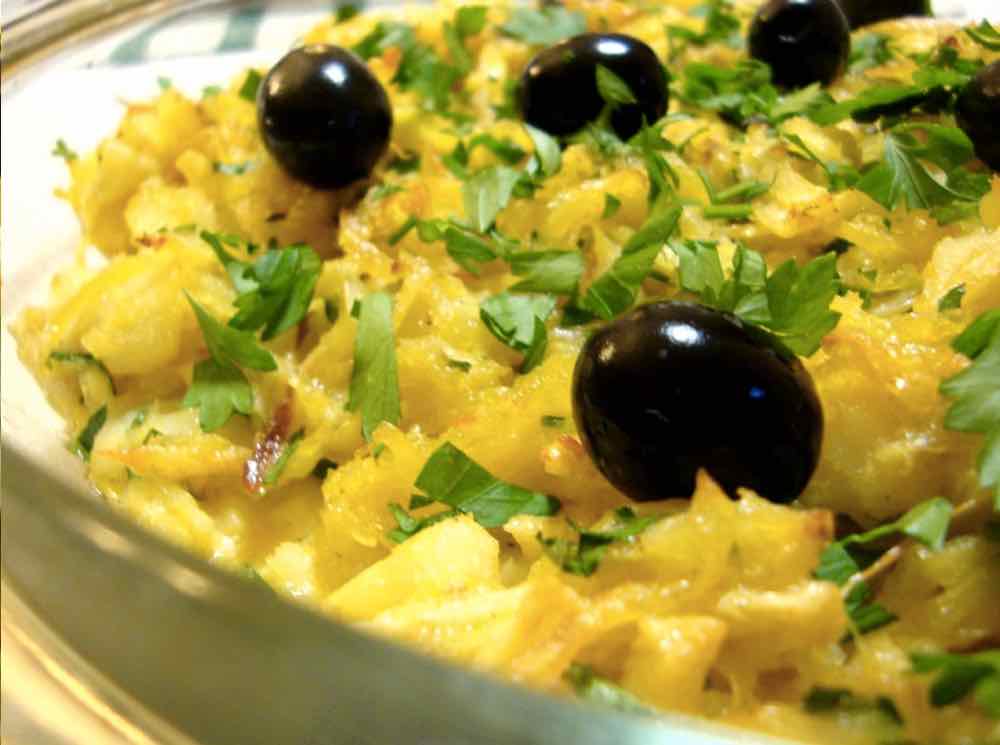
I know I’ve mentioned earlier, but the importance of bacalhau can’t pass unoticed. Even if you’re not a fan of fish, you’ll start loving it anyway. Codfish is Portugal’s national protein and we prepare it in the most diverse ways.
Try Bacalhau com Natas (with cream), Bacalhau à Brás (with scrambled egg and olives) and Bacalhau à Lagareiro (with olive oil and mashed potatoes) to start rediscovering this versatile fish in a delicious way.
35 Overall, food is cheap.
Once I start writing about food I can’t stop, but I seriously can’t stress how big this is in Portugal. I mean, the Portuguese may be the only people in the world that discuss over lunch what are they having for dinner. A traditional meal like one of the codfish dishes in the previous point or Arroz de pato (Duck baked with rice) in a decent, average-priced restaurant will never cost you more than 13 euros 15 euros (adjusted for 2024 prices).
In the northern part of the country, this drops to 10 or 12 euros (!). And I’m talking about the main Portuguese cities here. Check out my post about food in Azores too.
36 Alentejo’s coastline is a delight to the soul.
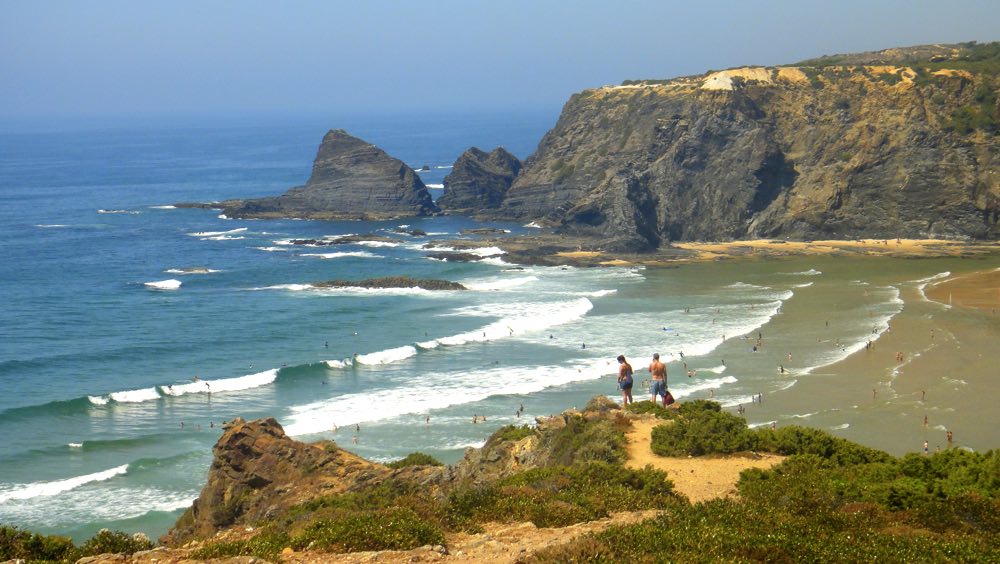
Man, I don’t know if it’s the Atlantic breeze or the easy-going lifestyle, but there’s something about the coast of Alentejo .
While the interior can get too hot in summer time, the coastline has a refreshing set of wild beaches and impressive cliffs that make a hell of a road trip . One of the best-kept secrets in Europe, if you ask me. Check out my selection of the best guest and rural houses in Alentejo .
37 The outdoor activities are just endless.
Mix a good climate with a diverse landscape and you’ll never want to be inside four walls in Portugal. Hiking the Paiva Walkways , levadas in Madeira island, paragliding in Serra da Arrábida or zip-lining in Gerês natural park are just some of the things you can do in Portugal.
If you’re up for a challenge, try climbing Mount Pico , the highest in the country. Don’t even get me started on water sports!
38 We are in the verge of three worlds.
Due to its strategic location as the western most country of mainland Europe in the confluence of the European, American and African continents, Portugal is directly connected by air to half of the world.
Portuguese culture has also been influenced by its old territories of Goa (India), Macao (China), Angola , Brazil or Cape Verde .
This means flights are usually cheap from half of the world , either from the Portuguese airline company TAP or from low-cost airlines that fly from Lisbon and Porto to most european cities for less than 100 euros.
39 It’s eye-catchy.
You’ll learn to appreciate the little details in Portugal. Clothes hanging on the windows of colorful buildings, intricate elements on Manueline style buildings, gorgeous sunsets in the sea, neighborhoods with narrow streets, you name it! For photography lovers, it’s hard to stop pushing the shutter button.

40 We are way more liberal than you think.
In the authoritarian and extremist world of today, an open-minded place can automatically be a reason to visit a country. Despite holding off to our deepest traditions, we are very forward-thinking in some other aspects. Same-sex marriages have been legal for years. Transgenders can easily change their gender. And while selling huge amounts of drugs is still illegal, drug use is admitted and – guess what – this has actually led to an decrease on the overall number of drug users in the country.
41 Algarve is perfect for sun-seekers.

Probably this is the Portugal you know better. This is where millions of tourists – including 95% of all Portuguese families – flock every year seeking the three Ss: sun, sea, and sand. Despite the summer crowds, the weather is fantastic and the beaches are renowned worldwide, specially around Lagos , Tavira and Portimão .
To get you started, check out my selection of the hotels with WiFi, breakfast and the best reviews in the region .
42 Portuguese know how to keep themselves going.
I’ve already mentioned wine, but the full Portuguese alcohol experience requires for you to try the alluring diversity of spirits and liquors. The most popular is probably ginjinha (cherry liquor) from Óbidos , but there many other flavours up to taste like moscatel (made from a special kind of wine) and my favorite, licor de amêndoa amarga (liquor made from bitter almonds).
43 Portugal’s birthplace.
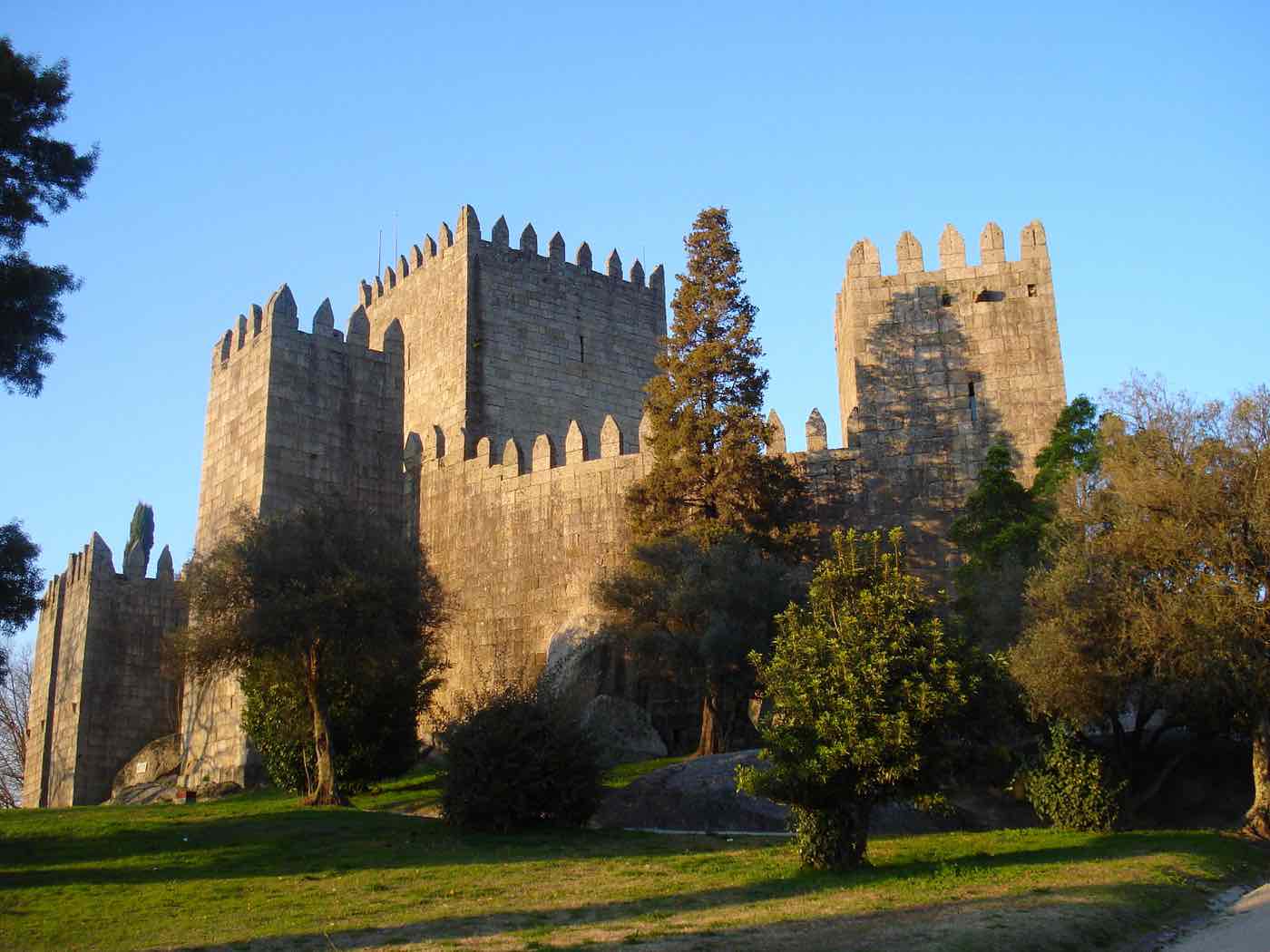
While sun seekers and beach bums may feel more attracted to the south and islands, for me Guimarães stands out more and more like one of the most underrated cities to visit in the whole country.
Nicknamed Portugal’s birthplace, due to the fact it was there D. Afonso Henriques – the first King of Portugal – fought his own mother (!) for the independence of the country. Drenched in rich history, with a well-preserved medieval town center, and with a fabulous-looking castle, Guimarães is a nice 1-day stop to your trip or easily doable on a day trip from Porto.
44 Venture out to the off the beaten track.
One might argue Lisbon and Porto have now fallen into every possible gentrification traps, just like Venice, Barcelona or Amsterdam. Whether you agree or not, there is a lot more to uncover in Portugal so consider adding some more unusual stops to your Portugal itinerary !
Venture out to the interior packed with villages in peace with the surrounding nature. Explore a whole different country without souvenir shops, Airbnbs every other door, or hipster brunch spots. But with still the same beautiful Portugal at heart.
Some off the beaten track places in Portugal
- Gerês National Park
- Serra da Estrela National Park
- Aldeias de Xisto
45 The oldest University in Europe is here.
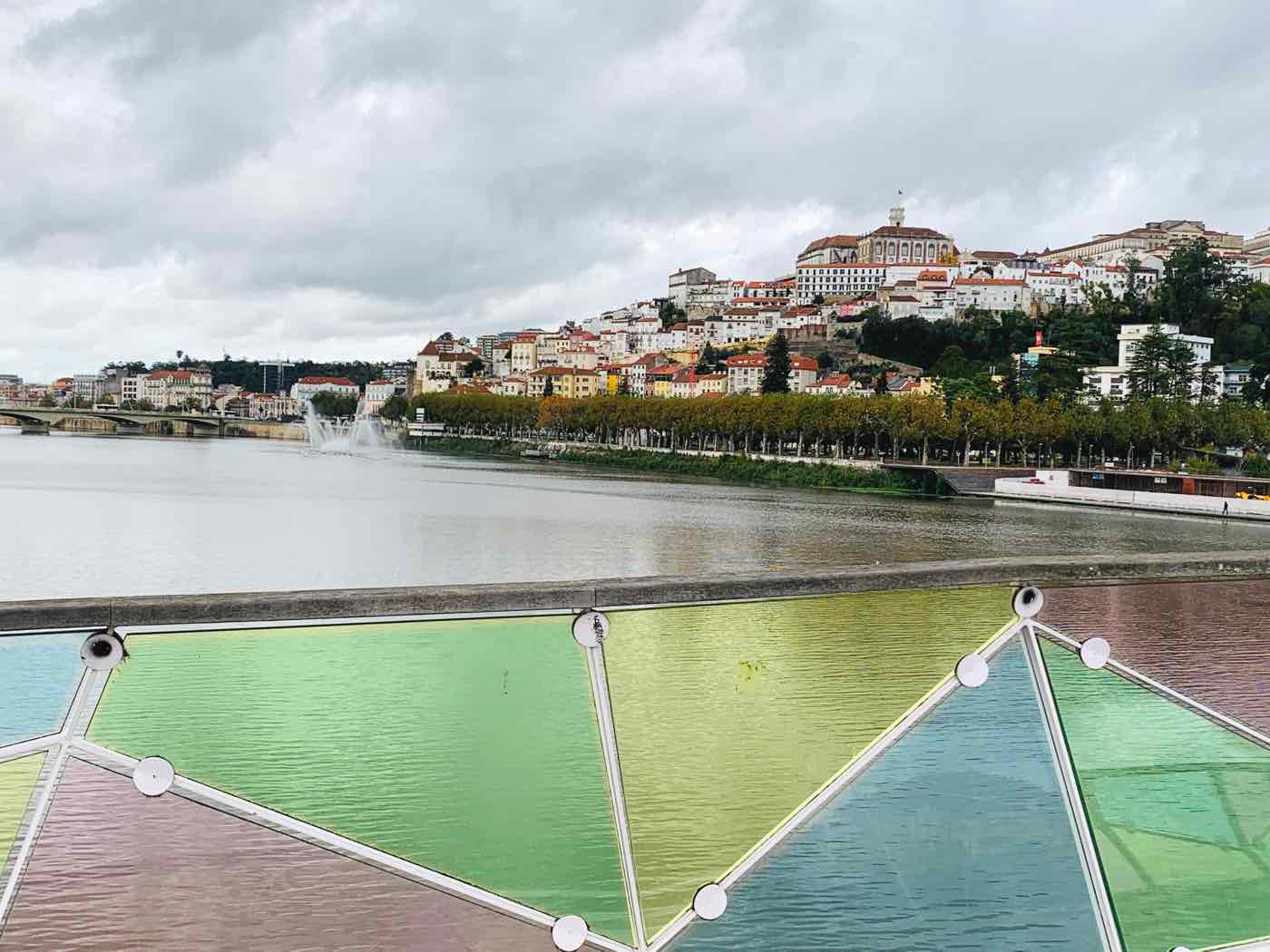
46 Madeira is a all-year round destination
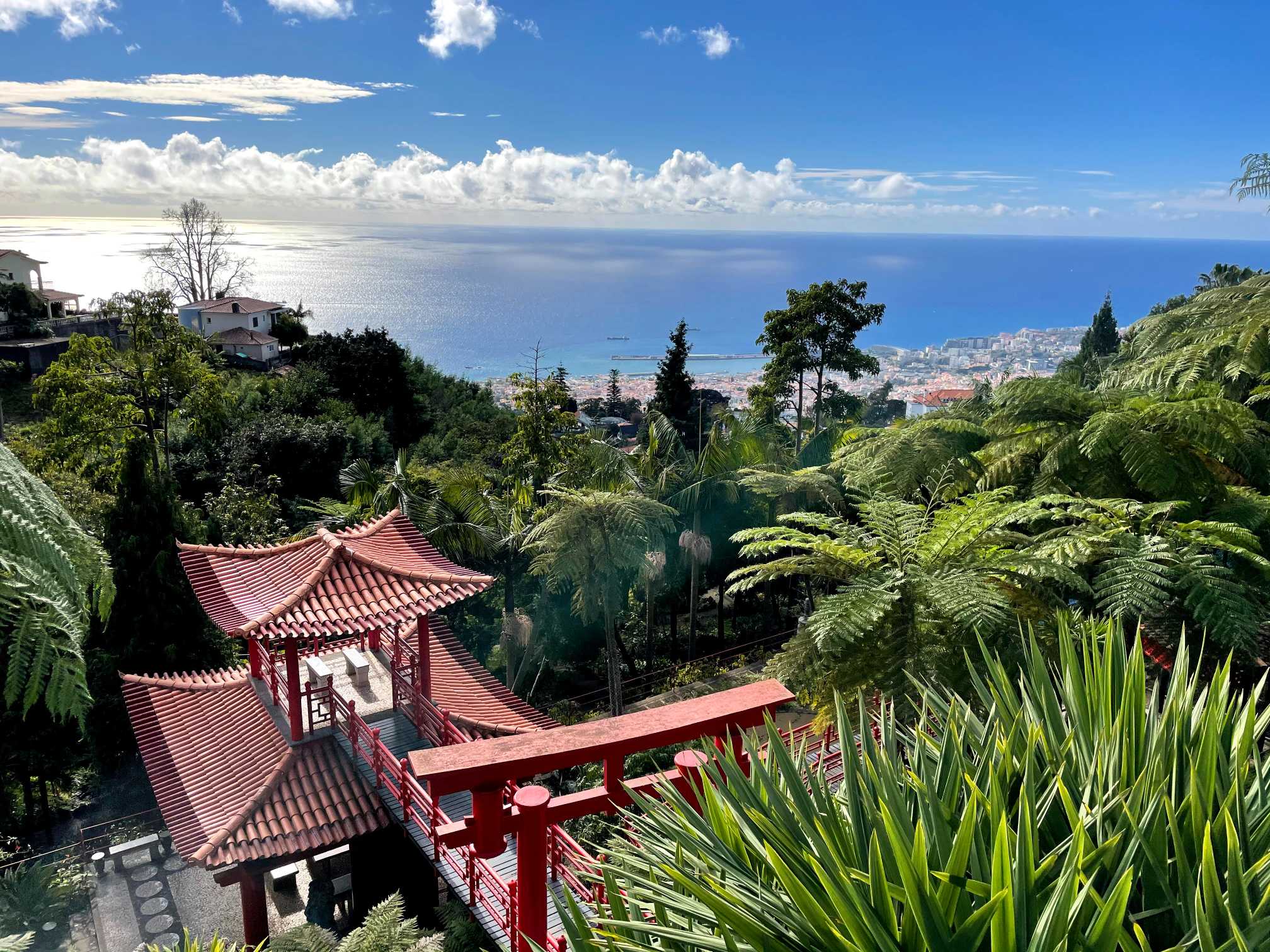
Known as the Pearl of the Alantic , the island of Madeira truly looks like a whimsical garden. Madeira is tropical, wild and has some of the most dramatic landscapes I’ve seen, but it’s all packaged with a mild weather throughout the entire year.
In Madeira, spring makes all the flowers in full bloom, summer is a great time for a swim in the ocean, Fall is perfect time to hit the levada trails and Winter is the time to escape the cold and enjoy the fantastic New Year Firework show in Funchal.
47 You’ll learn what saudade is.
After you’ve been to Portugal, something will grow on you. You’ll start missing the country and its people, weather and culture. Suddenly, a wave of nostalgia wins you over. Congrats, now you know what every Portuguese person feels when they’re away from home: saudade!
PORTUGAL MINI TRAVEL GUIDE
How to get to portugal.
The best way is by air. Lisbon and Porto are very well served by airline connections from all over Europe and also from the U.S., South America and Africa.
If you’re coming from the United States , take a look at Azores Getaways . They have great flight + hotel + transfers deals for Lisbon , Azores , Madeira and Porto . :
- Lisbon (6 nights), from 1149USD
- Azores (São Miguel) + Lisbon (6 nights), from 1149USD
If you’re not into travel packages or you’re not coming from the US, I recommend Skyscanner or the Google Flights to find the cheapest flight prices and my pre-selection of hotels below.
Where to stay in Portugal
To make your life easier, start your search with my pre-selection of the best hostels/hotels/guesthouses/villas for each of these amazing spots:
- Lisbon (heart of the city)
- Porto (heart of the city)
These include only accommodations with great-to-excellent rating and a good free WiFi . You can’t go wrong with these!
Best time to go to Portugal
While summers are long in Portugal and you can expect good weather anywhere between May and October, make sure you avoid August. Unless you have a thing for packed beaches!
Top places to visit
Personally, I always recommend Porto , Lisbon and Alentejo ‘s coast. If you are able to go to these three places, you’ll get a pretty great idea of what Portugal really is. They’re all memorable in different ways. Ideally, with a bit more time and money, hop on a flight to Azores for a few days for a true nature therapy.
What you MUST do
Eat a pastel de nata. Drink wine. Get some vitamin D in your skin. It does not sound like a hard life, does it? Relax, you’re in Portugal!
So, did I convince you visiting Portugal is a reeeaaaally good idea? If not, here’s this Portuguese water dog to make up your mind.

You might also like these articles 💬

Most Useful Japan Travel Apps in 2024

Japan Travel Tips: 34 Things to Know In 2024

Japan Two Week Itinerary: The Best of Japan!
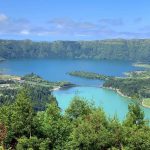
Destinations🌎


Turkey vs Portugal 0-3: UEFA Euro 2024 – as it happened
All the updates as Portugal cruise to a 3-0 win over Turkey in Group F of Euro 2024 in Dortmund.
This page is now closed. Thanks for joining us. These were the updates as the Portugal beat Turkey in Group F of Euro 2024 on Saturday, June 22:
- Portugal book their place in the last 16 of Euro 2024 after a comfortable 3-0 win over Turkey in Dortmund in the second match for both teams in Group F.
- Bernardo Silva scored his first goal in a major international tournament in the 21st minute when a cross from Nuno Mendes deflected off a Turkish defender and the Manchester City attacker smashed it in.
- Seven minutes later, Turkish defender Samet Akaydin scored an own goal with a comical mistake as passed the ball past his goalkeeper and it rolled into the net.
- Portugal extended their lead after substitute Ruben Neves set Cristiano Ronaldo free with a long ball and, after drawing in the goalkeeper, squared the ball for Fernandes who tapped in.
- The win lifts Portugal to first place in Group F on six points, three ahead of Turkey in second and five ahead of Georgia and Czech Republic with one game to go.
- You can follow all the Euro 2024 action on Al Jazeera’s dedicated tournament page and keep up to date with group standings and real-time match results and schedules .
- Live updates
- Match stats
It’s a wrap!
Thank you for joining us and I hope you enjoyed our live coverage.
We will be back soon. For now, it’s a goodbye from me, Manasi Pathak, on behalf of Al Jazeera Sport.
More to come from Al Jazeera Sport
Our live coverage of Turkey vs Portugal has ended.
We will be back soon for upcoming matches as more teams look to seal a place in the last 16.
You can keep up with all the news from Euro 2024 here .
Bernardo Silva was Player of the Match
🥇🇵🇹 UEFA Player of the Match for Portugal vs Turkey: Bernardo Silva. pic.twitter.com/YvwoUwy7Ye — Fabrizio Romano (@FabrizioRomano) June 22, 2024
Which teams have qualified for last-16?
Germany (Group A), Spain (Group B) and Portugal (Group F) have sealed their ticket to the round of 16 as respective winners of their groups.
The other three groups are still wide open. You can find all the standings here .

Portugal make statement with resounding win
After leaving it late against Czechia, Portugal sealed the result comfortably against Turkey.
They were creative in their attack, clinical in the final third, and made good use of Turkey’s errors to finish as winners.
Even though Ronaldo did not get on the scoresheet, he impressed the Portugal fans by being unselfish as he allowed Fernandes to score an easy tap-in for the third goal.

A day to forget for Turkey
Cheered on by their loud and passionate fans, Turkey made an electric start, thanks to their attackers.
But they lost their composure after conceding the first goal and lost the plot when Akaydin scored in his own net. The third goal in the second half was the final nail in the coffin.
The Turkish side will be disappointed with their performance, especially after they were super entertaining against Georgia in the last game.
The defeat keeps them second in Group F and they need to take a point against Czechia in the final group game on Wednesday to reach the last 16.
Full time: Turkey 0-3 Portugal
Portugal seal top spot in Group F and proceed to the round of 16 with a game to spare!
A first-half strike from Bernardo Silva, an own goal from Turkey’s Samet Akaydin and a second-half goal from Bruno Fernandes sealed a solid 3-0 victory for the 2016 champions.
Another invader on the field!
Guler takes a late corner for Turkey, but it’s headed away. Just before the kick, a fourth invader came near the post as a bunch of stewards got there to get the person off the field.
90+4 mins: Turkey 0-3 Portugal
Invader on the field
Calhanoglu barges into an onrushing Bernardo Silva, bringing the player down in the box.
Silva urges the referee for a penalty kick, but the official is not interested.
Meanwhile, yet another invader gets onto the field. This is possibly the third time.
90+2 mins: Turkey 0-3 Portugal
Five minutes added
Can Turkey find a consolation goal for their loud fans in the stadium? It’s been a disappointing day for them, especially after the team’s impressive win against Georgia in the last game.
90+1 mins: Turkey 0-3 Portugal
Chance for Portugal!
Bernardo Silva takes a shot from inside the box after a wonderful team move from Portugal, but the shot is cleared by a Turkey defender.
89 mins: Turkey 0-3 Portugal
Chance for goalscorer Silva
Bernardo Silva almost finds the net for the second time in the game, but the Turkey keeper comes off his line to collect the ball.
The City player was set up with a through ball by United’s Fernandes.
Meanwhile, Portugal make their final change, bringing in Joao Neves for Vitinha.
88 mins: Turkey 0-3 Portugal
Still no goals for Ronaldo
Ronaldo has had nine shots at the tournament this year – more than any other player – but the forward is yet to see his name on the scoresheet.
Earlier, he had the chance to score Portugal’s third goal, but was unselfish as he let Fernandes have the opportunity.
85 mins: Turkey 0-3 Portugal
Pepe walks off to a standing ovation from fans
The 41-year-old is withdrawn and replaced by Antonio Silva, who is half his age.
Just a matter of minutes before Portugal celebrate a victory in Dortmund.
83 mins: Turkey 0-3 Portugal
Goal difference vital for Turkey
If Turkey can find a goal in the final stages of the game without conceding, their goal difference will return to 0 (scored four, conceded four). It could prove to be crucial in tournament football.
82 mins: Turkey 0-3 Portugal
Corner for Turkey
Captain Calhanoglu launches a delivery in the box, which is headed away by Pepe for another corner.
Calhanoglu takes it again and once more, Pepe clears the danger with his head.
80 mins: Turkey 0-3 Portugal
Akaydin injured
Akaydin, who scored the own goal, looks to have hurt his stomach or side as he limps off the field.
He is replaced by Demiral.
75 mins: Turkey 0-3 Portugal

Neto impressive on left wing
Neto tries to set up Ronaldo in the box on two occasions but fails both times.
Nonetheless, he has been lively on the left flank for the 2016 champions.
72 mins: Turkey 0-3 Portugal
Guler comes on for Turkey!
Their star youngster is finally here.
He replaces Akgun.
70 mins: Turkey 0-3 Portugal
Third change for Portugal
On comes Semedo for Cancelo.
68 mins: Turkey 0-3 Portugal
Chance for Yilmaz!
A ball is played from the right wing for Yilmaz, who was charging towards the goal. But the Turkish forward fails to connect.
67 mins: Turkey 0-3 Portugal

Chance for Ronaldo!
Silva charges from the right wing and whips in a lovely cross inside the box for Ronaldo, who rises high but fails to direct his header towards goal.

Turkey struggling
Turkey substitute Yildiz tries his luck from 25 yards (23 metres) out, but his right-footed shot sails over the bar.
64 mins: Turkey 0-3 Portugal
Portugal look set for a last-16 spot
With 3-0 up, it is all but certain that Portugal will seal a win and proceed to the last 16 as group winners.
A goal from Silva and Fernandes and an own goal from Akaydin have kept the Selecao in a comfortable lead in Dortmund.
60 mins: Turkey 0-3 Portugal
Double change for Turkey
Turkey’s young gun Yildiz is finally on. He replaces Akturkoglu. Yuksek comes on for Ayhan.
58 mins: Turkey 0-3 Portugal
Who made it through from the EURO 2024 groups
Wednesday, June 26, 2024
Article summary
Who sealed a place in the UEFA EURO 2024 round of 16, either as group winners, runners-up, or one of the best third-placed teams?
Article top media content

Article body
The final set of UEFA EURO 2024 group games has been completed and the round of 16 ties are set. Here's how everything played out.
Who's through and who did not make the round of 16?
Through to round of 16 as group winners : Austria, England, Germany, Portugal, Romania, Spain
Through to round of 16 as group runners-up : Belgium, Denmark, France, Italy, Switzerland, Türkiye
Through to round of 16 as a best third-placed team : Georgia, Netherlands, Slovakia, Slovenia
Did not reach round of 16 : Albania, Croatia, Czechia, Hungary, Poland, Scotland, Serbia, Ukraine
The top two in each group plus the four best third-placed teams advanced to the round of 16.
Germany are through to the round of 16 as group winners.
Switzerland are through to the round of 16 as group runners-up.
Hungary are eliminated in third place.
Scotland are eliminated in fourth place.
Spain are through to the round of 16 as group winners.
Italy are through to the round of 16 as group runners-up.
Croatia are eliminated in third place.
Albania are eliminated in fourth place.
England are through to the round of 16 as group winners.
Denmark are through to the round of 16 as group runners-up (finishing ahead of Slovenia on disciplinary points).
Slovenia are through to the round of 16 as a best third-placed team.
Serbia are eliminated in fourth place.
Austria are through to the round of 16 as group winners.
France are through to the round of 16 as group runners-up.
Netherlands are through to the round of 16 as a best third-placed team.
Poland are eliminated in fourth place.
Romania are through to the round of 16 as group winners.
Belgium are through to the round of 16 as group runners-up.
Slovakia are through to the round of 16 as a best third-placed team.
Ukraine are eliminated in fourth place.
Portugal are through to the round of 16 as group winners.
Türkiye are through to the round of 16 as group runners-up.
Georgia are through to the round of 16 as a best third-placed team.
Czechia are eliminated in fourth place.
How teams are split when level on points
If two or more teams in the same group are equal on points on completion of the final tournament group stage, the following criteria are applied, in the order given, to determine their rankings:
a. higher number of points obtained in the matches played among the teams in question b. superior goal difference resulting from the matches played among the teams in question c. higher number of goals scored in the matches played among the teams in question d. if, after having applied criteria a) to c), teams still have an equal ranking, criteria a) to c) are reapplied exclusively to the matches between the remaining teams to determine their final rankings. If this procedure does not lead to a decision, criteria e) to i) apply in the order given to the two or more teams still equal e. superior goal difference in all group matches f. higher number of goals scored in all group matches g. lower disciplinary points total based only on yellow and red cards received by players and team officials in all group matches (red card = 3 points, yellow card = 1 point, expulsion for two yellow cards in one match = 3 points) h. position in the overall European Qualifiers rankings , or if Germany, the host association team, is involved in the comparison, drawing of lots
If two teams which have the same number of points and the same number of goals scored and conceded play their last group match against each other and are still equal at the end of that match, their final rankings are determined by kicks from the penalty mark, provided that no other teams within the group have the same number of points on completion of all group matches. Should more than two teams have the same number of points, the criteria listed under Paragraph 20.01 apply.
The situation stipulated in article 20.02 of the competition regulations (penalty kicks in case of perfect equality) cannot apply to any of the groups.
How the four best third-placed teams are decided
With reference to article 21.03, the results of the third-placed teams are compared based on their three group stage matches, according to the following criteria:
a. higher number of points b. superior goal difference c. higher number of goals scored d. higher number of wins e. lower disciplinary points total based only on yellow and red cards received in all group matches (red card = 3 points, yellow card = 1 point, expulsion for two yellow cards in one match = 3 points) f. position in the overall European Qualifiers rankings , or if Germany, the host association team, is involved in the comparison, drawing of lots
Once the four best third-placed teams were determined, article 21.05 of the regulations explains which third-placed team plays in which tie.
Selected for you

EURO 2024 match schedule

Every team's route to the final

IMAGES
VIDEO
COMMENTS
Start planning your itinerary now with our 11 favorite places to visit in Portugal. 1. Lisbon. Best for nightlife. Seven iconic hills overlook Lisbon 's postcard-perfect panorama of cobbled alleyways, white-domed cathedrals and grand civic squares - a captivating scene crafted over centuries.
20 Beautiful Places to Visit in Portugal — From Fairy-tale Castles to Charming Beach Towns. Take your pick of hilltop castles, sunny beaches, and time-worn villages.
The beautifully paved streets, historical feel, and annual cultural events make Tomar one of the best places to visit in Portugal. 8. Sintra. Balate Dorin/Shutterstock. Enthralling Sintra is a UNESCO gem that attracts tourists from all parts of the globe due to its incredible cultural landscape.
Things to Do in Portugal, Europe: See Tripadvisor's 7,908,807 traveler reviews and photos of Portugal tourist attractions. Find what to do today or anytime in July. We have reviews of the best places to see in Portugal. Visit top-rated & must-see attractions.
Places to Visit in Portugal. Explore popular experiences. See what other travellers like to do, based on ratings and number of bookings. See All. Nature and Wildlife Tours (1,063) Day Trips (1,516) Beaches (506) Whale Watching (70) Full-day Tours (2,418) Points of Interest & Landmarks (1,781)
Cruise the Douro River in Porto. Take a day trip to the splendid Pena Palace. Listen to Fado music in Chiado, one of the best things to do in Portugal for local culture. Tour one of the world's oldest universities in Coimbra. Take a stroll in the enchanting Bucaco National Forest. Drink Port wine in the Douro Valley.
3. Lisbon. Visit for: Buzzing city life, sandy stretches and a vibrant surf scene. Portugal's famously sunny capital, Lisbon requires little introduction - its status as one of Europe's ...
The 11 best places to visit in Portugal. Nov 17, 2023 • 7 min read. Beaches. 11 of the best beaches in Portugal. Nov 17, 2023 • 5 min read. Read more articles. in partnership with getyourguide. Book popular activities in Portugal. Go Beyond Portugal and beyond. Beyond Portugal. Lisbon. Porto.
6. Stargaze at Great Lake Alqueva. With cloudless skies most of the year and little light pollution, the artificial Great Lake Alqueva in Alentejo is one of Portugal's most perfect spots for stargazing. These extraordinary conditions made the lake the first official starlight tourism destination in the world, as certified by Spanish-based Fundación Starlight.
15. Serra da Estrela Natural Park. Spread over 100,000 hectares, Serra da Estrela Natural Park is a place of exceptional beauty. The first parque natural in Portugal and the largest of its kind in the country, it's a must-visit for hikers and nature buffs.
14. Peneda-Geres National Park. Lying in the northwest of the country on the border with Spain, Peneda-Geres is a lovely place to visit and is Portugal's only national park. Established in 1971, it protects precious landscapes and ecosystems as well as countless villages set in scenic and secluded spots.
8. Coimbra. Coimbra, on the banks of the Mondego River, was once Portugal's capital and has an Old Town that dates back to Moorish times. It's also a vibrant university town, with one of Europe's oldest schools, the University of Coimbra, classified as a UNESCO World Heritage site.
Cycling and walking in the Algarve. If you enjoy cycling and walking, then visit the Algarve and discover the vast network of routes and trails on offer in the region.Not only will you have an unforgettable experience but you are sure to have the sun for company because the Algarve (...) Find out more.
Lets explore the best places to visit in Portugal: 1. Coimbra. Source: leoks / shutterstock. Coimbra. Once the capital of Portugal, this quaint and charming town is a treasure chest of stunning gardens, historical sites, fado music, and dynamic culture. Located near the Mondego River in the centre of Portugal, Coimbra is a city of medieval ...
8. Coimbra Coimbra . The historic hilltop university in Coimbra is just one reason to visit this venerated Portuguese city. But the wealth of additional visitor attractions, much of them clustered around the Velha Universidade, classified by UNESCO as a World Heritage Site, merits a full day's sightseeing.. The undoubted highlight of a tour of the old university campus is the stunning ...
Portugal has become in recent years one of the most attractive places to visit in Europe and there are a myriad of reasons for this. Its fabulous wine regions, isolated islands, cool cities, charming towns, wild beaches, beautiful national parks, rich culture and history will make you want to stay more or revisit as soon as possible.
The Algarve region is the most beautiful area of Portugal. There are many beautiful places to visit in Portugal. But this particular coastline has some of the most breathtaking beaches and natural scenery in the entire country. There are over 100 unique beaches to explore across the entire Algarve region.
Day 4: Coimbra. Journeying south, your next stop is the city of Coimbra. The capital city of Portugal during the Middle Ages, Coimbra's greatest claim to fame is its distinguished university. One day is the perfect amount of time to see the city's main sights before moving on.
Hear traditional fado music at a live show with wine. Duoro Valley, wine tasting on a day cruise from Porto. 3. Take a cruise in the Douro Valley. The Douro Valley is one of Portugal's most beautiful places, and a Douro River cruise is one of the top things to do in Portugal.
Rick's Best Two-Week Portugal Trip (by Car) Day 1: Arrive in Lisbon (sleep in Lisbon) Day 2: Lisbon (sleep in Lisbon) Day 3: Lisbon (sleep in Lisbon) Day 4: Lisbon, or side-trip to Sintra by train (sleep in Lisbon) Day 5: Morning in Lisbon; in the afternoon, pick up car and drive 3 hours to the Algarve (sleep in Salema)
13 It's the ideal place to learn or master the art of surfing. If you are into surf, the wild uncrowded Atlantic waves, mild climate and the huge community of surfers and surf camps should easily seduce you. Nazaré, Peniche, Ericeira and all the coast of Alentejo are amongst the hot spots of surfing in Portugal.
All the updates as Portugal cruise to a 3-0 win over Turkey in Group F of Euro 2024 in Dortmund.
Portugal are through to the round of 16 as group winners. Türkiye are through to the round of 16 as group runners-up. Georgia are through to the round of 16 as a best third-placed team.
The final round of group games at Euro 2024 has concluded and the last-16 fixtures have been confirmed. These games take place from Saturday, June 29 to Tuesday, July 2; the quarter-finals are on ...